






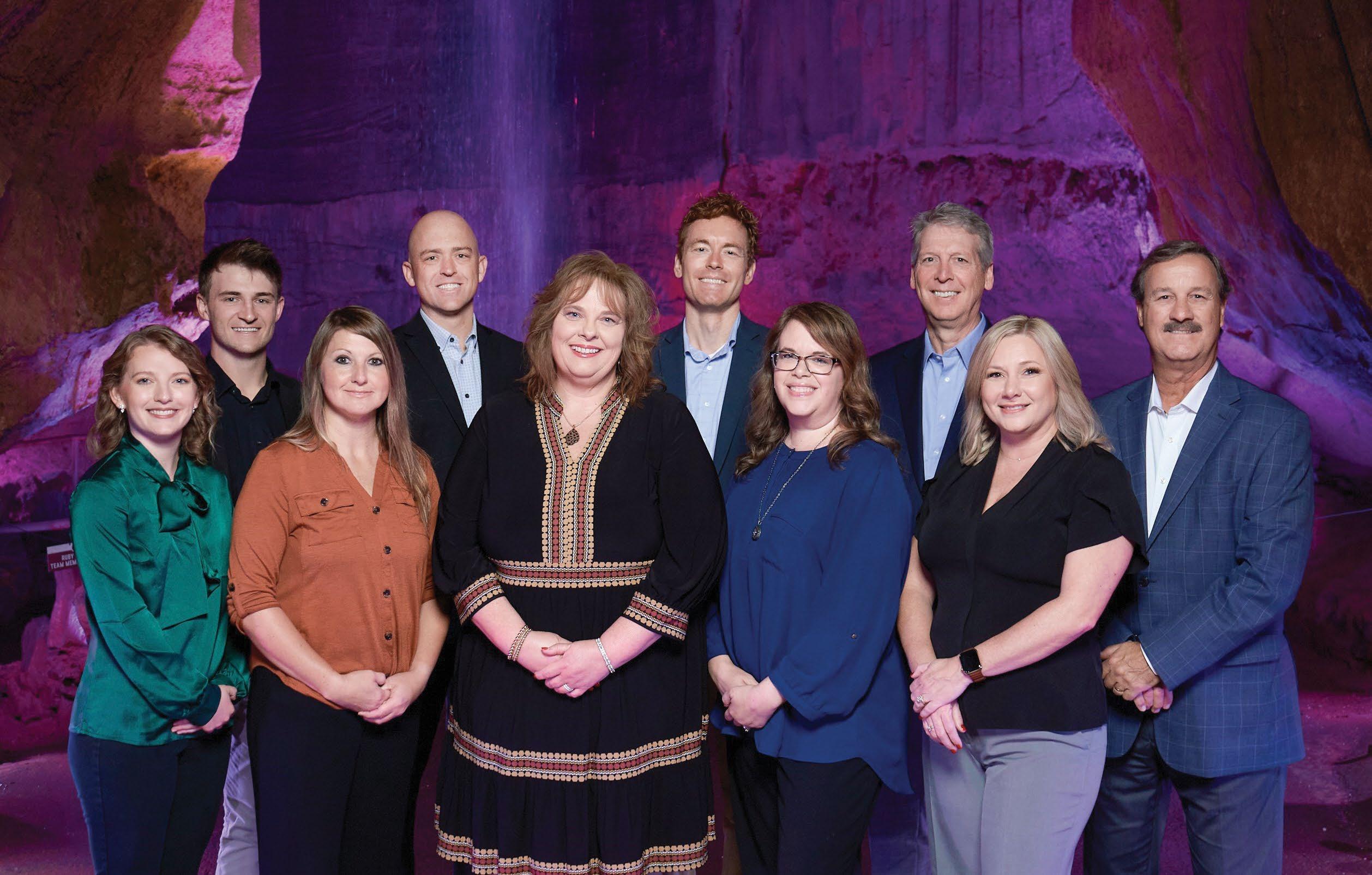
We’ve assembled a team of well-established and highly experienced financial professionals. It has given us the ability to address every aspect of our clients’ financial needs. And by limiting the number of clients we serve, it allows us to offer an uncommon level of service and maintain our unwavering focus on helping to create quality financial solutions.
TN 37421 Downtown Office, by appointment only: Warehouse Row • 1110 Market Street, Suite 210 • Chattanooga, TN 37402 www.RoundTableAdvisors.com • 877-770-0009 • 423-510-8889
This is what we bring to the table – and what will ultimately bring you to us. If you are an individual seeking seasoned financial guidance and the comfort of working with an experienced group of advisors who call Chattanooga home, we welcome the opportunity to sit down together. Main Office: 1200 Premier Drive, Suite 100 •







Resting on the cliff -edge of Lookout Mountain, The Keep delivers a golf experience unlike any other. With cascading waterfalls, ancient boulders, and sweeping mountain vistas, every hole off ers both a challenge and a stunning view. Come discover a course where nature and design unite in perfect harmony. To become
Now open for Preview Play welcoming Resort Guests and Friends of McLemore.



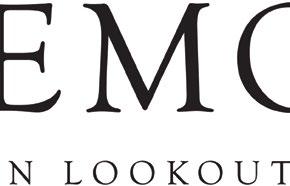

“Heaven is under our feet as well as over our heads.” - Henry David Thoreau
There is something so special about the South. Our landscapes are picturesque. We have lush rolling hills, fire-colored sunsets, and bubbling rivers that evoke fun and time spent with loved ones. The people who fill our area are warm, inviting, and led by morals and values that drive them to serve one another. The food we eat is vibrant, rich in flavor, and comforting. There is truly nothing like it.
In the Annual Southern Gentleman® Issue of CityScope® magazine, we celebrate all of these things and more by sharing the lifestyles of the South as told through the eyes of local Southern gentlemen.
Starting with sports and outdoors, we delve into the many outdoor adventures the Scenic City has to offer. “In Full Flight” highlights local plane owners and their incredible adventures, while “Fore!” features local men who have forged lifelong friendships around the game of golf. More topics await, including archery and rowing, plus “Man’s Best Friend,” where loyal hunting companions take center stage.
Next, in the lifestyle section we highlight model building enthusiasts, metalworkers, and those who find enjoyment in collecting. A true embodiment of our area, the article “Making of a Gentleman” features five local men who share the morals and values that guide who they are today. Not to be missed, “Southern-Style Homes” highlights actively listed properties that boast mountain views, spacious land, or Southern design.

Nothing says Southern hospitality quite like a home-cooked meal. Our food and spirits section includes sweet and savory biscuit recipes sure to delight, as well as dip recipes for feeding a hungry crowd and tips on styling spirits. Whether hosting friends, grilling for family, or simply cooking for one, the special section “Fit for a Chef” features kitchens and kitchen essentials perfect for whipping up a five-star meal. Last, but certainly not least, the South has style. Check out features “Impress With Prints & Patterns” and “Elevated Essentials,” which present stylish selections from local clothiers and retailers.
As always, we hope you enjoy this Annual Southern Gentleman® Issue of CityScope® magazine and that it brings about a sense of appreciation for our area and the wonderful people who fill it.
Happy reading,
Cailey Mullinix Easterly Co-Publisher
P.S. Follow CityScope® and HealthScope® magazines and Choose Chattanooga® – Chattanooga Resource & Relocation Guide® on social media!

EXCLUSIVELY AT

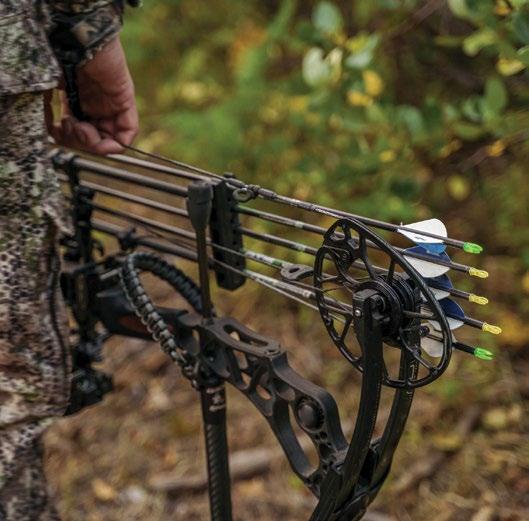





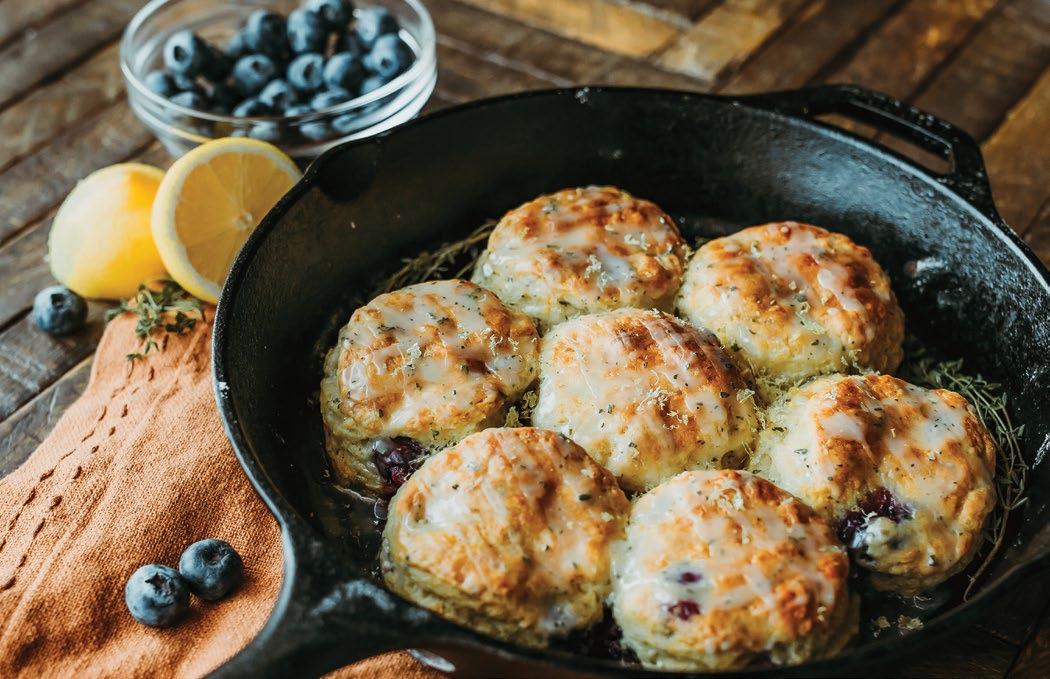

First row, left to right: James Phillips, CFP®, Kellye Phillips, CFP®, Betsy Gibson, CFP®, Scott Chadwell, Greg Costello (Complex Manager), Debbie Brown, Mike Brown, Mary Loggins, CFP®
Second row, left to right: Emerson Brown, CFP®, Greg Reabold, Joe Johnson, Tyson Asay, CFP®, Chuck Corey, Robin Moldenhauer, Steve Carlson (Branch Operations Manager), Jennifer McIntyre
Third row, left to right: Tena Kellis, Barton Close, CFP®, John Grzesiak, CFP®, Darin Hurley, CFP®, Kyle Cooper, Michael Cooper, Brad Perkins, Bob Klose, CFP®
Not pictured: Doyle Attaway, Walter Stamper

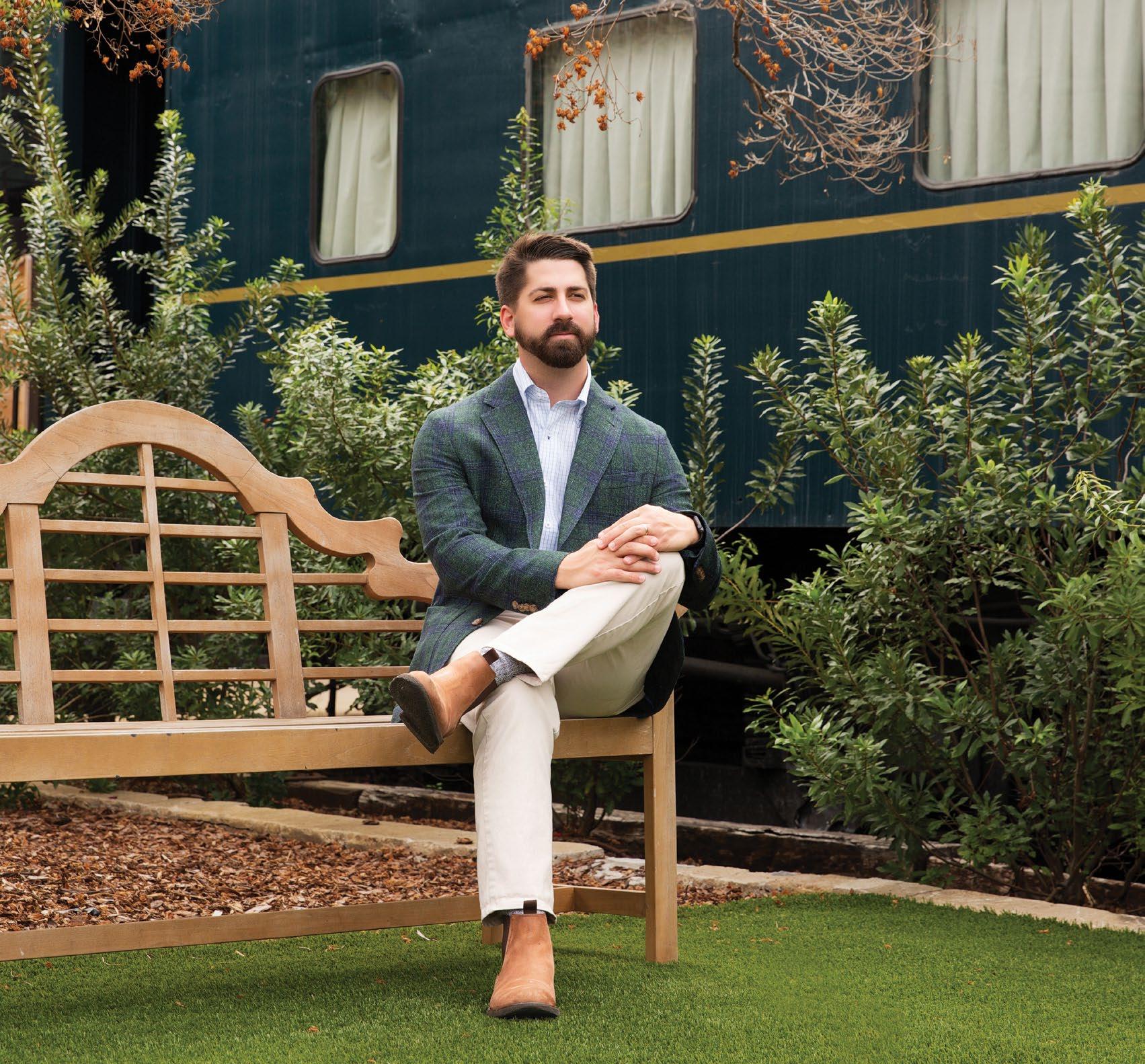
168 Impress With Prints & Patterns
Showcasing Sophisticated Styles
178 Elevated Essentials Elegant Accessories From Local Retailers


Publisher George Mullinix
Co-Publisher Cailey Mullinix Easterly
Sales & Business
Development Amanda Worley
Design Lead,
Sr. Graphic Designer Lauren Robinson
Sr. Graphic Designer Tamara Slocum
Managing Editor Rachel Studebaker
Editors Gray Bennett Kristen Dee Tory Irmeger
Editor/Digital
Content Specialist Ali Lemmons
Director of
Digital Marketing Ruth Kaiser De Backer
Digital Marketing Assistant Houston McLain
Digital Marketing Specialist Katie Faulkner
Digital Marketing Intern Bryan Hunt
Marketing, Events, & Operations Laci Lanier Jackson
Photographers
Anh Bao Tran-Le Corey + Emily Critser
Dan Henry Hacker Medias
Kristina Armstrong Rich Smith
Vityl Media
Subscribe to CityScope® or HealthScope® magazines: Call 423.266.3440 or visit cityscopemag.com or health scopemag.com and click “Subscribe.” A one-year subscription for CityScope® or HealthScope® magazine costs $18.
To receive advertising information, change your mailing address, or share your views on editorial: Call 423.266.3440 or visit cityscopemag.com or healthscopemag.com and click “Contact.”
Avid

CityScope® and HealthScope® magazines and Choose Chattanooga® – Chattanooga Resource & Relocation Guide® (the magazines) are published by CMC Publications, LLC, a Chattanooga, Tennessee company. Reproduction in whole or in part without written permission is strictly prohibited. Views expressed herein are those of the authors or those interviewed and not necessarily those of the publisher, editors, or advertisers. The publisher, editors, and advertisers disclaim any responsibility or liability for such material. All content associated with and included in advertisements (ads, advertorial, and special promotional sections) placed in the magazines are the responsibility of the respective advertiser. CMC Publications, LLC, cannot and does not assume responsibility for any material contained within or associated with any advertisement.
CityScope® magazine
Copyright, CMC Publications, LLC, 1993
CityScope® magazine is a registered trademark owned by CMC Publications, LLC.
HealthScope® magazine
Copyright, CMC Publications, LLC, 1989
HealthScope® magazine is a registered trademark owned by CMC Publications, LLC.
Choose Chattanooga® –
Chattanooga Resource & Relocation Guide®
Copyright, CMC Publications, LLC, 2011
Choose Chattanooga® and Chattanooga Resource & Relocation
Guide® are registered trademarks owned by CMC Publications, LLC. Choose Chatt™ and Chatt Choices™ are trademarks claimed by CMC Publications, LLC.
CityScope® magazine Southern Gentleman® is a registered trademark owned by CMC Publications, LLC.



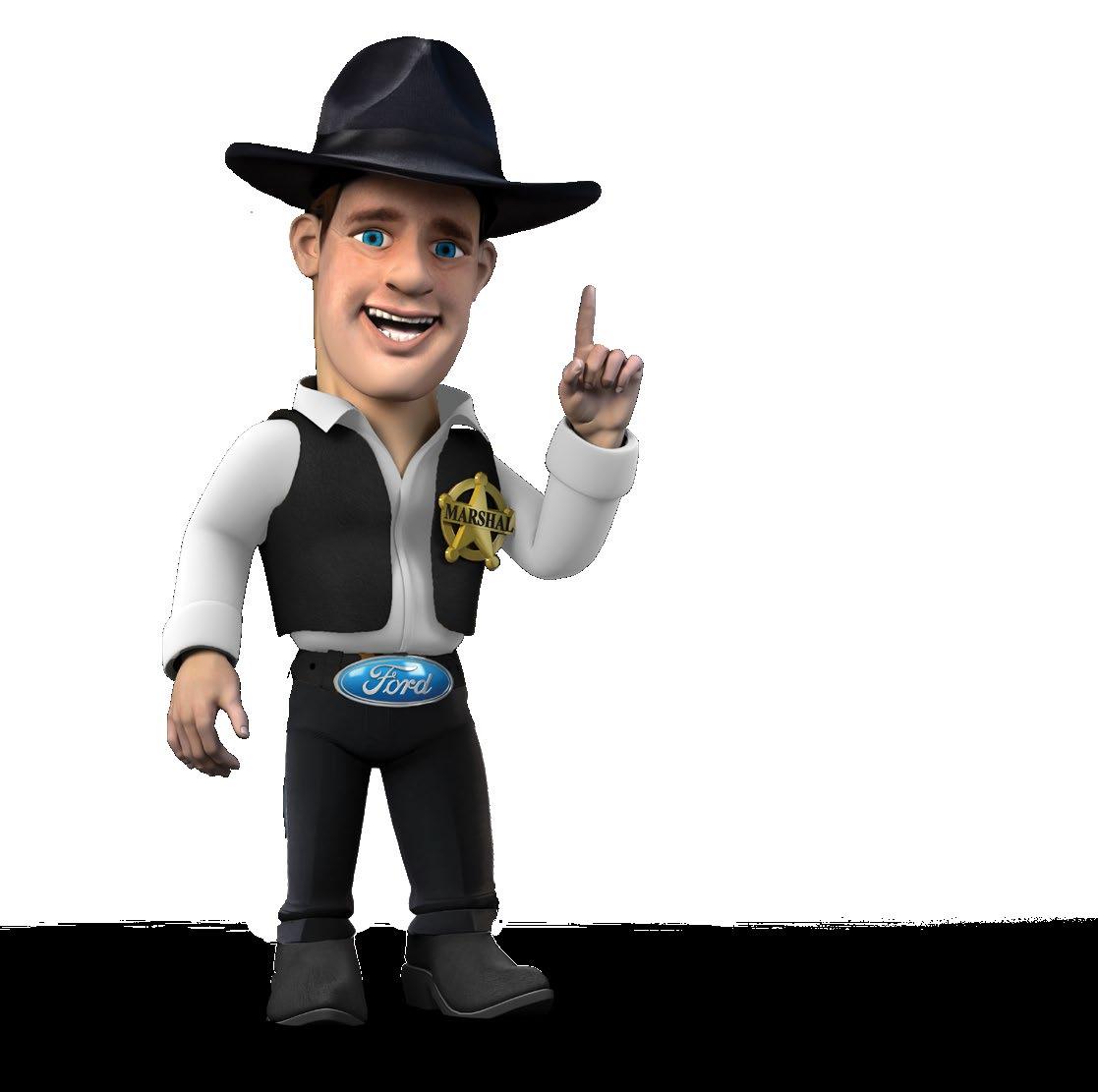









“I GO TO NATURE EVERY DAY FOR INSPIRATION IN THE DAY’S WORK.” –FRANK LLOYD WRIGHT

“The sky is the limit only for those who aren’t afraid to fly!” – Bob Bello
Pilots experience the world from a distinctly different perspective. From up above, limits fall away, adventure awaits, and peace abounds for those who dare to look for it. Read on to learn more about four local Chattanooga pilots and their incredible stories from the sky.
By Gray Bennett / Photography by Rich Smith

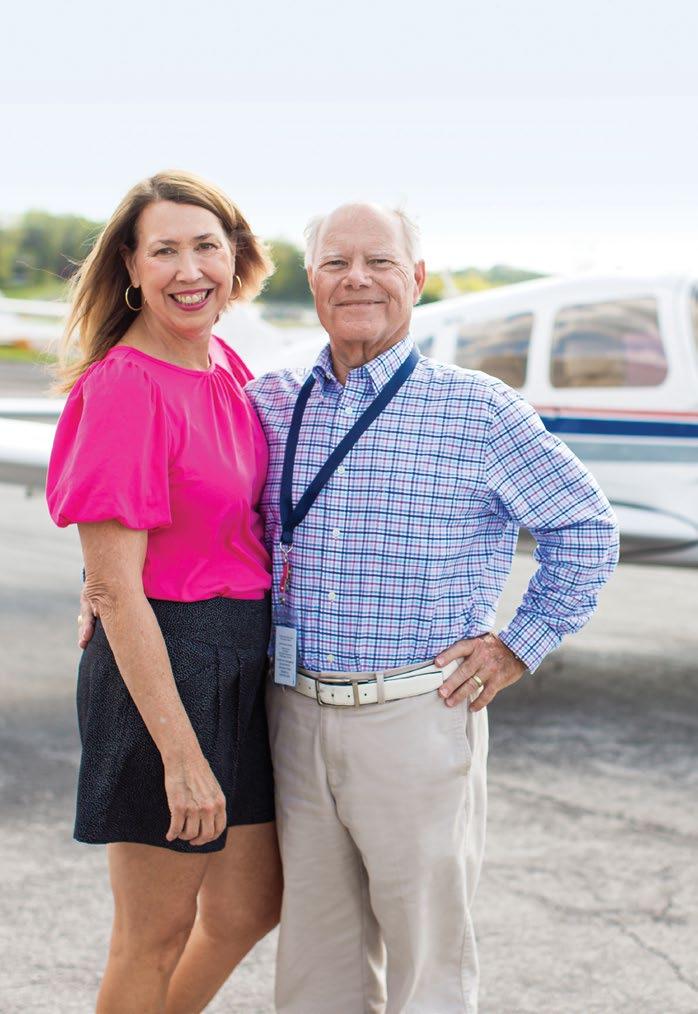

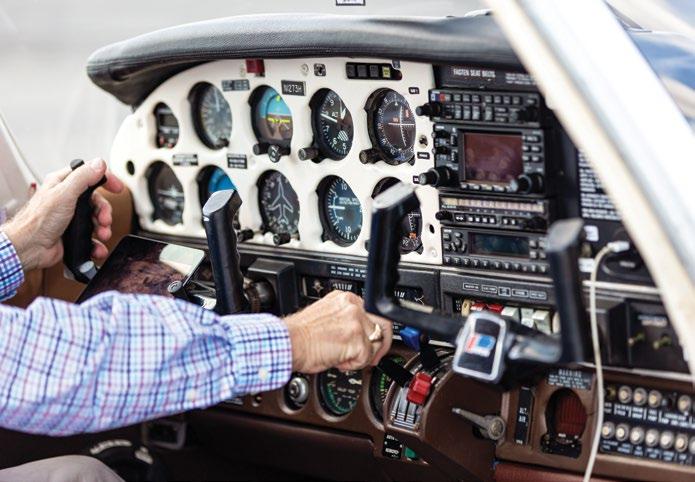
In1975 at the University of Tennessee at Chattanooga, a desire to fly sparked in Robert Crabtree. He took to the sky with one of his licensed friends, and for a thrilling moment, his friend let him take the controls.
“I had a blast,” he says, reminiscing about the experience. “Nowadays, I love to take friends up, especially the ones who have never flown in a small airplane. I let them have the controls, so they can experience the same feeling I had years ago.”
With company or flying solo, his current plane – a Piper Turbo Arrow III – has all the features he loves for a comfortable flight. A roomy interior with leather seats makes the cabin welcoming for any guests, while its efficiency and range make it well suited for cross-country travel as well as shorter trips to visit his grandkids in North and South Carolina.
Crabtree notes that it is “priceless” to be closer to his grandkids because, more than anything, a love for connection is at the core of his passion for flying. Even the plane’s nickname has special sentimental meaning. Lovingly nicknamed “Bobcat,” the plane gets its name from a combination of his and his wife Catherine’s name. This sweet tribute to
their relationship is a reminder that new memories with loved ones are always just a flight away.
When asked about his most memorable flight so far, Crabtree shares the story of a special flight that turned into an adventure no one would have expected. “A few years ago, our 92-year-old aunt in west Tennessee was to come to Chattanooga for a visit,” he explains. “Her ride didn’t work out, so I got to be the family hero by flying her here. Oh, I made her fly the airplane, too. Got pictures to prove it.”
From fun excursions with family and friends to the occasional golf trip, each adventure is a chance for Crabtree to “enjoy the mental challenge” of piloting and the simple beauty of the world from up above. Every flight is an opportunity for him to be that college kid again, rediscovering the thrill of flying for the first time with a good friend.
“I’d like to help dispel the belief that flying is dangerous,” he says. “With proper training and preparations, flying can be very safe, rewarding, and statistically safer than your car. Besides that, it’s really fun, and I encourage everyone to take a ‘discovery’ flight from a reputable organization if you’ve never flown in a small aircraft.”


Linda and Lee were outstanding! From our first visit to Chattanooga through our home buying experience to helping with renovations they have been one of a kind!
Dr. Carter & Anna Galbraith North Chattanooga



Linda Brock and Lee Brock are absolutely amazing at what they do! They are super organized, very responsive, and keep the entire process on track.
Lisanne McDearman Mountain Shadows
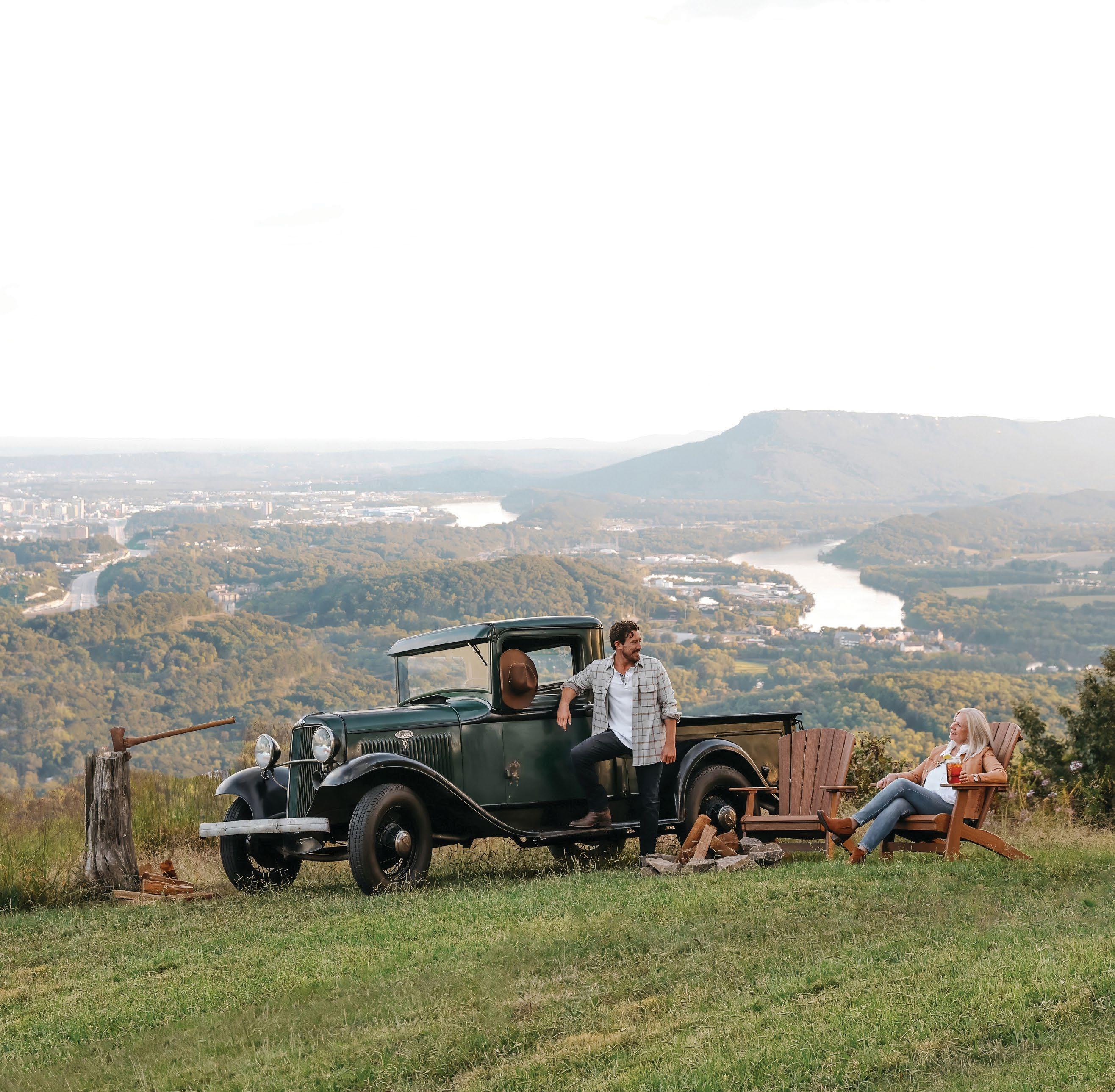
Following several home purchases with Linda, she is, without a doubt, our go-to resource in the Chattanooga area.

We bought two homes with Linda and she is the best Realtor we’ve ever worked with. Contact her or Lee first!
Dr. Aditya Mandawat Emerald Valley
Jane & Brad Elliott Waterfront

Linda Brock and Lee Brock are dynamic real estate professionals with vast experience in the Chattanooga market.
Blanche Nicoll North Chattanooga

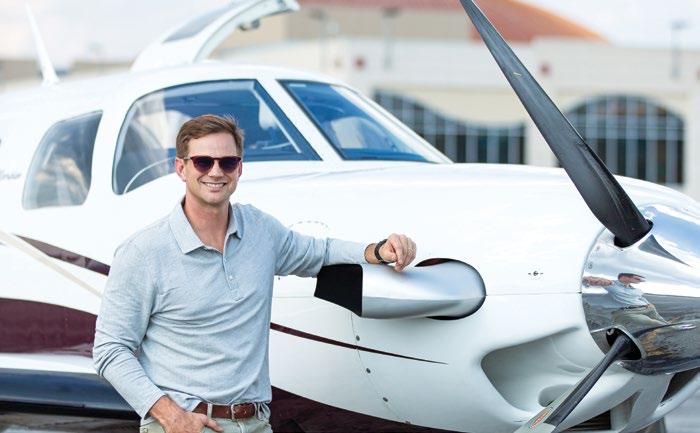


Flying takes determination. The regimented training that piloting requires might intimidate some, but others like Cam Doody thrive on the challenge.
“Recurrent training and vigilant preparedness are therapeutic for me,” Doody explains. “Funny enough, it's the only part of my life where I love the rigidity of rules. As long as I follow the rules of air traffic control and the FAA, I have full freedom to go where I want when I want. It's the ultimate freedom through rigidity.”
Doody recalls being “completely hyper-focused” during his first flight with his dad at 12 years old. He started his flight training at 19 years old, earning his private pilot license only eight months later. Now, at 38, the journey of aviation still feels as endless as the sky.
“There is always more to learn, more to train on, and planes to fly faster and higher,” he shares. “It's a rabbit hole that never ends, and I hope to follow it as far as I can go.”
Today, Doody holds private and instrument certificates with endorsements for tailwheel, aerobatics, high-performance, complex gear, and high-altitude operation. He has flown a wide variety of piston singles like Cessnas (150, 152, 170, 182s), Cirrus SR20, SR22, Maule MT-235, Piper Super Cub, Super Decathalon, AC Citabria, Aviat Husky, and Beechcraft Bonanzas.
His current plane is a Piper Meridian P46T. This pressurized, six-seat aircraft is powered by a Pratt & Whitney PT6 turbine engine. With a cruise speed of 280 knots (322 mph) and a service ceiling of 28,000 feet, Doody rightfully refers to it as “a beast.”
When it comes to his family, he also calls the Meridian “a time machine.” Not only does the aircraft allow his family to travel farther in shorter periods of time, but it’s also a constant reminder of his favorite flight. “Thirteen years ago, I proposed to my wife, Hannon, in my dad's first plane, N22AC,” he explains. “There will never be a better flight than that!”
Cam and Hannon Doody now have two young daughters who call the plane “Bravo Romeo.” Together they bring their father’s love for aviation full-circle as they take turns flying co-pilot with him. In a beautiful way, it brings him all the way back to the beginning of his aviation journey.
“As kids we’re told we can do anything we put our minds to,” Doody says, “but the moment my wheels left the ground during my first solo was exactly the moment I understood that. I remember every vivid detail of that day ... the smell, the clothes I was wearing, the first thing I ate afterwards ... everything. Flying allows us to get places and do things we couldn't otherwise do, and that's why I love it.”


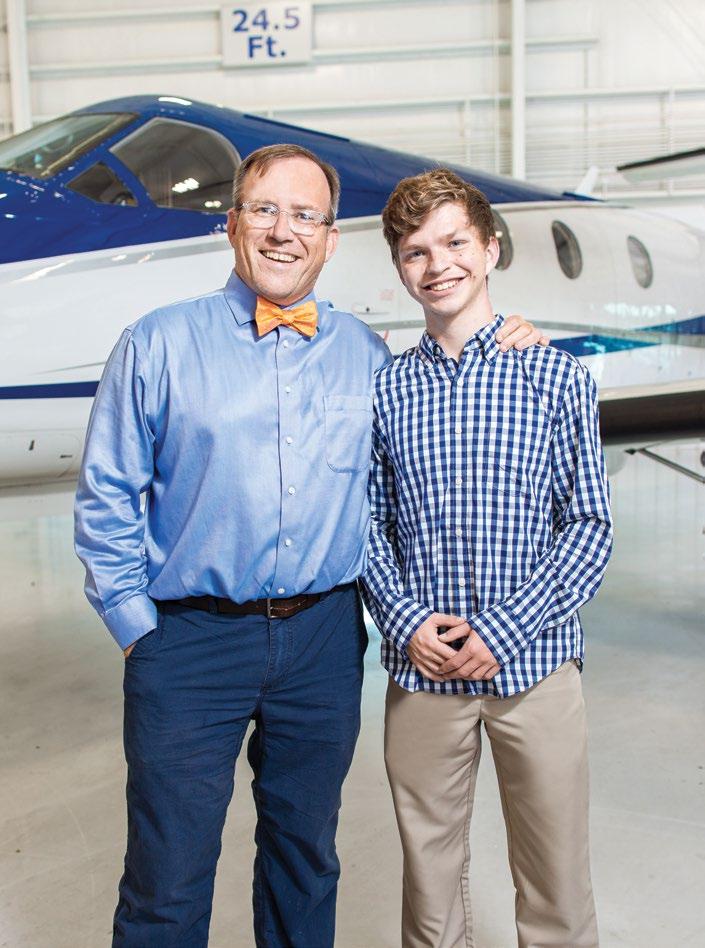
TaylorNewman is no stranger to the business of operating and managing aircraft. In fact, as the director of operations for Crystal Air, Inc., Newman leads the largest aircraft fleet in Southeast Tennessee.
His childhood, full of dreams about space and becoming an astronaut, paved the way for his future career. After realizing that 20/20 vision was required for entering into a military pilot career in 1991, his visions of outer space adventure took a turn. He opted to start civilian flight training in college and never looked back.
“My wife and I employ about 33 people,” shares Newman. “About eight of them fix what I break, a few people are in the back office, and then there are about 20 pilots in various parts of their career.”
With a great team and 21 aircraft to manage, Newman has no shortage of memorable moments to share. He and his friend James Howard have had several adventures, including setting a world record time on a flight from Port Angeles, Washington, to Chattanooga (17 hrs. 47 min. 49 sec.), transporting a red panda to the Chattanooga Zoo from Idaho Falls, Idaho, and completing several life-saving organ transplant flights for various hospitals.
One of the aircraft he currently operates is a Pilatus PC-12. He calls it a “tremendous workhorse,” noting that it can car-
ry up to 4,000 lbs. of fuel and people. It has a cruise speed of 260 knots (300 mph), and its maximum range extends to 1,765 nautical miles. In terms of special mission capability, the aircraft can take on a variety of assignments from medical assistance to cargo transport, making it reliable and incredibly versatile for any impromptu flights.
While he does fly primarily for business, he notes that his family does enjoy taking to the skies with him whenever time allows. Some of his favorite memories include vacation trips across the country, the occasional “Saturday morning flight to a local pancake breakfast,” and training flights with his 16-year-old son Cole.
He also recalls an especially meaningful final flight with his father. “We took a ‘father and sons flight’ to the Ford Museum in Detroit last year,” he explains. “My dad had always wanted to go, so my brother, our sons, and our dad made a day trip to the museum last year. My dad passed away June of this year, so that’s the last flight I had with my dad on board.”
Special memories like these touch the heart of his passion for aviation. Whether with family, friends, fellow pilots, or valued customers, every flight is a chance for Newman to savor the peace, tranquility, and beauty of the world from up above with the people he cares about most.

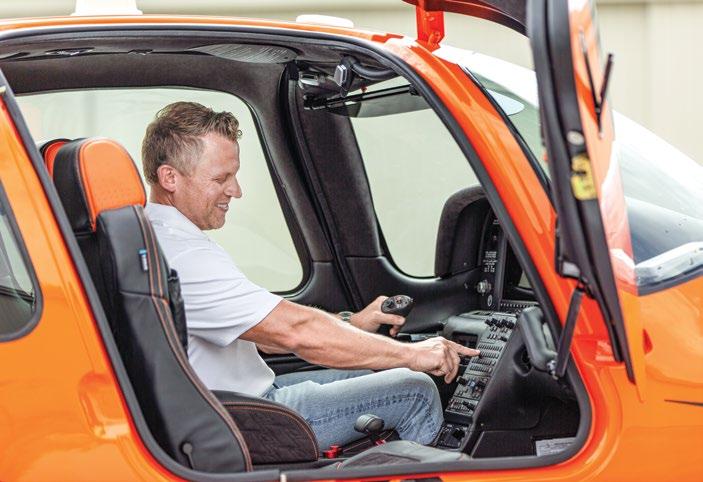

Twenty-five years ago, a small aircraft landed on a mountaintop in Alaska, and Chad Haney knew from that moment he wanted to get his pilot license.
He started his flight training in a Cessna 172 in 2019. The experience was exactly what he hoped for, full of challenge and a new sense of freedom. He earned his private pilot license the same year, and flying seamlessly became a regular part of his day-to-day life.
Today, Haney flies primarily for work. He travels frequently all around the Southeast – about two to three times a week – to meet with possible acquisitions and visit other branches of his business, Lookout Pest Control.
His current plane, a Cirrus SR22T, rises to the challenge of his busy schedule. This aircraft has a cruise speed of 203 knots (234 mph) and a service ceiling of 25,000 feet. He notes that Cirrus “has always equipped their planes with the most up to date avionics in addition to the parachute safety features,” which gives this aircraft an extra layer of reliability.
Another unique detail about the plane is its limited-edition paint scheme and interior. Part of the Cirrus 9000th Limited Edition SR Series, the aircraft was made to commemorate 9,000 SR Series aircraft deliveries and highlight the adventurous
spirit of personal aviation. Haney’s plane, sporting a bold orange shade called “lava,” is one of only 10 planes that are identical to it.
When asked about what he enjoys most about flying, Haney shares that flying gives him more time to enjoy with the people who matter most to him. “Flying an airplane allows me to travel for business and be back home to my family in the same day,” he explains. “It also allows my family to enjoy long weekend trips that most likely would not be possible if we had to drive.”
With his wife and three kids in tow, family trips make for sweet memories when time allows. Haney says that one of his favorite travel destinations, The Bahamas, is incredible to see from the sky. Soaring over vibrant blue water and gorgeous scenery gives him a sense of peace and reminds him that even the most beautiful destinations don’t compare to the gift of family.
Through every flight, Haney shares that grit, freedom, and quality time with loved ones fuel his passion for aviation. Whether he’s taking a mid-week trip to Kentucky for work or hopping in the plane for a long weekend in Florida, flying empowers him to take control of his time and embrace adventure in the moments that truly count.











GENTLEMEN’S GOLFING GROUPS
By Ali Lemmons

F or many, golf isn’t just a game – it’s a time to decompress, get outside, and perhaps most importantly, spend quality time with a great group of friends. This is especially true for these five Chattanooga locals. From as little as three years to as long as five decades, these golfing groups know how to have a tee-rific time while they hit the green.
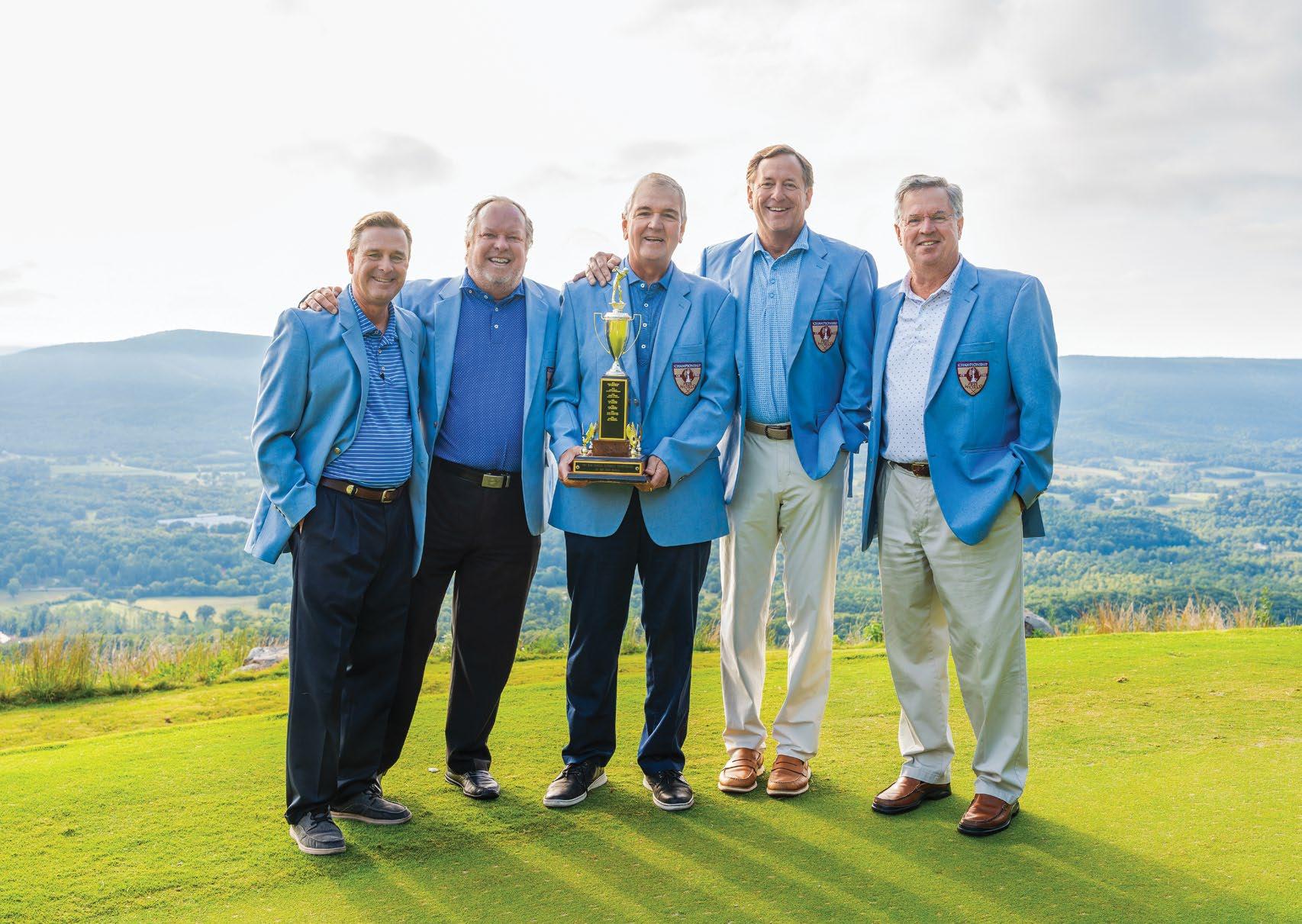
For just shy of four decades, Mike Costa and his friends have not only played golf together but also created and hosted a yearly golf tournament, called the Annual Championship of the Free World (COFW). What began as a two-man scramble with six golfers has over the years turned into an annual gathering of around 40 participants.
“We have always been close,” shares Costa. “This group grew even closer through our love of golf and because we are dedicated to playing this tournament each year. It's a given. You are going to be there.”
Winners of the COFW receive a 3-foot-tall trophy, topped with a golfer in full swing, powder-blue Champions jackets, complete with the COFW logo, and access to the Champions Dinner, which golfers are only allowed to attend once they’ve successfully won a tournament.
Competition is so fierce at this yearly event that incidents have been known to occur with the highly-coveted trophy.
“One night at a party at the house of one of the victors, the trophy was sitting prominently on his mantel. It remains a
mystery as to whom was responsible, but the trophy disappeared,” shares Costa. “A couple of days later, and continuing for about a month, ransom notes would show up with a picture of the trophy (the golfer blindfolded) and letters cut out of a magazine spelling out the demands for a safe return. Long story short, the trophy was eventually returned and the COFW took on new meaning.”
While the competition and numerous prizes are certainly fun, Costa admits that his favorite thing about golf is the camaraderie that is creates among old friends.
“A lot of us only see each other once a year, but we pick up right where we left off once we are together,” says Costa. “Golf keeps us connected.”
And, at the end of the day, Costa advises other golfers to not take the sport too seriously.
“Golf is a lot more fun when you roll with the punches and you don't get upset with a bad shot,” finishes Costa. “Enjoy the course and who you're with. That lesson only took me about 50 years to figure out."
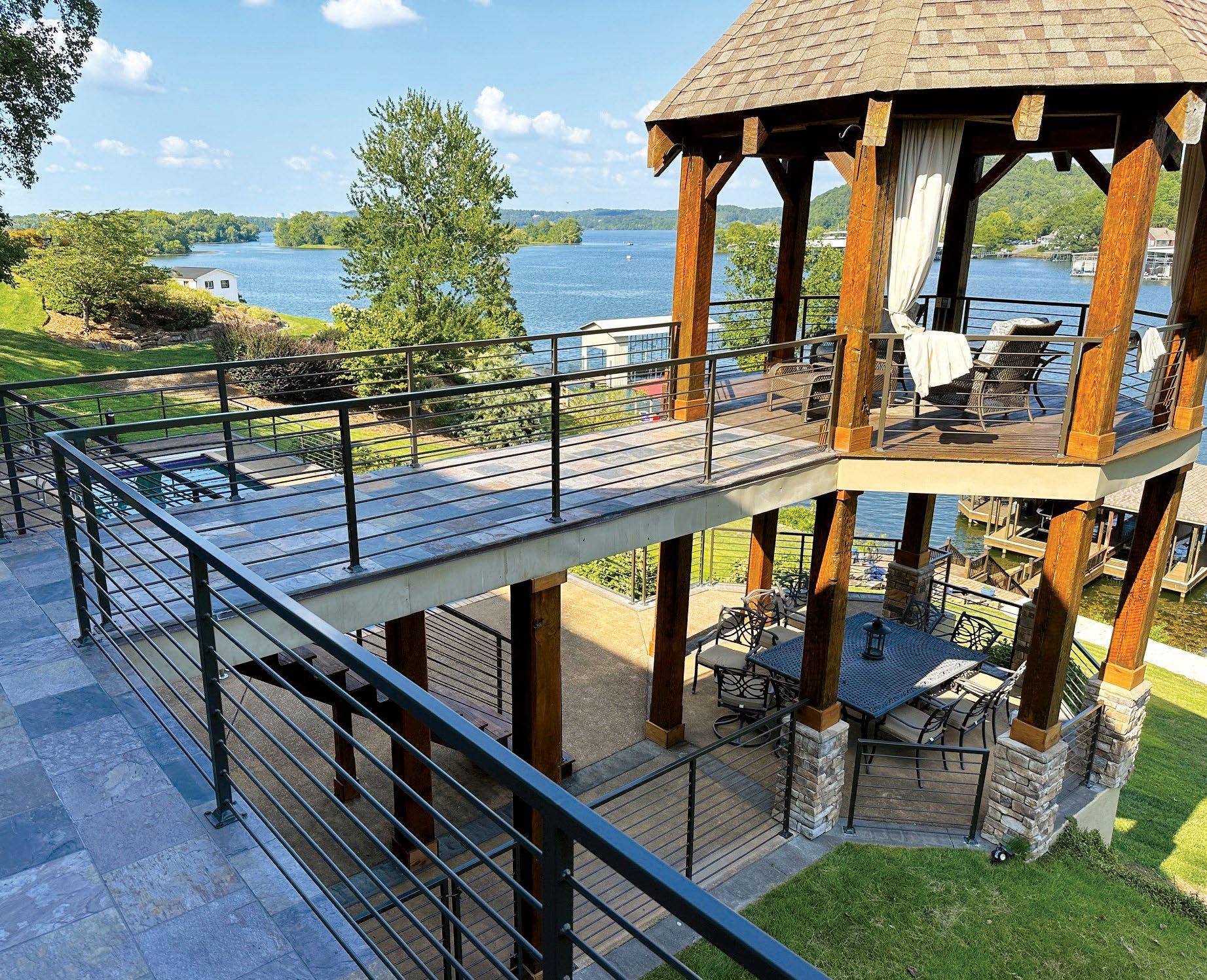







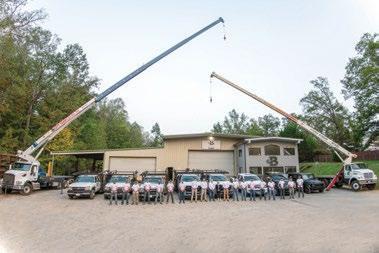


from left to right: Larry Eskrine, Marcus Jones, Ketha Richardson, Dwight Hill, Dedrick Hemphill, Mike Lacy, and Robin Davenport
While Ketha Richardson’s first time on a golf course was over 23 years ago, his long-term golfing group has slowly developed over the past 10 years.
“It started when Dee Hemphill and I met at a golf tournament at Bear Trace. I was asked to play in the tournament by one of my church members,” says Richardson.
Following the tournament, Richardson and Hemphill exchanged contact information to play together in the future. After meeting up at Brainerd Golf Course, with more friends in tow, the group never looked back.
“That was the start of the group,” says Richardson. “As time went on and we met new people who we thought would be fun to play with, we would invite them to join us.”
In fact, Hemphill now sends out a weekly email detailing when and where they’ll be playing for the week. With over 30 names included each week, participation is first come, first serve.
As the group has played together, they’ve also taken a variety of golf trips – from Fall Creek Falls to Huntsville, Alabama,
and New Orleans, Louisiana. Richardson admits that playing helps him relieve stress, and time among old friends certainly helps, too.
“My favorite thing is the fellowship,” says Richardson. “We get out and truly enjoy each other’s company with no drama.”
In fact, over the years, Richardson’s golfing group has turned from a close-knit group of friends to a true family.
“These guys are my brothers,” Richardson shares. “We have been there for our children’s milestones. We’ve been there during tough times for one another. We celebrate birthdays and accomplishments. We are there when we need someone to just hear you out.”
For those looking to create a golf group of their own, Richardson advises that it’s not bad to be picky.
“Everyone who plays golf may not be the right ones for your golf group,” says Richardson. “Play a round or two with them. You can see how they approach the game. It’s meant to be fun and played with integrity. You will know pretty quickly if a person is a good fit for your group.






Hugh Sharber isn’t just a member of a long-time golf group –he’s a part of the McNeil/Gerbitz golf game at the Chattanooga Golf and Country Club, which has been played for more than 40 years.
Founded in the 1970s by Ronny McNeil and Gary Gerbitz, Sharber was invited to play in the well-established group after joining the club in 1988.
“It was then, and still is, a diverse and friendly game,” says Sharber. “The game had an early tee time on Saturday that was favorable for young dads, as I was at the time, and a 1 p.m. starting time on Sunday that allowed for church attendance.”
While friendly, Sharber admits that there is certainly competition and hijinks within the game, particularly around the fairness of the game itself.
“The frame is set by the golf professionals at the club,” says Sharber, “but always with the possibility that our founders might have a thumb on the scale!” Fanning the flames, McNeil and Gerbitz tell the group to enjoy the fair frames during the winter months that they spend in Florida.
Though the competition, and cash prize for the winners, are certainly fun, Sharber’s favorite part of the group, which draws
from 25 to 30 different players, is the friendship that he has found within it.
“I enjoy the companionship with the other players and the competition within the game,” says Sharber. “As Gerbitz says unapologetically, the group is not for everyone, especially if you have thin skin or can't take some kidding or ridicule.”
With almost five decades of group history, several of which Sharber has been present for, the McNeil/Gerbitz group has stood by each other’s side through many different stages of life.
“We started with young families and balancing time spent playing golf with pursuing our careers and family obligations, and now most all of our players are empty-nesters, and some have part-time residences in Florida or other states,” says Sharber. “We have changed and shared those changes over the years.”
At the end of the day, Sharber attributes the game’s success to Ronny McNeil and Gary Gerbitz who “are just as comfortable with change and inviting new members to the game as with dispensing ‘dogfight justice’ so that the rest of us can enjoy the game when the results go our way or complain if they don't.”

Pictured from left to right: (Front row) Marty Lowe, Charles Patton, and Craig Warren (Back row) Terry Williams, Kenneth Jones, Ken Adams, and Brandon Culpepper
As sports supervisor for the University of Tennessee at Chattanooga men’s and women’s golf teams, and a member of the NCAA Division I Men's Golf Committee, golf is more than just a pastime for Kenneth Jones – it’s a way of life.
“My friend, who grew up playing golf, introduced me to the sport of golf in 2013. He was so determined to find something he could finally beat me at that he even gave me my first set of clubs,” shares Jones.
It’s safe to say that the obsession stuck. While Jones supervises many different teams at work, he also spends his spare time playing with an organization called 19th Hole, which he joined in 2016. Though, he admits his first impression was less than ideal.
“I hit a bad shot into the fairway of another hole off the tee. I walked over to hit my second shot and apologize,” says Jones. “We struck up conversation, and he brought up the organization he was playing with that day, 19th Hole. Despite that introductory shot, he invited me to join them for a round of golf the following week.”
Now, Kenneth is just one of 40 members in 19th Hole. With a mix of highly-skilled players, experienced competitors, and golf newbies, Jones admits that there’s never a dull moment within the group.
“You never know what you are going to get when playing with this group,” says Jones. “This makes every round competitive, adventurous, and fun, celebrating the good shots and laughing off the bad ones. In an environment like this, the camaraderie grows naturally.”
Jones says his games with 19th Hole have been filled with funny moments, like crashing a golf cart and seeing someone hit 12 balls in the water on the same hole, but his favorite memories revolve around the people themselves.
“Golf has a way of deepening friendships because it provides time for conversation and shared experiences. Spending hours together on a golf course, you naturally talk, joke around, and tell stories,” shares Jones. “Over time, these moments create lasting memories which, in return, create friendships on and off the golf course.”

While many prefer to golf in groups of four, Scott Wilson’s golfing group of five agrees the more the merrier. After being connected by Van Bunch, affectionately known in the group at “Captain Van,” the group has been playing in a fivesome ever since.
“It’s not how many are in your group,” says Wilson. “It’s how the group respects the game, the pace of play, the course, and the people with whom you share the course.”
Wilson and his group frequently play at Black Creek Club in various combinations of two, three, and four. Though Bunch is primarily responsible for connecting the golf group, several of the group knew of each other years earlier in high school.
“Four of us are Baylor alums and loyalists,” says Wilson, “and we’ve adopted Tom as an honorary Baylor alum.”
Playing as a fivesome isn’t the only unique aspect of Wilson’s golfing group. The group also loves to walk as much as possible while they play, sometimes as far as eight miles, though their true distinctiveness lies in how they play the game itself.
“We have an unusual set of rules for our ‘game.’ Van, as captain, is the gatekeeper/judge/jury for new rules and the game we play,” says Wilson.
From getting a par on the first hole (no matter how many shots it takes) to kicking balls into the fairway and replacing wayward balls, regulations are documented in the group’s rule guide, dubbed “A Zen Guide to Golf.”
On the last page of the book, the group’s playing philosophy is summed up in three sentences: “These are just a few rules with more to come. The beauty of golf is that the rules change daily. Just remember: No mulligans – that’s cheating!”
Turns out, an odd number of players, plenty of miles walked, and ever-changing rules are the perfect recipe for developing long-lasting friendships.
“The growth of these friendships is the best part of the experience,” shares Wilson. “I truly have grown to love these guys … they have been a true blessing in my life.”
For those looking to develop a golf group of their own, Wilson recommends focusing on the people rather than the game itself.
“Be open to the possibility of making important new friendships and don’t fret the quality of your golf game … that’s the least important piece of a great group,” finishes Wilson.


As the leaves begin to turn, the arrival of fall means one thing for many Southerners: hunting season. Each year, several local hunters turn to traditional equipment in their pursuit of whitetail deer, turkey, and other game. Whether hunting with a longbow, recurve, or – more commonly –a compound bow, this method requires close proximity to the game and a mastery of equipment to land an ethical and effective shot. Bowhunting, while not as popular as other hunting methods, retains a devoted following of individuals who are passionate about the great outdoors and the art of archery. Here, we chat with six locals about their love for the sport, how to be a successful bowhunter, and what keeps them coming back to the woods year after year.
Photography by Vityl Media
WHAT GOT YOU STARTED IN ARCHERY?
I got interested in high school. I got my first bow, a recurve from JC Penny, for $35, and I still have it. In 1966, I shot at my first deer with a bow – missed a mile! – and I was hooked. I was determined to get a deer with a bow. Five years later, I did, and that was the biggest rush of adrenaline I’ve ever had. Fifty-eight years later, and I still get the same feeling. Archery and bowhunting have been my life, from the time I was 15 until now. I love it and always will.
WHAT IS YOUR FAVORITE ASPECT OF THE SPORT?
I always loved the woods. I squirrel and rabbit hunted a lot, but when I got into deer hunting it was a whole new ballgame, learning about the woods, what deer eat, and the different trees they like. I have two sons, John and Rusty, who love to bowhunt and are very successful. I always told them we’re here to enjoy the outdoors and have a good time, and if we get a deer it’s just a bonus! I now have five grandkids and always said if I live long enough to see all my grandkids get a deer, my life will be complete. Well, I made it, and they were all very special to me.

WHAT IS THE CHALLENGE OF BOWHUNTING?
With archery equipment you have to get close to the game. To do that, you have to know what they eat and their habits. One of my favorite sayings is, “If you want to be successful at bowhunting, you have to get right there in the kitchen.” Deer have superior senses, and more times than not, they can tell when someone is in their kitchen. That’s the challenge that keeps you coming back.
ANY ADVICE FOR THOSE GETTING INTO THE SPORT?
I owned a bow shop for 18 years, and I always told customers you don’t have to have the best that money can buy. It’s not the bow, it’s the archer – get what you can afford. I fixed a lot of old bows for young folks that were poor at that time of their life. They never forgot me helping them get started. Some are very successful now and still bowhunt. I hope to see young people getting into archery, even if it’s just for fun.


WHAT GOT YOU STARTED IN ARCHERY?
My dad got me into archery when I was 8. I loved the challenge of hunting with a bow. I also was fascinated with how the gears worked on compound bows, the way the arrow was constructed, and how everything came together to hit the target downrange. I love how archery is a mixture of math and personality: calculated results mixed in with your own personal touch.
WHAT IS YOUR FAVORITE ASPECT OF THE SPORT?
I love setting up a bow from scratch – personalizing it while also trying to gain as much output and forgiveness as possible. Calculating everything, building it, and then seeing the arrow fly downrange is flat-out awesome. I’ve worked for a pro shop and bow manufacturer, and I’ve owned my own pro shop for nine years now. Not one day has gone by where I haven’t been excited to go to work. Plus, I get my own platform to talk about my faith and talk to others about their life journey.
WHAT IS THE EXPERIENCE OF AN ARCHERY COMPETITION LIKE?
It’s incredible. I’ve competed locally and nationally in indoor/outdoor competitions. Seeing and competing with so many diverse people is really cool. An elite shooter competing in their element is something that I think every archer should witness.
WHO’S BEEN BY YOUR SIDE IN YOUR ARCHERY JOURNEY?
I wouldn’t be where I am without the support of my family. As a kid, I was always dragging in wild game for my mom to cook and she never complained. My dad (which I didn’t know at the time) was new to bowhunting when I got into it; I thought he was the reincarnation of Fred Bear, but he was learning just like I was.
Lastly my wife – she’s the real MVP! She understands and supports the feeling I get in my bones when the temperature drops in October to go chase my dreams and wander around in the wilderness. I couldn’t have asked for a better partner to do life with and hopefully raise our son to dream big and experience the wild!
ANY ADVICE FOR THOSE GETTING INTO THE SPORT?
My advice is to go to a local pro shop and talk to the crew who works there. Be honest about where you are in your journey and what you’d like to accomplish. Most crews are great!


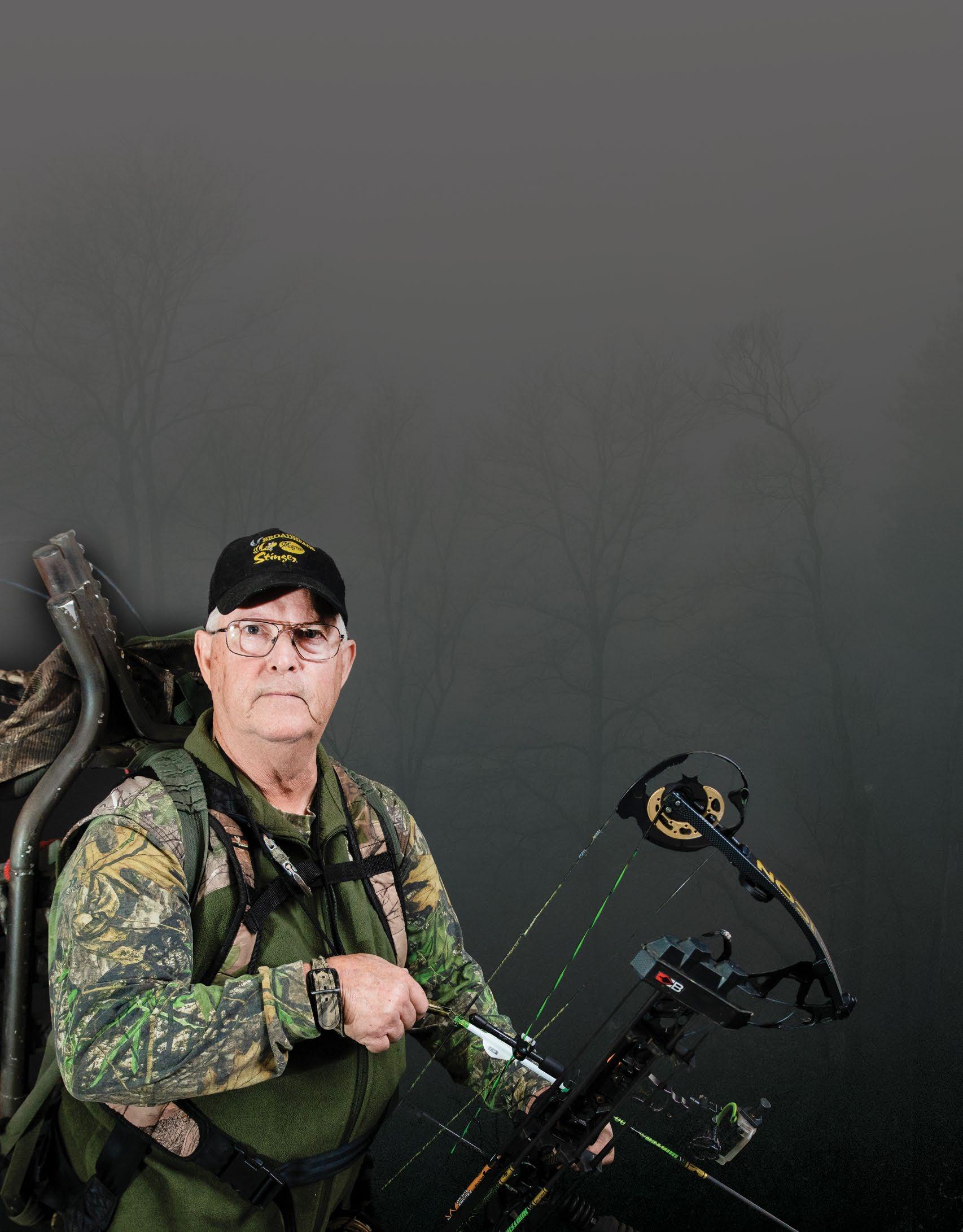
WHAT GOT YOU STARTED IN ARCHERY?
I never knew it existed until a neighbor who never did anything all year was suddenly discovered in his backyard shooting with a compound bow, which seemed to me to be extremely out of character for him. So, I went to a pawnshop and traded a .22 magnum Marlin lever-action for a used compound bow and quiver. At the time, I didn’t know anyone who shot a bow, and my friends actually laughed at me when I told them I was going to deer hunt with a bow.
HOW DOES BOWHUNTING DIFFER FROM OTHER HUNTING METHODS?
Archery with a vertical bow takes extreme amounts of practice to perform efficiently and effectively. Unlike firearms and crossbows where the hunter can easily shoot once or twice to make sure their scope is dialed in, vertical bowhunting takes much more practice and dedication to be able to perform under pressure.
WHAT IS YOUR FAVORITE ASPECT OF THE SPORT?
The singularity of the sport! You should only compete against yourself.
WHAT IS THE SOUTHEAST ARCHERY COMMUNITY LIKE?
There are some really good hunters and archers in the Southeast. It is a great community of people, male and female, to be involved with in this area. The vast majority of bowhunters I have met are some of the best friends you could ever want.
MOST MEMORABLE HUNTING TRIP?
No question, it was the Tennessee elk hunt in 2022. Honestly, just to get drawn for the tag for the opportunity to bowhunt was incredible. And then I took several good friends and went to the area and managed to take a really good bull on the fourth day!
ANY ADVICE FOR THOSE GETTING INTO THE SPORT?
I suggest anyone interested in getting into the sport, if they are within two hours of Dayton, to go to Harvest Archery and meet the staff there who are very helpful and knowledgeable. They will save a newbie hours, if not days, of time and frustration to figure things out.
I started bowhunting to spend more time in the woods. I’ve hunted deer, elk, and turkeys with my bow. Archery season opens in September, and it gives me a lot more opportunities to hunt. I like to hunt in the Midwest, as the seasons in those states are primarily archery, so it gives you more opportunities.
FAVORITE
I enjoy bowhunting for a lot of reasons, the obvious is the challenge of getting an animal that close. I also like that the deer are not pressured as hard as they are during the firearm seasons.

Bowhunting has also allowed me to get my wife and kids involved in the sport. Seeing them take their first deer with bows are some great memories. It’s also allowed me to meet some great people as I’ve gotten to hunt in several different states.
I’ve had a lot of memorable hunts. I’ve taken some really nice whitetails with my bow, and just this year, I harvested a really nice elk in Utah. There’s no way to describe the adrenaline rush you have when you have a large, bugling animal 20 yards away on the ground, and you have to figure out when to draw your bow and take a shot.
WHAT KIND OF GEAR DO YOU PREFER TO USE?
I’ve shot a lot of different bows through the years. I shoot a Mathews right now and really like their bows, but there are a lot of good bows out there. There have never been more tools and weapons to make hunting easier than there are today, and hunting with archery equipment that you have to practice with to make effective and ethical shots is what makes the sport what it is. You really can’t go wrong as long as you get a bow that fits you and you practice to build that muscle memory.
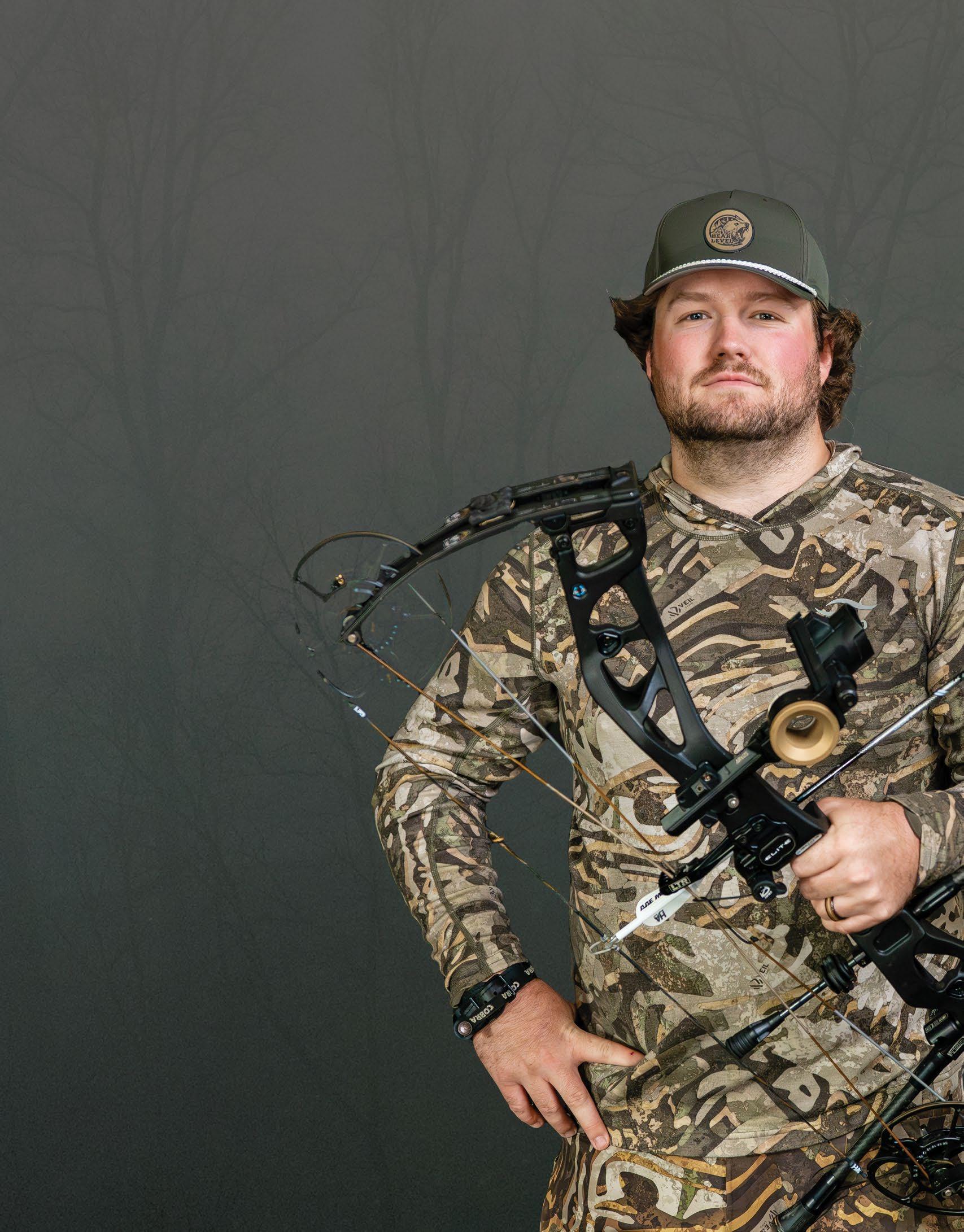
WHAT GOT YOU STARTED IN ARCHERY?
The very beginning of my love for archery started when I was dating my wife, Meg. Her Uncle Chad had an extra bow in his closet, which he didn’t have to give me, but he did out of his own heart. It felt like it was an acceptance into the family in a way, and like God was giving me a chance to go out and focus on His creation. Ever since, archery and bowhunting have been my true passion. I’ve stuck with it because I love the challenge of challenges.
WHAT IS YOUR FAVORITE ASPECT OF THE SPORT?
It’s the "what if" factor and the strategic values that go into bowhunting that made me fall in love with it. You might think you have it all figured out, but it comes down to one shot so you better be prepared. That shot defines everything you worked for before the season. So, when you do succeed, you look back on what you did to make that happen, and that is the beauty of it all.
WHAT IS THE SOUTHEAST ARCHERY COMMUNITY LIKE?
If I had to describe Southeast archery in one word it would be "grit." I am a little biased, but I believe the Southeast is the hardest area to hunt whitetail or any game. Not just because of the mountainous hills and weather, but I believe it’s because our animals have learned a few things over the years.
MOST MEMORABLE HUNTING TRIP?
The first year I started bowhunting, I had worked all summer long on a 1-acre clover plot tucked in the side of the woods. On opening week of bow season, I had pictures of a deer I called “Broadband,” named after his wide antlers. On the fifth sit, there was a major temperature drop where it got down to 60 degrees in September, so I knew he would be on his feet. Instead, a giant buck I had never seen before came in 11 yards of my bow. I remember trying to explain to everyone how big he was, but it was almost like there wasn’t enough proof. Because of this, I decided to document all of my hunts, and I fell in love with telling a story through film and sharing it on my YouTube channel “Bear Level.”














t
h o m e n e a r d o w n t o w n S h e s e n t u s
M L S l i s t i n g s d a i l y a n d s h o w e d u
h
S h e w a s s o p a t i e n t w i t h u s H e r
e x p
h
w e g o t o u r p e r f e c t h o m e I w i l l
d
- H o l l y S


•
•
•
•
•
• New Construction
•
•
• Condos & Townhomes
• Relocation
• Investors

• Ranked Top 15 Real Estate Agents in Chattanooga for 2023
• Ranked Top 0.4% of Listing Real Estate Agents of the Greater Chattanooga Area for 2023
• One of Chattanooga’s Top Sales Agents for Over 20 Years
• Million-Dollar Producer for 33+ Years
• Over $666,172,444 in Sales
• Voted Best of the Best in Residential Real Estate 12 Times
• Ranked by REAL Trends + Tom Ferry America’s Best Real Estate
• Over 2,000 Settled Real Estate Transactions Overall
• Over 50 Years Combined Real Estate Experience
• Specialized Training and Expertise Through Our Designations
AJ DeMatteo

WHAT GOT YOU STARTED IN ARCHERY?
My dad was a big bowhunter when I was young and was also heavily involved in the archery industry throughout his career. This was awesome, as I was able to have a wealth of knowledge just right down the hall. He was very good at coaching me, letting me make mistakes, and teaching me why I made those after the fact.
WHAT IS YOUR FAVORITE ASPECT OF THE SPORT?
I love the process of the sport: beginning with the building of arrows, starting with a bare shaft, adding different inserts to the arrows, wrapping and fletching my arrows, as well as tuning – all the way to picking out the perfect spot in areas that allow me to get within close enough range of an animal without it spooking. I also love the family part of hunting and hope to share my love of hunting with my children, Woods and Sailor.
WHAT IS THE EXPERIENCE OF AN ARCHERY COMPETITION LIKE?
I’ve competed in a number of different bowfishing tournaments, starting locally and then going to more regional and national tournaments, such as the U.S. Open Bowfishing Championship and the Muzzy Bowfishing Classic, where my team and I have been fortunate enough to have two second-place finishes and a third-place finish over the last three years. The experience is tough, but it can be very rewarding in the end. In these scenarios, every fish counts, and this alone keeps the adrenaline up and just powers you through to keep on going.
MOST MEMORABLE HUNTING TRIP?
I went down with a handful of buddies to the southern part of Louisiana along the Gulf Coast in the pursuit of alligator gar, which has always been towards the top of my bowfishing bucket list. We took our boats and equipment and spent three or four nights in the middle of the swamp, usually from dark until daylight. Experiencing all the different types of wildlife in that region was incredible. We were able to arrow a number of nice alligator gar up to six feet long.
WHAT DO YOU HOPE TO SEE FOR THE FUTURE OF THE SPORT IN THE REGION?
I’d love to see more of the younger generations be introduced into the sport. Whether it be bowhunting, bowfishing, or just shooting a bow in the backyard, that can have a lasting impact on someone's life and open up different opportunities for them over the course of their life - and who knows, potentially be passed down through another generation in the future.

If you’re a “my dog goes everywhere with me” kind of gentleman, these products will help you keep your pup happy and healthy no matter how rugged the terrain.

Dog vests allow for visibility and protection while you’re on the move. This vest was designed by bird dog owners and has a reflective neck band, tear-resistant fabric, and a double-velcro underbelly attachment.
Eliminating the need for bulky containers or plastic bags, this bag is designed for easy and convenient transport of dog food. Made with heavy duty, water-resistant poly cotton, it comes in four stylish colors and rolls up for a spill-free experience. It also comes with a metal cup to scoop and portion food and an external loop where it can be clipped to another bag.
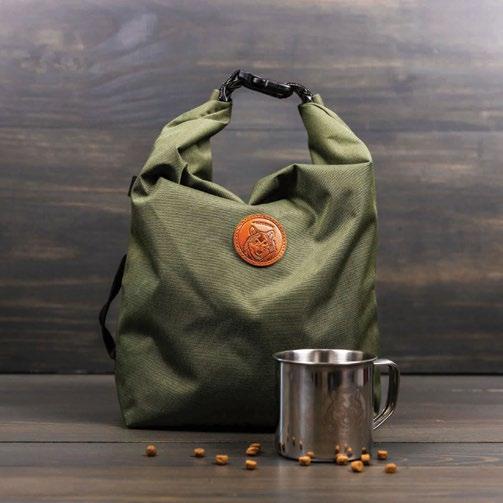

Even the biggest of tents can start to feel cramped when your pup is taking up most of your sleeping bag. Wilderdog solves this problem with a doggy sleeping bag, made of durable rip-resistant polyester and a soft inner lining. It can stay zipped to allow them to burrow in or unzips so they can sprawl out.
Active dogs who spend time outdoors often experience chapped or irritated paws and noses. Thankfully, this paw cream by Rocky Mountain Dog allows you to prevent chapping from the elements or soothe dry and cracked areas after exposure. The nourishing balm is made with organic ingredients like beeswax, shea butter, and olive oil for maximum repair and hydration.
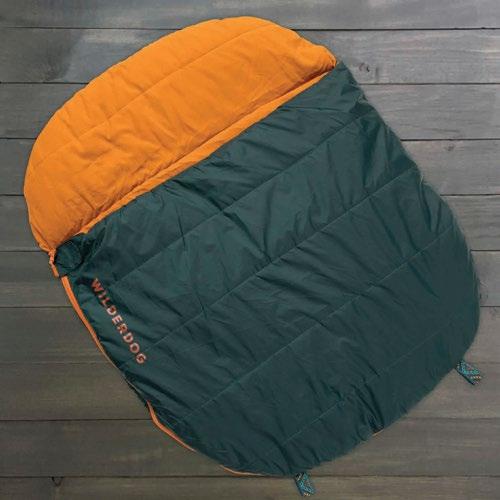

In case of an emergency, it’s better to be prepared. Designed with field dogs in mind, this aid kit is equipped with items to treat cuts, punctures, eye injuries, thorns and quills, sprains, hypothermia and hyperthermia, and more. It also comes with a step-by-step guide for various emergency situations.

The age-old bond between a man and his hunting dog is fueled by trust, love, and a mutual passion for the sport. Here, six local gentlemen share what makes their dogs special, in the field and at home. As W.R. Pursche wrote, “Everyone thinks their dog is the best dog in the world. And none of them are wrong.”
By Kristen Dee / Photography by Corey + Emily Critser
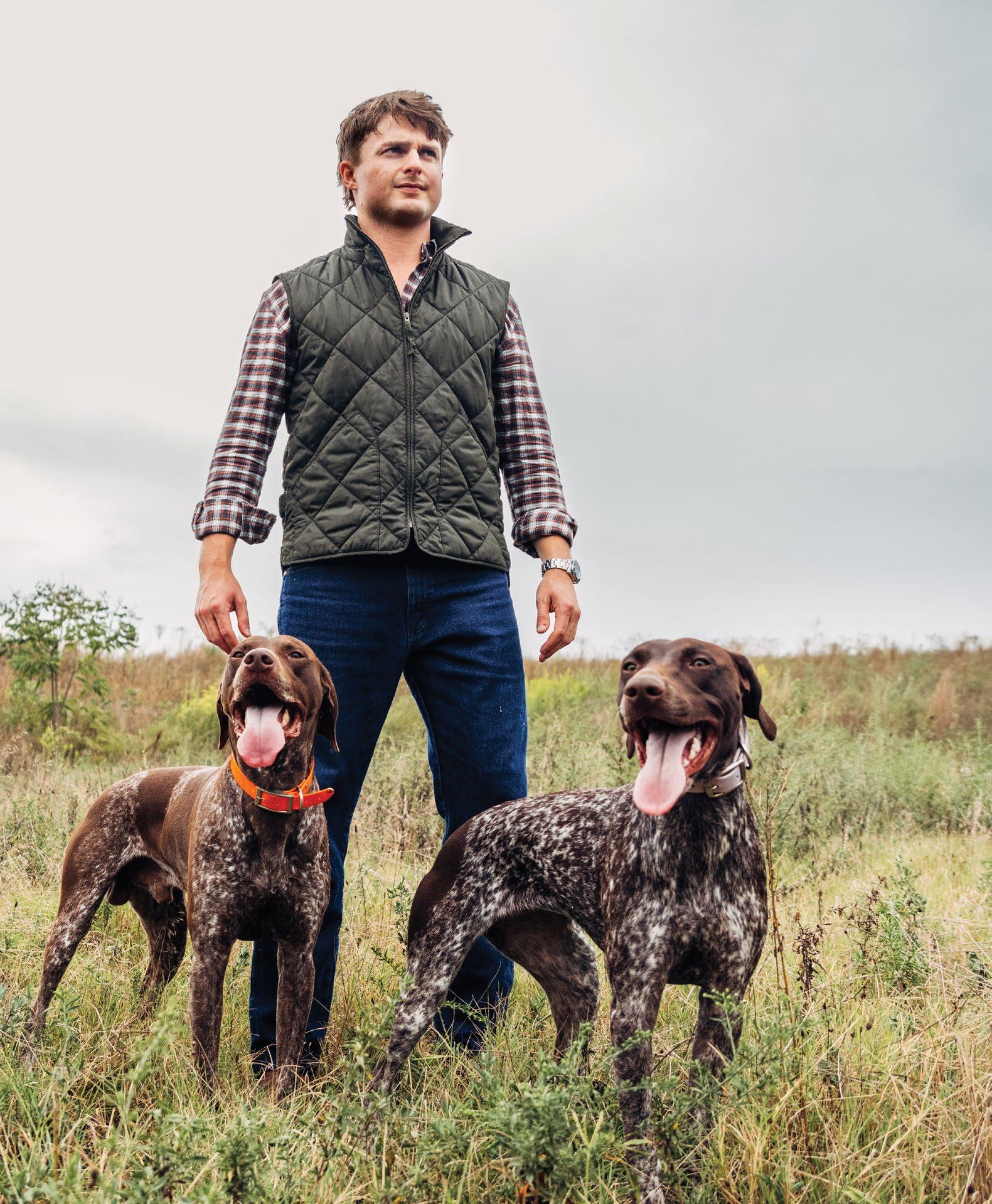
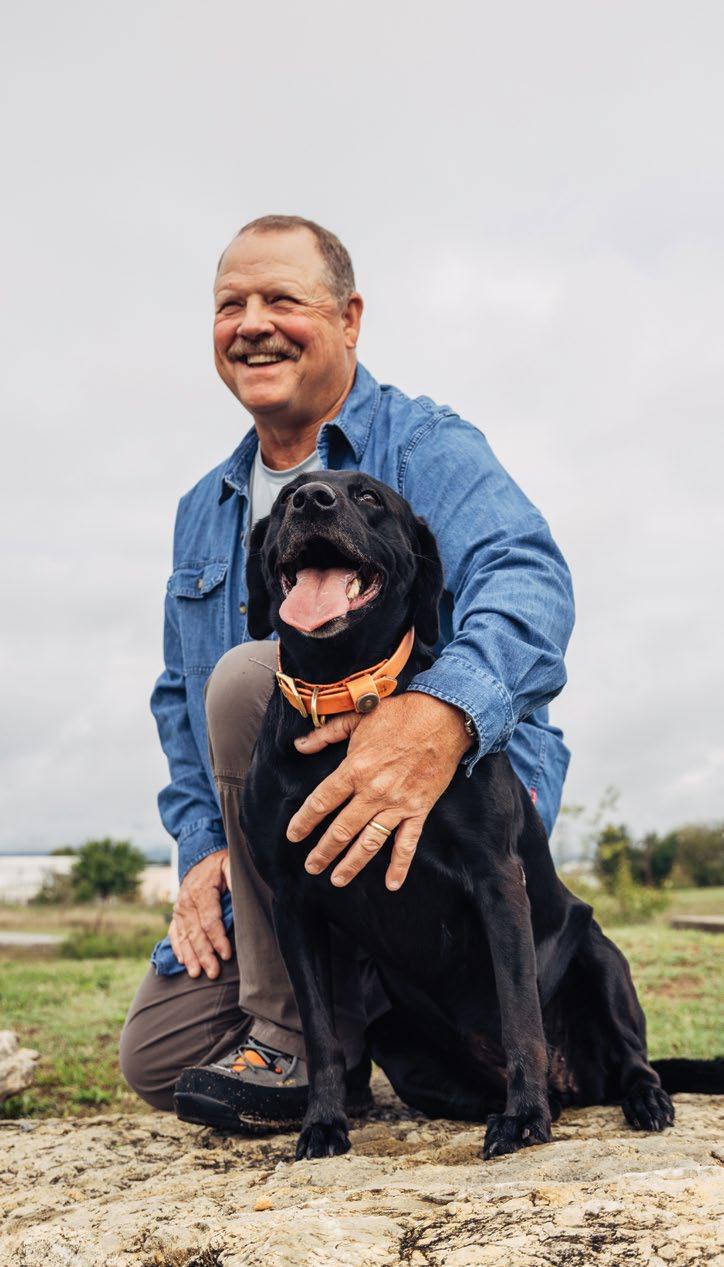
Coming up on their sixth hunting season together, Mario DeMatteo and his 6-year-old black Labrador retriever, Delta, are eager to be chasing birds again. “Waterfowl hunting is my personal passion,” says DeMatteo, “And having Delta be a part of it just means that much more.”
DeMatteo is partial to labs, saying they are “the best retrievers and pets.” And of course, Delta is no exception. She truly was bred for the hunt, coming from a long line of duck hunting dogs. Delta was trained locally by Brian Caldwell of Ringtail Retrievers, and has now retrieved more than 3,500 ducks and counting, many alongside her mother. “Her mother, Snap, hunted with us for several years. Delta and I watched her retrieve her 8,000th duck during her last season. Delta is also able to hunt with four of her siblings, who belong to other members of our duck club,” shares DeMatteo.
Delta loves to hunt, and she acts “like a kid on Christmas morning” when she gets to go. “She is ‘on go’ as soon as she

hears a duck call being blown from the blind,” says DeMatteo. “She’s in high gear as soon as their feet hit the water.”
The pair typically hunt together more than 50 times a season in Arkansas. “Sometimes we think that much hunting is tough on them,” he says, “but she sure does give me the sad eyes on days I leave her home to rest.”
Although she lives for the hunt, Delta also enjoys the pleasures of being a family dog, including playing with the grandkids, sleeping in the middle of the bed each night, receiving doggy chocolate chip cookie treats, and getting the coveted belly rubs each morning. “Not many dogs get to hunt that many days each year and then enjoy home life,” says DeMatteo. “She is a big lapdog."
"Waterfowl hunting is my personal passion, and having Delta be a part of it just means that much more."
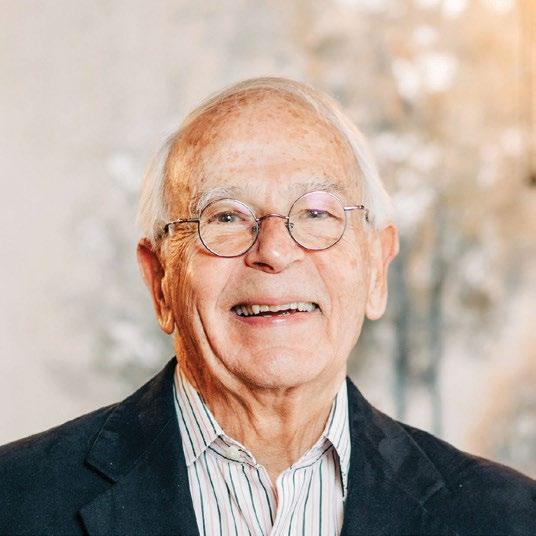
Affiliate Broker Licensed in TN & GA
Having lived in Chattanooga all his life, Charlie knows Chattanooga and its people. Charlie’s accomplishments include being named Realtor of the Year in 1982, President of Chattanooga Association of Realtors in 1986, and Director of Tennessee Association of Realtors, among others. The Walldorf name is the oldest in Chattanooga and the family continues in the real estate business and leadership roles today. He and his son, Nathan, are the father-son team approach who combine youth and experience.

Affiliate Broker Licensed in TN & GA
Nathan Walldorf grew up in Chattanooga and is a current resident of North Chattanooga. He has been in real estate since 2005 and has served on the GCAR Community Service Committee, the GCAR Board of Directors, and the GCAR Multiple Listing Board of Directors. He was also President of GCAR in 2016. He is certified to understand and coach buyers/ sellers through the process of buying or selling high performance homes (NAR GREEN).

When buying or selling, turn to the local and connected experts at The Group. Our caring and professional team will get to work right away finding the perfect place for you to call home. It’s our number one priority to make sure you have a boutique, tailor-made experience.
Call us today and begin your journey with one of Chattanooga’s Top Realtors. Local, connected, and ready to move you.
In 2020, Jason Raughton and his wife were looking for a Brittany spaniel to add as a pet to their family. Remi Lou came home with them on New Year’s Day in 2021, and the rest is history. “Immediately our family fell in love with her,” Raughton says. “Little did I know I would be hunting with her within two years.”
Raughton sent Remi Lou to puppy school in North Georgia, followed by another round to brush up on skills and learn to point and retrieve, which initially proved more challenging than expected. “We couldn’t get her to retrieve,” he says. “Then she saw her friend Rosie retrieving quail and decided she wanted in on the action. While Remi Lou was retrieving her first bird, Rosie came up and stole it from her. After that, she was determined to retrieve.”
Now at 4 years old, she’s a seasoned retriever, and the two hunt at least once a week during the season. “Every time we begin to load the truck she goes nuts,” Raughton laughs. “She’s worried we’re going to leave without her, but she always goes. Once we arrive she knows it’s time to work. She has a marvelous sense of smell and awareness. She knows the definition of ‘bird’ and ‘go.’ If you want to get her excited, simply mention either and watch her reaction.”
For Raughton, seeing Remi work is one of the things he enjoys most about hunting. “I’ve always heard people talk about how much they enjoyed watching their dog work, more than the wing shooting itself. Now I understand what they mean. If I had to choose between going on a great hunt without Remi, or taking her out and not shooting, I’d definitely take her to hunt and not shoot,” he shares. “Watching her work is amazing. We’ve had dogs all our life, but never one quite like her.”

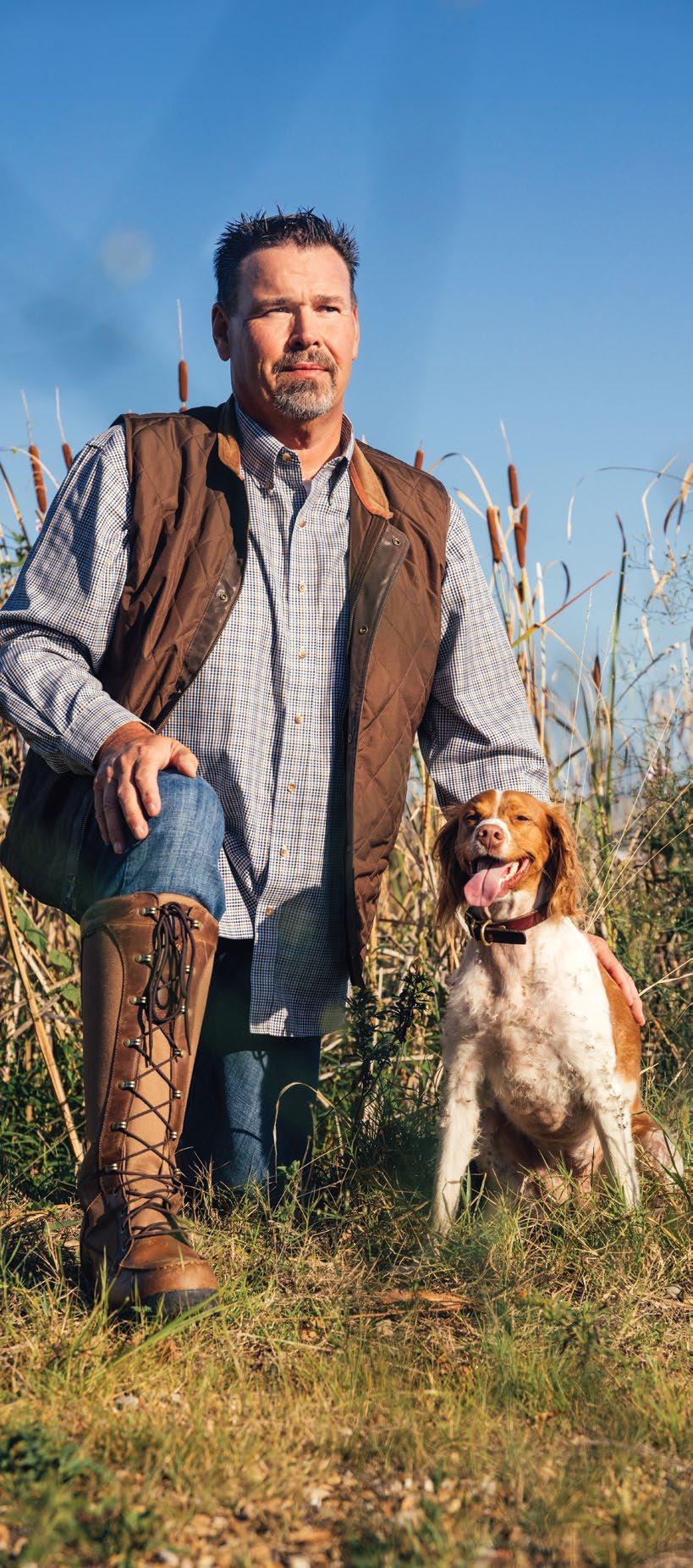
"We've
had dogs all our life, but never one quite like her."

Like many bird hunters and dog lovers, Sam Stewart knows one dog simply isn’t enough. So he has three. Millie, Goose, and Huckleberry make up Stewart’s pack of German Shorthaired Pointers (GSPs), each with their own unique personality and knack for finding birds. Millie is the youngest of the group at 10 months old, and she loves to snuggle when she’s not catching birds. Millie’s father, Huckleberry, is also a lap dog, even at 55 pounds. Her mother, Goose, goes everywhere with Sam and is “the best shotgun rider a man could ask for.”
Together, the four spend many weekends hunting with Stewart’s father, David, and other family and friends. “These dogs have brought our family together,” shares Stewart. “You get to walk through fields and pine forests on beautiful days, talking and watching dogs do what they love and what they were born and bred to do. They bring our friends and family so much joy.”
Although the dogs love to cuddle and play, they are all business when it’s time for a hunt. “If they see you put on a specific shirt, hat, or boots, they know where they are going. Even on the ride there, their demeanor is different. The drive they have is amazing,” says Stewart.
GSPs are bred and born with this drive, and then attend training to fine-tune and advance their skills. “The training teaches them the ‘why’ and ‘when’ to point birds,” Stewart explains. “After training away from us, we spend quite some time training and rehearsing with them in the field. It’s important to build mutual trust, and we learn together. When everything comes together, it’s incredible. You can tell how happy and proud the dog is. I find myself enjoying the hunt more than the bird.”
The joy of the hunt and the special bond Stewart has with the dogs inspired him to start a family kennel in honor of his first GSP, Gunner. “Gunner GSP Kennels’ mission is to help spread the joy and love the dogs have brought to our family,” he says. “It’s an amazing thing to watch a good dog do its work, and Huckleberry, Goose, and Millie are certainly good dogs.”
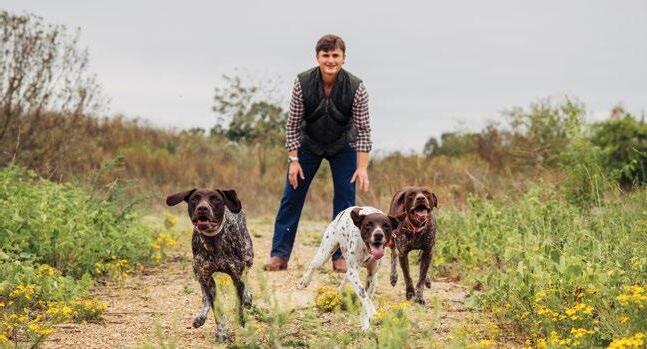

"It’s an amazing thing to watch a good dog do its work."

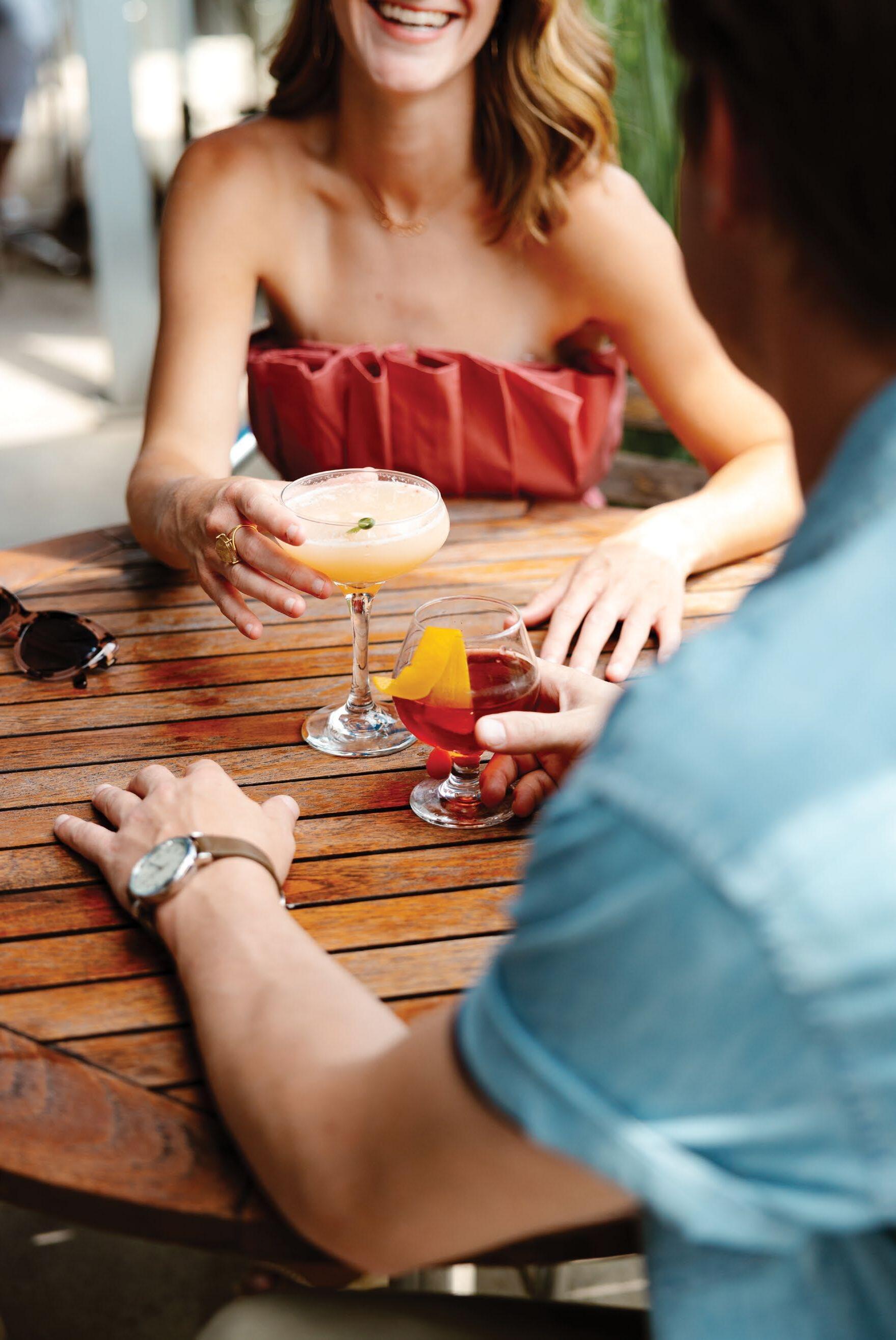
AT WAREHOUSE ROW
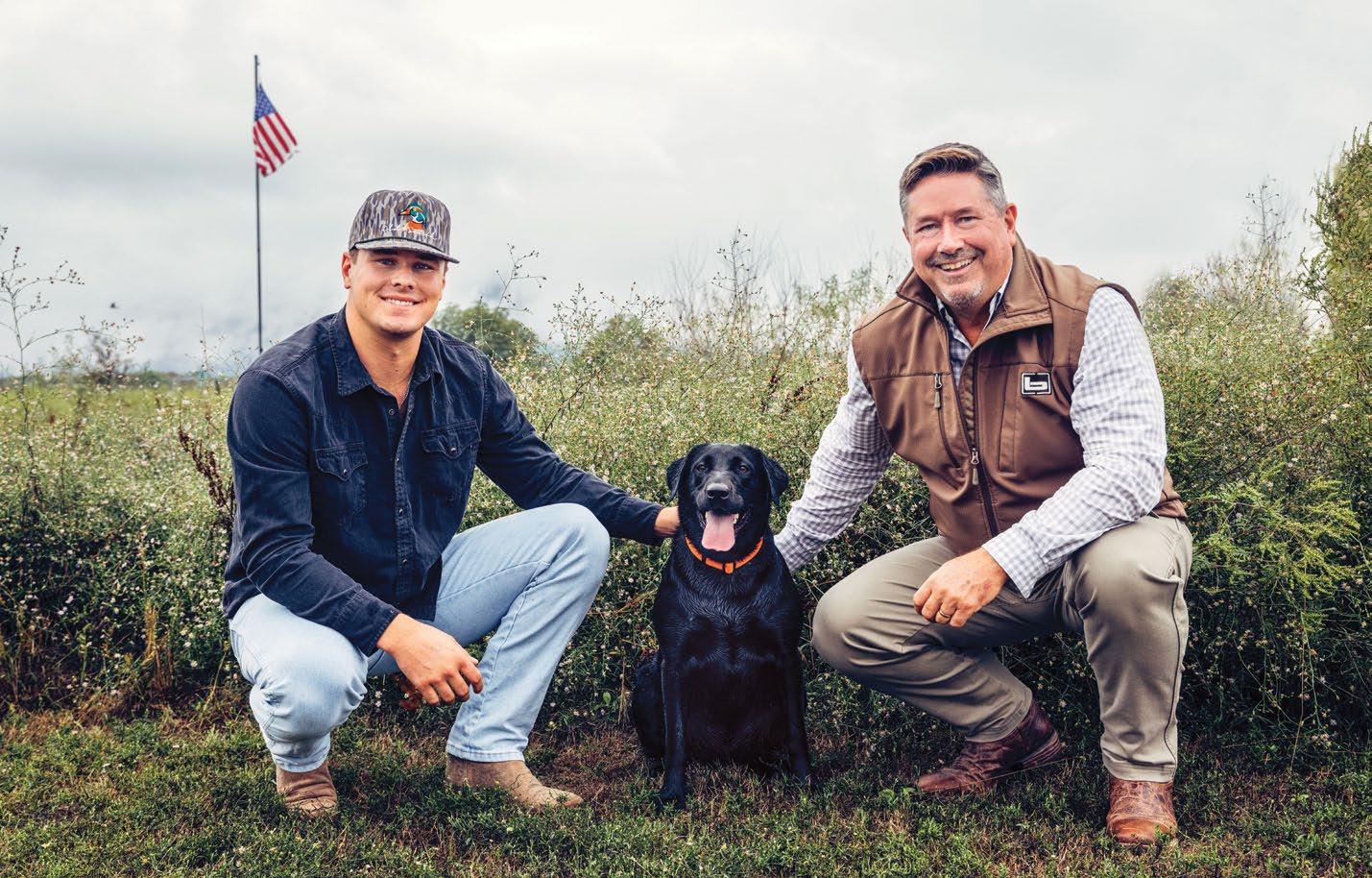
Jack Julian and a few of his baseball teammates each got a black Labrador while in college. But as a baseball player, a hectic schedule meant that Nelli often spent time with Jack’s parents, Ken and Tricia. Before long, Nelli was everyone’s dog, and she began training to hunt waterfowl. Her first hunt was at just 1 year old, when many of the birds she retrieved were bigger than her. “They were twice as large as she was,” Ken Julian recalls. “We were absolutely amazed she retrieved those birds like a pro and knew we had the ‘hunting dog’ we’d always dreamed of. Nelli is the ultimate companion in the field and at home.”
Now 3 years old, Nelli is a bit bigger and still lives for hunting days with the Julians. “As soon as you mention, ‘Do you want to go hunting?’ she is in retriever stealth mode! She will be loaded up in the truck before you can even get your gear ready,” laughs Julian. “She’s the true definition of a retriever. She’s retrieved every down bird on our hunts, no matter the terrain. She prefers water retrieves, but she will go into any thicket or briar patch to fetch her game.”
In the off-season, you can probably find Nelli lounging with her family, hanging out with her two house cat friends who have “adopted her,” or exploring outside. “She loves running through the woods and fields or retrieving training decoys in a creek or lake on almost a daily basis,” says Julian.
As the upcoming waterfowl season approaches, the Julians are getting ready to be back in the cold and get as many birds as possible with Nelli by their side. “Jack and I are best friends, and now we’ve added a third,” shares Julian. “We aren’t sure who’s more excited for the upcoming waterfowl season, us or Nelli, but we do know all three of us will be there together."

"Nelli is the ultimate companion in the field and at home."



“Every story with a dog in it is worth telling,” says Rhey Houston, reminiscing on a lifetime of memories of hunting with dogs, friends, and family. For Houston and his family, the opportunity to hunt with their dogs is a way of life, not just a lifestyle.
Currently, Houston hunts with three dogs: Tiller, a 10-yearold Labrador retriever, Piper, a 9-year-old Brittany, and Wilson, a 2-year-old German Shorthair Pointer. The variety of breeds allows them to each bring their own skillset and personality at home and to the hunt. “Labs are brilliant and durable, Brittanys have markedly more heart than most people, and German Shorthaired Pointers are uniquely athletic and competitive,” Houston says. He describes Tiller as “fiercely loyal,” Piper as “sassy,” and Wilson as “a warrior.” Together they hunt for waterfowl and upland game birds, and have traveled all across the world to do so.
As avid hunters know, preparation in the off-season is just as important as the day of a hunt. “These dogs have spent countless hours on training grounds,” Houston shares. “I suspect

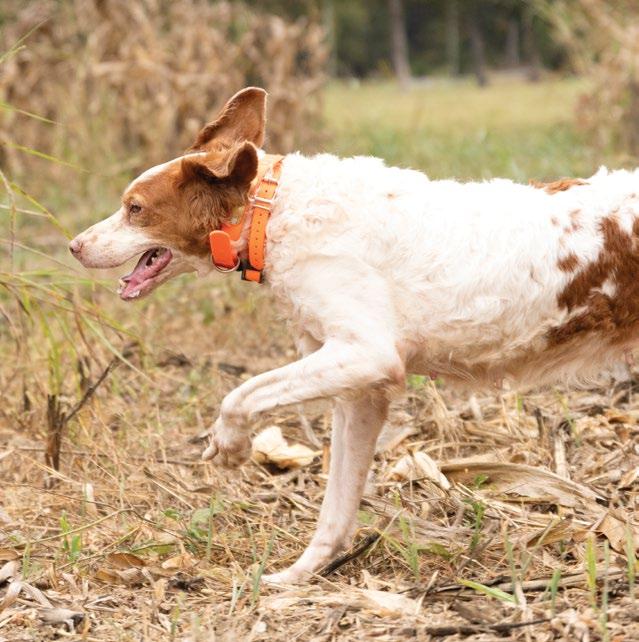
we don’t really prepare them for the hunt, but they prepare us. We work a lot in the off-season to cover the basics and remind each other of expectations, but when the hunt begins, their genetics, instinct, athleticism, and training create a different kind of partnership; one with individual responsibilities but mutual accountability.”
Houston says that the three dogs are ecstatic on hunt days, and typically deliver on their responsibilities even in the worst of conditions. “Tiller is a strong retriever, in water or dense cover. Piper and Wilson tirelessly cover miles of dense habitat. Many of these birds would be unrecoverable without them.”
Although the hunt is the purpose, Houston can’t help but recognize the significance of the memories and experiences that come with it, saying, “Every time we get to share the marsh or upland fields with our dogs and our friends is special. Together, these wonderful dogs and I have been witness to many sunrises and sunsets with people who would not normally see creation from that particular perspective; knowing that it wouldn’t have happened without a dog!”
"Every story with a dog in it is worth telling."













The Better Way To Get There.

Having spent several years hunting with his friend’s bird dogs, Jordan Leggett wanted to experience it for himself. After extensive research and finding a breeder in Southeast Missouri, he came home with Yeti, a chocolate lab. “I chose a chocolate lab because I grew up wanting one, and their proven drive and resilience in cold weather,” says Leggett. “They also make amazing family dogs. I would make the same choices all over again when it comes to choosing a hunting dog.” The two bonded instantly, and Yeti spent the following duck season in North Georgia, learning the basics of gundog training. They are now five waterfowl hunting seasons in, and Leggett couldn’t be more thrilled to hunt with Yeti by his side. “My favorite memory is our first hunt together on Thanksgiving morning in Missouri, just him and I hunting together. I remember shooting the first duck that came in and the pride I felt when he leapt out of his blind and retrieved it. He was steady the whole morning and never jumped before his name was called. I knew after that morning I would never want to hunt without him again,” he shares.
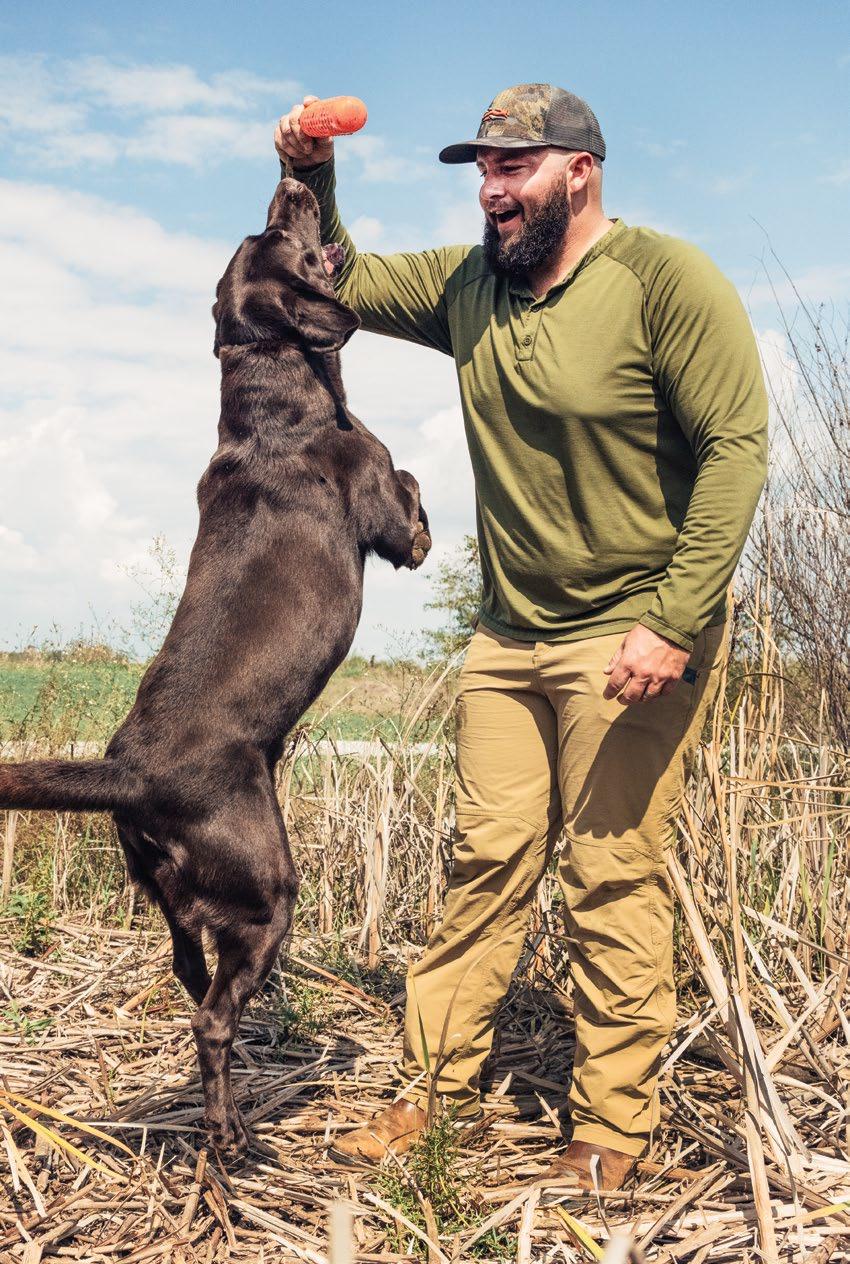
The joy Leggett gets out of hunting with Yeti is certainly reciprocated each time they go for a hunt. “Yeti is so excited before a hunt he can hardly stand it,” says Leggett. “I don’t think anything gives him more joy than when we go hunting together. When he gets in the blind, he’s all business. It’s like a switch he turns, and it’s amazing to watch.” Thanks to Yeti’s incredible eyesight and sense of smell, he’s been able to retrieve ducks and geese from hundreds of yards away or in thick vegetation.
Although Leggett and Yeti are determined to come home with birds, the joy of the hunt and the companionship means the most. Leggett shares, “It’s amazing to see the natural drive and instinct Yeti has for hunting. It’s in his blood. No matter the hunt or success we have, the thing I enjoy the most is spending time out in God’s creation with him.”
"The thing I enjoy the most is spending time out in God's creation with him."
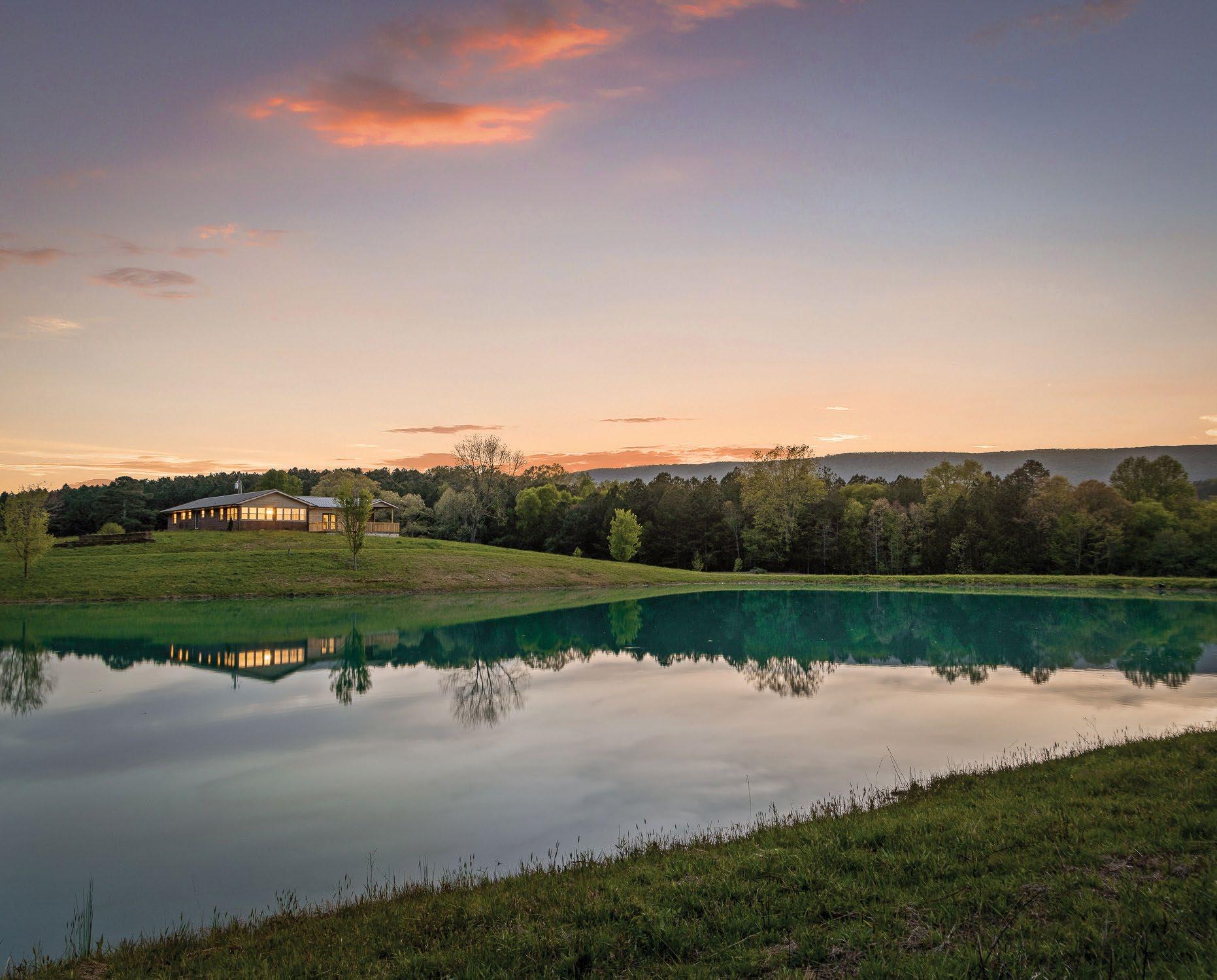

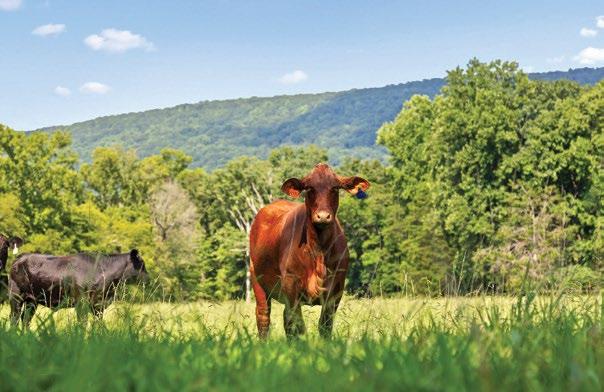

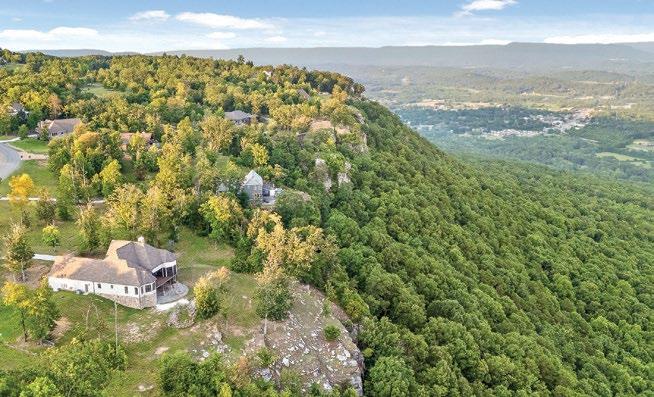


With the over 2,000-mile-long Appalachian Trail running through East Tennessee, and many other scenic trails in our backyard, it’s no surprise that many a Southern Gentleman has laced up his hiking boots for an adventure in the great outdoors. Completing a long-distance hike is no small feat, however, and takes plenty of preparation to pull off successfully. Here, we review important parts of this planning process and offer tips and tricks for spending extended time on the trail.
By Rachel Studebaker
Depending on which trail you choose, an endto-end hike can take anywhere from several days to months. The Appalachian Trail, Pacific Crest Trail, and Continental Divide Trail are the most popular – and longest – trails to thru-hike, while plenty of other trails await if a shorter hike is more your speed. In addition to trail length, consider when you’ll be going, how you’ll get there, and what the weather will look like. Once you’ve decided on your trail, purchase a physical map or download a smartphone app that provides offline navigating, making sure to pack a portable charger.
Since you’ll be carrying all your gear, it’s best to pack as light as possible. Consider the weight you’d be comfortable carrying –a good rule of thumb is to keep your pack at no more than 30 pounds – and then tally the weight of your gear as you decide what to bring. Many outdoor outlets sell extra lightweight gear, such as tents and sleeping bags, made especially for backpacking.
For shorter hikes, you can plan to pack all of the food you’ll need. For especially long hikes, you can either ship food to post offices along the trail or plan to resupply at grocery stores as you go. In either case, calorie-dense and protein-rich foods are the best fuel, since hiking burns an average of 400 calories each hour. Granola bars, nuts, dried fruit, and jerky are popular snacks, while freeze-dried meals are a lightweight choice that can be rehydrated come
mealtime. When it comes to staying hydrated, a water filtration device can turn natural water sources into safe drinking water.
Opt for clothing that is comfortable, breathable, and adds little weight to your pack. Layers are a great way to stay cool during the daytime and warm at night, while rain gear will ensure you’re prepared for unpredictable weather. Invest in a durable pair of hiking boots or trail runners, and plenty of high-quality socks, and be sure to break shoes in ahead of time for a smoother start to your journey.
Long-distance hikes involve traversing miles of sometimes rugged or hilly terrain by foot while carrying extra weight in a pack. Setting aside time to train and focus on personal fitness ahead of your hike will help prepare your body for the physical challenge of continuous foot travel.
During any backpacking excursion, it’s important to not disturb the land and wildlife. Bring a disposable bag to pack trash in, and if you’re hiking in bear country, store food and scented items away from your campsite in a bear bag.
While planning is an important part of any long-distance hike, it’s also a great way to get excited about the adventure ahead. Whether you’re about to spend a week off the grid or begin a months-long excursion, prepare to enjoy the unforgettable journey that awaits.


A GLIMPSE INTO THE SCENIC CITY ROWING SCENE
With abundant waterways and mountainscapes, Chattanooga is home to a diverse and enthusiastic set of athletes who take advantage of the many outdoor sports on offer in the region. One sport in particular draws thousands of spectators to downtown Chattanooga each fall for a two-day racing event. Enter rowing, one of the most storied competitive sports and one that’s available to Chattanoogans in our own backyard.
By Tory Irmeger


“For some of these students, trying to get them out of their comfort zone is a challenge, but it’s one that I think our coaches embrace really well. There’s still a level of education you have to do, but when the guys come and they try it, they really like it. You’re outside, you’re working hard, you’re with a great squad of teammates, and that’s what really keeps them coming back.”
Sean McCourt, Head Rowing Coach, McCallie School
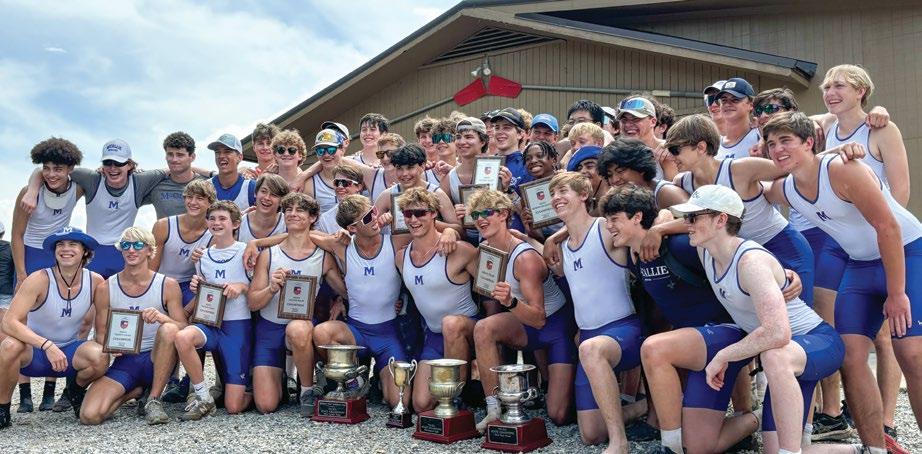
Rowing, sometimes referred to as “crew,” has a rich background, originating in its modern form around the 19th century. It was at this time that competitive rowing in six- or eight-oar boats began to emerge among clubs and university athletic programs, beginning in England and followed by programs in the United States. The first Harvard-Yale regatta in 1852 is heralded by many as the origin point of competitive rowing in the States, establishing rowing as the oldest intercollegiate athletic event in the country.
Bringing the sport to the Scenic City, however, is a different story. Establishing a notable rowing scene in Chattanooga was many years in the making. In 1974, a group of motivated and passionate athletes banded together to form Lookout Rowing Club (LRC), a public rowing club now operating out of the facility of nonprofit Chattanooga Rowing. This combination of adult rowers and University of Tennessee at Chattanooga (UTC) faculty and students garnered traction for the sport, and over the next 20 years, local schools Baylor, McCallie, and Girls Preparatory School (GPS) would launch
their own rowing programs for student athletes. Since its inception, Chattanooga Rowing has expanded to offer a Chattanooga Juniors Rowing (CJR) program for high school students as well as an adaptive/para-rowing program.
Henry Magnuson, president of Chattanooga Rowing, reflects on the visionaries that brought the sport to Chattanooga. “Those in the rowing community definitely are standing on the shoulders of those who came before us,” he says. With access to these programs, athletes of any age and gender can access the sport to pursue competitively, from a regional to an international level.
As the rowing community in Chattanooga began making waves in the ‘90s, the Scenic City drew the attention of rowers from around the country. In anticipation of the 1996 Summer Olympics in Atlanta, the U.S. Women’s Team relocated to Chattanooga to train out of the newly built, state-of-the-art rowing center named in honor of William G. Raoul, a pioneering member of the LRC.
mpire BelleWether provides urban sophistication with a touch of tranquility. Located in the bustling Northshore area, our new townhomes offer contemporary designs, luxurious finishes, and a prime location. Enjoy the convenience of city living with nearby shopping, dining, and entertainment, all while retreating to the comfort of a stylish and serene home.


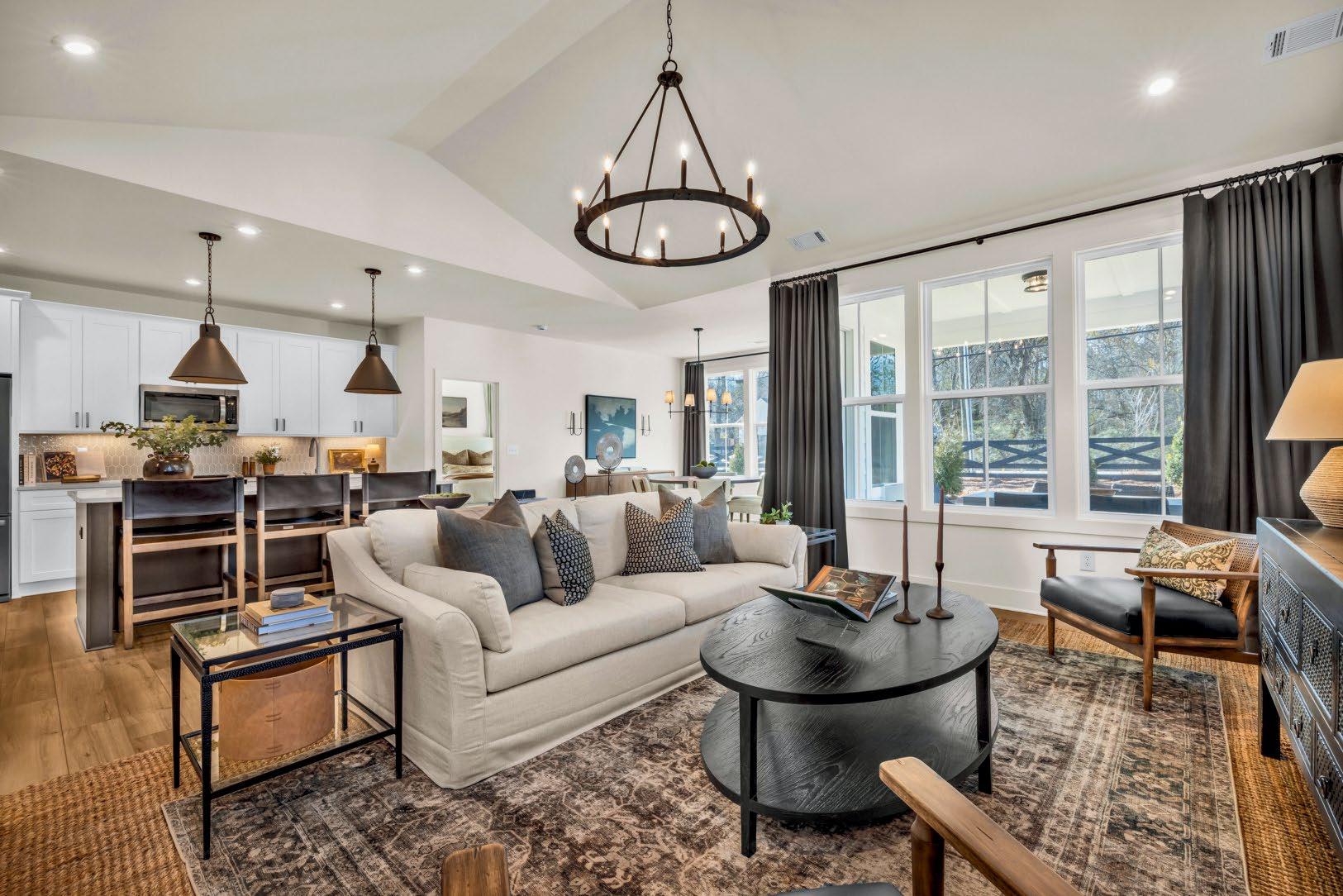

mpire Social Circle in East Brainerd offers a unique circular layout that fosters social interactions and a sense of balance. Enjoy modern living with amenities that bring neighbors together, creating a vibrant and welcoming neighborhood. Come home to where community and comfort meet.

Two years later at the World Rowing Championships in Finland, the women’s eight, four, pair, and lightweight pair won gold, and the U.S. Women’s Team went on to take two silver medals at the 1996 Olympics.
From Olympians to amateurs, every rower in Chattanooga gathers around the same focal point: the Tennessee River. “Access to the river is essential to our sport,” shares Magnuson. “We’ve learned to get up early in the morning to get on calm, flat water and avoid other boaters for safety. We appreciate those who work to keep the river clean and healthy.” The overall length of the river is a huge asset to rowers, while the temperate seasons of the Southeast are hard to beat. The setting draws athletes from all around the world to train and compete in Chattanooga, including summer programs like the U.S. Rowing Youth Development Camp.
“Regardless of one’s age, Chattanooga offers some of the best entry points to the sport of any city in the Southeast,” says Anders Swanson, former head rowing coach at Baylor School and GPS. Swanson’s father, Richard, founded the McCallie rowing program, so Swanson was introduced to crew at an early age. “I grew up surrounded by the sport and traveled frequently with the McCallie team to various regattas. Learning the sport in an environment surrounded by world-class athletes and coaches was truly a gift,” he says. This experience opened doors for him to row at Princeton University, which included a once-in-a-lifetime opportunity to compete in the Henley Royal Regatta in England, the most famed rowing race in the world.
In 2005, nearly 30 years after the establishment of LRC, a new tradition was established in Chattanooga: The Head of the Hooch® regatta. Held annually on the first weekend in November, this regatta is a 4,500-meter race that draws over 6,000 athletes and 20,000 spectators to Ross’s Landing for the two-day event. Touted as one of the world’s largest rowing regattas, the Hooch originated in North Georgia as the Head of the Chattahoochee, operated by the Atlanta Rowing Club, beginning in 1982. In 1997, the regatta moved to the Lake Lanier venue constructed for the 1996 Olympics, but as the race continued to grow, the Atlanta and Chattanooga rowing clubs collaborated to relocate the regatta to downtown Chattanooga. The name “Hooch” remains an homage to the Chattahoochee River where the regatta first began.
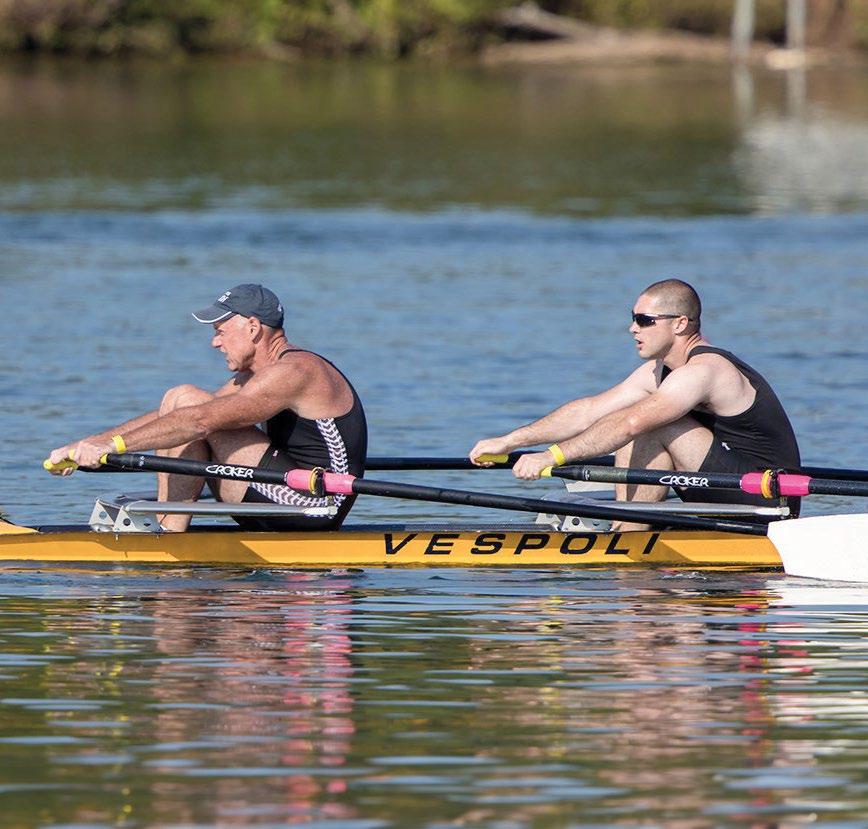
“As an endurance sport, the real prediction of how you are going to perform is how much work you have put in on practice days. As I’ve gotten used to that, I have relaxed more on race day. The best part of a competition is to see and compete against old friends.”
Henry Magnuson, President, Chattanooga Rowing



“The Head of the Hooch regatta brings a festival atmosphere to downtown Chattanooga every year,” shares regatta director Mike Connors. “Energy is at a fever pitch on race day, combining excitement, anxiety, celebration, disappointment, and exhaustion, all of which bond us as a community and create lifelong friendships. Not to mention that for us old timers, events like the Head of the Hooch are opportunities to catch up with old friends, teammates, and fellow competitors – it’s awesome!”
The Head of the Hooch® will celebrate its 20th anniversary in 2025, and it is only possible thanks to the efforts of hundreds of volunteers, as well as TVA, who came on board as the first title sponsor in 2022, and other partners Outdoor Chattanooga, Chattanooga Tourism, and The City of Chattanooga. “There is no better showcase of our downtown and the significant investment the city made in the waterfront area,” Swanson adds. “Every conversation I’ve had with visitors during the Hooch includes enthusiastic feedback on how impressive Chattanooga is.”
Rowing is a deceptively challenging sport: the movements engage every large muscle group in the body, the five to eight minute races require physical and mental endurance, and the team must be coordinated in each movement to row effectively. Mastering rowing requires perfecting technique as well

as committing to hours on the water and on the erg machine. Any coach will add, however, that a successful crew must amount to more than the sum of its parts.
“I’ve always believed that a successful rowing coach must do more than just teach the sport,” shares Swanson. “There are lessons and values inherent to rowing that are more important than having the best training plan or technique. I take great pride in hearing athletes I’ve coached share how formative the sport was for them, and how deeply they value the bonds made with their teammates.”
Baylor School director of rowing Garrison Smith had grown up playing hockey and baseball and didn’t begin rowing until he attended Yale University. After he decided to give rowing a try, he went on to compete with crews in the U.S. Olympic Festival and the Royal Canadian Henley Regatta. “Winning in rowing is somehow better than in any other sport,” Smith says. “I don’t know whether it’s the amount of training you do for a very short race or the competitive nature of the sport, but when a boat moves well together, it’s pretty amazing.”
Smith recalls a particular race where he hit a wall only two minutes in: “With eight other guys depending on me, I had to figure out a way to push through what I thought were my limits. I think that’s one of the things that rowing really brings – you learn to push beyond what you think you can do, which is really a life lesson.”

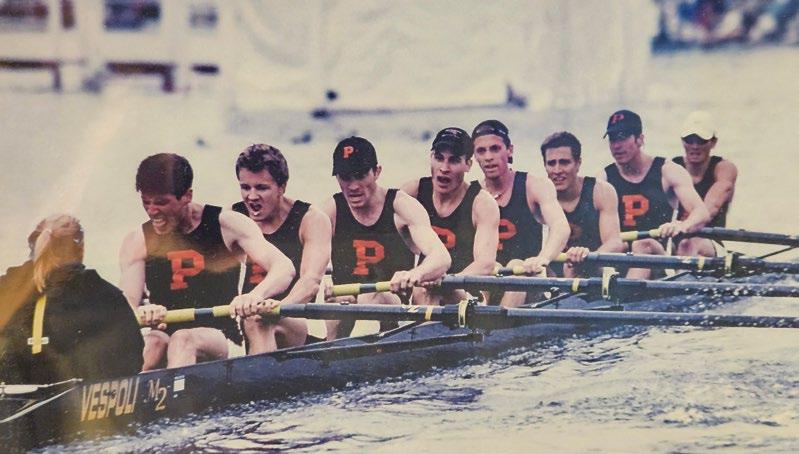
“Chattanooga’s natural resources are extraordinary, and rowing is one of the best ways to enjoy these gifts and see parts of our city that often go missed. Seeing the sunrise from the Tennessee River is hard to beat!”
Anders Swanson, Former Head Rowing Coach at Baylor School, GPS, and Choate Rosemary Hall (Wallingford, CT)
Once they’re on the water, crews can’t “bench” team members who are hitting a mental or physical block. This interdependence sets rowing apart from other team sports, creating a connection among crews that can be hard to replicate. Swanson echoes this sentiment, saying, “You must match up with your fellow crew members in near perfect unison, which requires constant concentration and compromise by each individual. The success and failure of each crew is dependent on their ability to follow each other, and being in a boat that ‘clicks’ is an experience that is hard to put into words – it is almost transcendental.”
Even as the sport continues to grow in the Chattanooga region, local coaches often have the joy of exposing rowing to students for the first time. “My favorite thing is athlete development,” says Sean McCourt. Originally from Philadelphia, McCourt began rowing in high school before continuing to the collegiate level at Boston University and later trying out for the U.S. Men’s Team. Through rowing, McCourt met his wife, Megan Dirkmaat McCourt, who is a six-time member of the U.S. National Rowing Team and silver medalist in the 2004 Olympics. The husband and wife duo coach at McCallie School.
McCourt says, “Rowing is different from all other sports in the sense that you don’t typically do it from the time you’re 5 years old. I love seeing guys come in who maybe have never even seen a [racing] boat before, and then in four years they could walk out and become a Division I athlete or have had an experience that they wouldn’t have gotten to do otherwise.”
While the Southeast may not yet have the same rowing precedence as its Northeastern neighbors, the Scenic City is ripe with potential for aspiring athletes. The growth of public access programs is one avenue for this, McCourt says. “I came from a public access program at the Olympic Rowing Center, and it was great for building community. By the time I left, we had representation from around 30 different high schools. I look at what’s possible here in the city of Chattanooga, and the river can offer a space for that.”
Rowing offers an experience that draws people from all backgrounds – those who may not be players in more popular team sports can soar to success on a crew, even despite a late start. “Rowing isn’t always about having the biggest muscles as much as it is about using your muscles the right way to leverage the boat through the water,” Smith adds. “Not every student loves rowing, but there are a lot of kids who are athletic, and maybe they’re athletic in a different way. When they try rowing, they really fall in love with the sport.”
The same goes for adults who come to the sport later in life. With the support of local clubs and coaches, novices can advance to compete in the Head of the Hooch® in a manner of months. How to get to that point? Put in the hours, according to Smith. “Rowing has a pretty direct relationship with improvement, whereas with other sports, it’s a little more amorphous. If you’re willing to put in the time and the meters, you’re going to get faster.”
Whether starting at the junior level or getting on the water recreationally, rowing is a sport for life. Rowing can take athletes to regattas across the world or simply allow locals to experience Chattanooga in a new way. Locals interested in taking up the oars can connect with Chattanooga Rowing to learn more about the programs available for differing ages and abilities. Gold medals are never guaranteed, but lifelong memories and friendships are sure to be found on the water.

“I think rowing is really the consummate team sport. Everybody is so interdependent on one another, and that develops this kind of connection. You may not like everybody in your boat, but you have to trust everybody in your boat and work together, or you’re not going to have a very fast crew.”
Garrison Smith, Director of Rowing, Baylor School
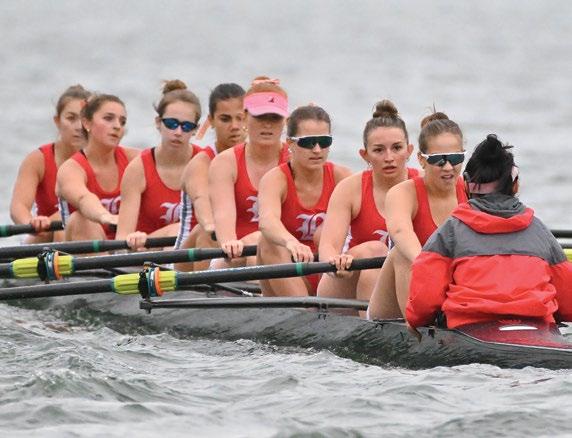

Lookout Rowing Club (LRC) is established by Chattanooga community members and UTC students and faculty
McCallie School rowing program begins
Baylor School rowing program begins
LRC coordinates the first annual Chattanooga Head Race | Chattanooga Junior Rowing program begins | William G. Raoul Rowing Center opens | U.S. Women’s National Rowing Team trains in Chattanooga for the 1996 Summer Olympics
GPS establishes rowing as a varsity sport, becoming the first school in the Chattanooga area to field a girls’ team
U.S. Women’s National Rowing Team takes two silver medals in the Summer Olympics in Atlanta
U.S. Men’s Eights team, including UTC graduate and former McCallie coach Dan Beery, wins gold at the Summer Olympics in Athens, Greece
Head of the Hooch® regatta moves to Chattanooga
GPS – McCallie Rowing Center opens as a 15,000 square foot world-class facility that can accommodate over 100 athletes
Head of the Hooch® regatta to celebrate its 20th anniversary in the Scenic City

WHAT’S YOUR FAVORITE ASPECT OF THE SPORT?
“That’s easy – it’s the camaraderie of the sport and the many relationships I have developed through the years. Rowing friendships are lifelong friendships.”
Mike Connors, Regatta Director, Head of the Hooch®, Vice President & Rowing Director, Chattanooga Rowing

“A GENTLEMAN IS ONE WHO PUTS MORE INTO THE WORLD THAN HE TAKES OUT.” – GEORGE BERNARD SHAW

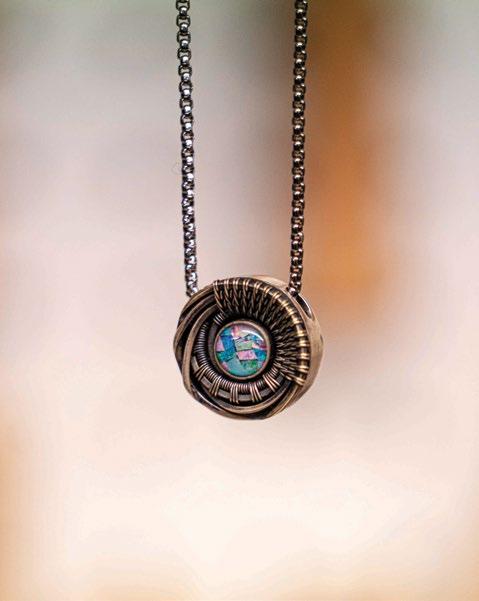
From sculptures and signs to jewelry and more, there’s no shortage of things that can be crafted with metal. Here, we talked with five skilled artisans in the Chattanooga area to find out what makes metalworking so special. Read on to learn how they began their journey in metalworking, what types of products they make, and any advice they have for aspiring artisans.
Can you describe your journey with metalworking?
In 1997, I signed up for an AutoCAD course at a technical school in Athens, TN. Not enough students registered for the class, so it was canceled. I was asked if there was anything else I would like to sign up for. I looked at the list they gave me and picked welding. I had always have been fascinated with metal sculpture because of the strength and flexibility of the material. It can be both massive or delicate. I picked up the welding process pretty quickly, and once I learned the basics, I started making sculptures out of the scraps in the shop. Everyone else was there to get a certification. I was there to have fun!
How would you describe your style?
Most of my work would be considered whimsical. I like to have fun and be surprised with the final results. I like it when people smile when they see something I made. Cheering people up is not such a bad thing. They already get too much information on the problems in the world. I don’t try to make political or social statements with my work.
What types of products do you make and why do you gravitate toward those?
I like to make representational animals, insects, people, reptiles, and other original creatures. I am also interested in experimenting with abstract sculptures.
What advice do you have for aspiring artisans?
Work every day and get your work out to as many eyeballs as possible.
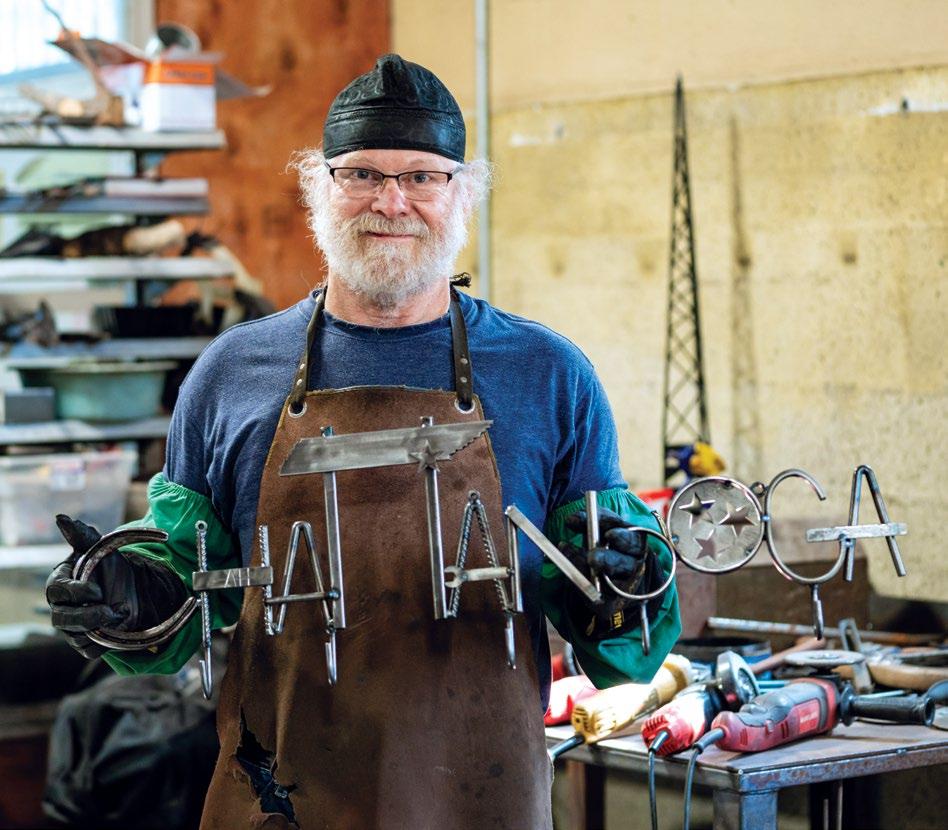
What draws you to the art industry?
I think I was born to be an artist. I have tried other things, but they were never really successful. There have been times when I have been very poor, but somehow, I have always been able to make a living selling my work. I try to do the best with what I have. I have made thousands of objects over many years. I have found that eventually the right person will come along and purchase something that I have made. Even though most of what I do serves no practical purpose, I like the thought that there will be things that I have made out there that people will still enjoy when I am gone.
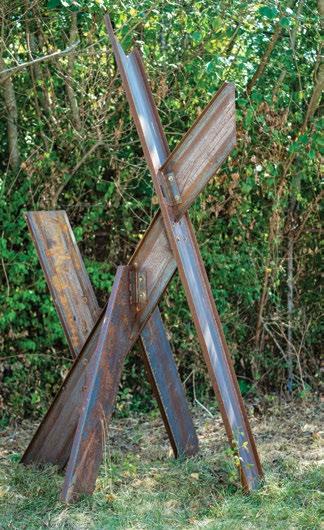


Can you describe your journey with metalworking?
I attended Chattanooga State’s welding program. Soon after, I received a job at Astec Industries, where I worked for 36 years. While at Astec, a large part of my job was welding and fabrication. One day my wife, Kathy, asked if I could make a metal table if she drew up the plans. The table was a gift for a friend’s retirement party. Everyone loved it and wanted one. As we started making tables, Kathy was always asking, “Can you weld this metal to that metal?” and that's how we got the name Mixed Metal Works. At first, we had to purchase all the elements to make the tables, but in 2011 we were able to purchase a plasma CNC machine. The machine works with a drafting program similar to CAD. Kathy took classes on how to use the drafting program, and soon we were able to draw, cut, and fabricate custom pieces.
What types of products do you make and why do you gravitate toward those?
Most of our items focus on Tennessee. We have lived here our entire life and love it. We do a lot of small items that commemorate Tennessee and its cities.
What is your creative process?
We are at a point in our life where we can travel. Each time we go somewhere, we are both looking at our surroundings for ideas.
What advice do you have for aspiring artisans? Do what satisfies you. I get told, “You don't get paid enough,” but this is the endeavor that gives me and my wife time together doing what we like.
What is one misconception about metalworking and what do you want people to know about the craft?
It’s more than putting two pieces of metal together. You have to know what metal will adhere to another metal as well as the welding technique to use. Artists have some leeway, but don't be fooled, you have to be precise on your measurements. When we first started, unfortunately, we had a big scrap pile.


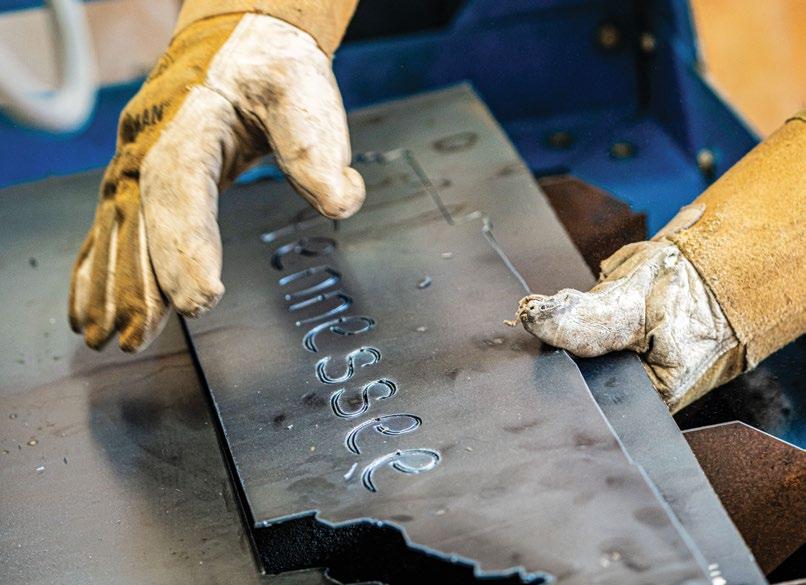


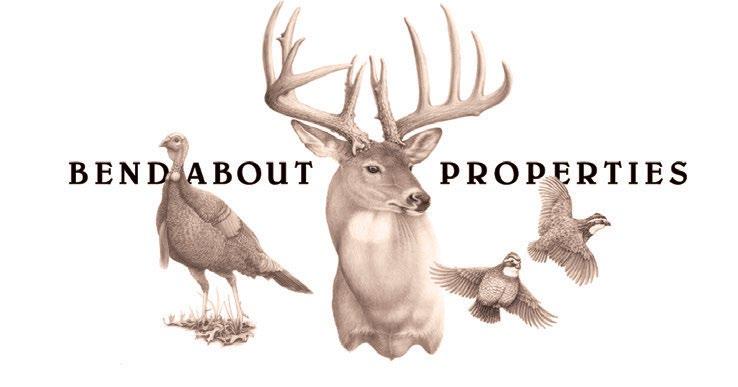
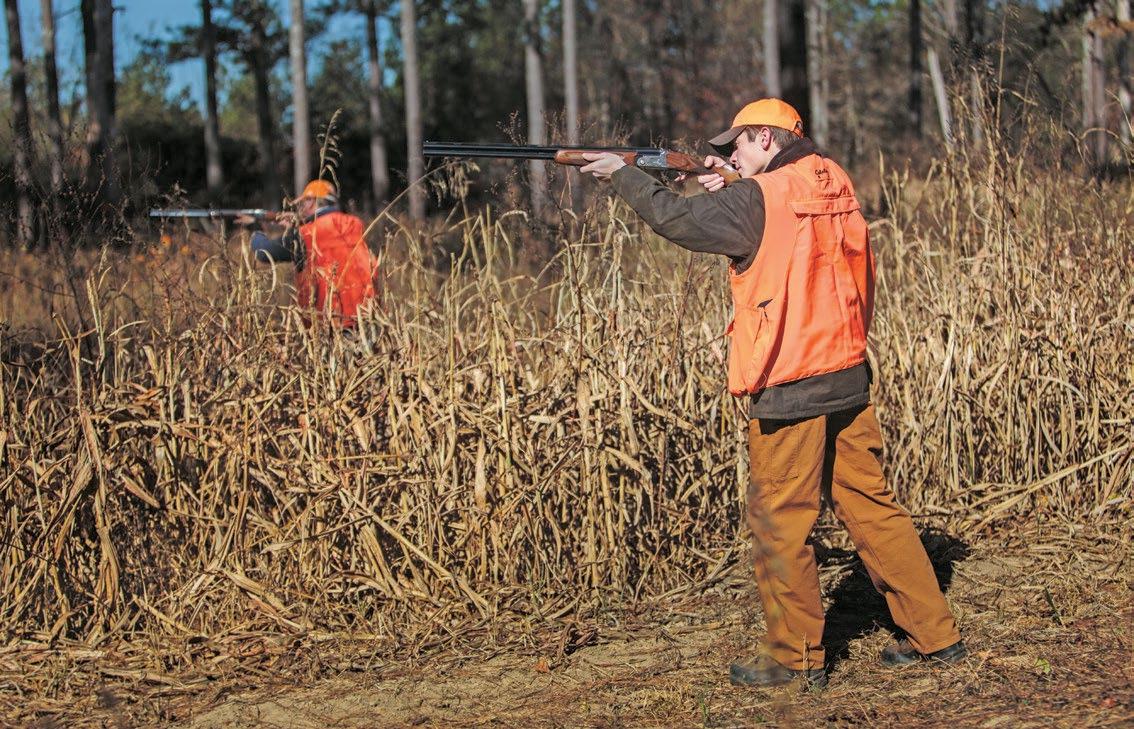


ISAAC DUNCAN III Duncan Sculpture & Services
Can you describe your journey with metalworking?
I was introduced to metalworking during my undergraduate years at the University of Notre Dame, as part of my Bachelor of Fine Arts studies. I continued my studies in the craft of welding through night courses at Dowagiac Community College in Michigan and also at Kentucky Technical Community College during my fellowship at the University of Kentucky. Non-formally, I received a lot of my metal education by making works, asking my elders for tips on how to solve certain problems, and working for renowned artists that work in metal (Richard Hunt and John Henry).
What is your creative process?
My process varies from making small sketch forms to directly creating pieces. It all depends on the intent of the piece: if it is a personal research sculpture or a commission, if I have all the materials needed or not, and if I feel like making a big piece or not.
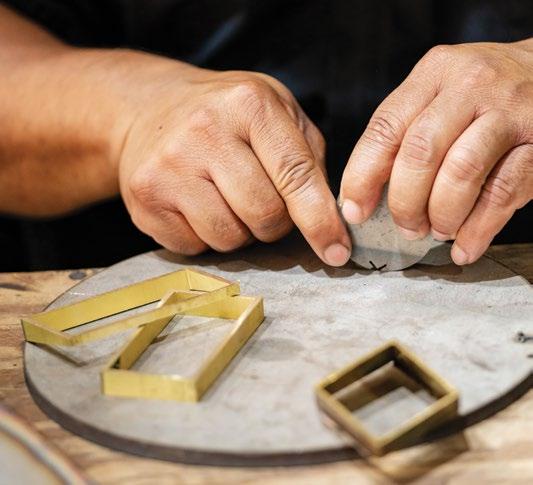
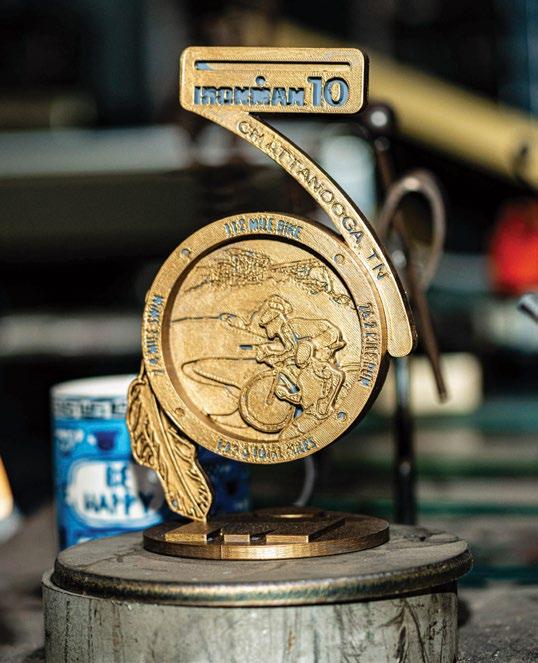
How would you describe your style?
My style is rooted in freedom, formalism, non-objective abstractions, geometry, movement, rhythm, surrealism, and phenomenology.
What is one misconception about metalworking and what do you want people to know about the craft?
There are no "hard" materials to weld. Either you have the experience/training to handle the material or you don't.
What do you love most about the work you do?
What’s the most challenging?
It does not feel like "work." Sure, it is physically and intellectually intensive but it's not a work where I am drained from social abuse. The most challenging part for me is not having another me (clone) to assist.
How can the public support local artists?
Don't let perceived expenses keep you from investing in what you would like to have. If you like a piece that is marked out of your range, ask the artist if they have anything in your budget range. It does not hurt to ask.
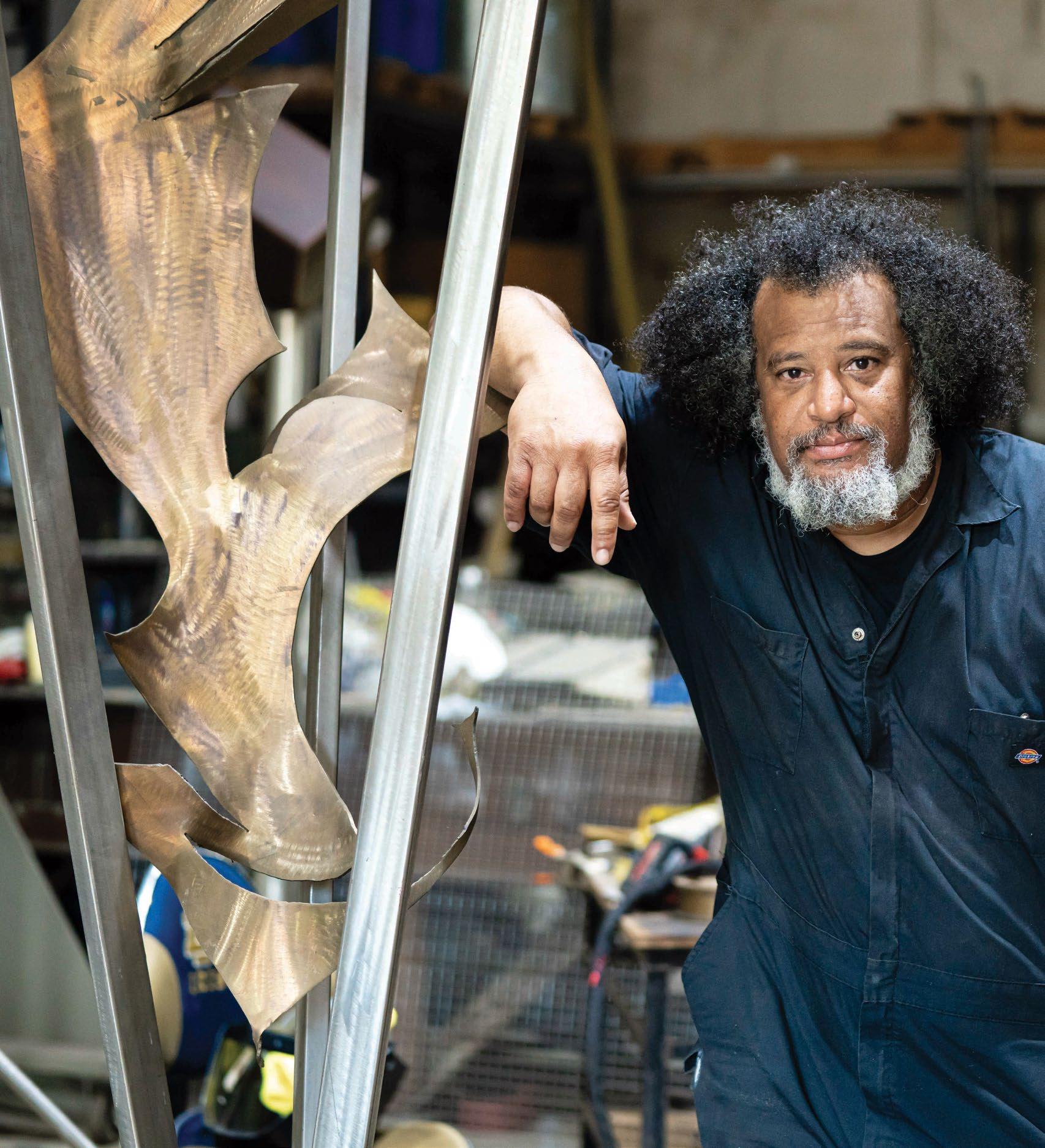

How would you describe your style?
My work demonstrates a range of style, but generally speaking I would describe my jewelry as having a clean and modern silver aesthetic. I also strive to create jewelry with a style that can be appreciated and worn across genders.
What types of products do you make and why do you gravitate toward those?
My flagship product has and likely will always be pendants. When I first started creating jewelry, I made pendants almost exclusively. But these days my available work includes items like pendants, rings, bracelets, earrings, money clips, and tie clips.
What is your creative process?
I'm always looking to draw inspiration from the world around me for jewelry ideas. I keep a running note in my phone with creative ideas for jewelry designs. Once I have an idea in mind, it's just a matter of forming the metal and setting the stones to fulfill the vision.
What’s your favorite aspect of working with jewelry?
Being a jeweler connects me to a
rich and long history. From ancient amulets to modern engagement rings, each piece tells a story and carries significance beyond a purely aesthetic appeal. Working in this industry means that I am a part of a tradition that spans centuries, bridging past and present through creating wearable art. Each era of humankind has been adorned with its own styles of jewelry, and my work is an integral part of this ongoing narrative. But jewelry is about so much more than simply adornment – it's about identity, legacy, and human expression.
What is one misconception about metalworking and what do you want people to know about the craft? That would be pricing. The market value of metals and gems are often misunderstood by the public.
What advice do you have for aspiring artisans?
Embrace the failures and mistakes along the way! No one does anything right the first time. Just start. Don't accidentally sit on your hands and allow yourself to never start. Even practicing a new skill just 30 minutes per day will show you tangible results quickly!
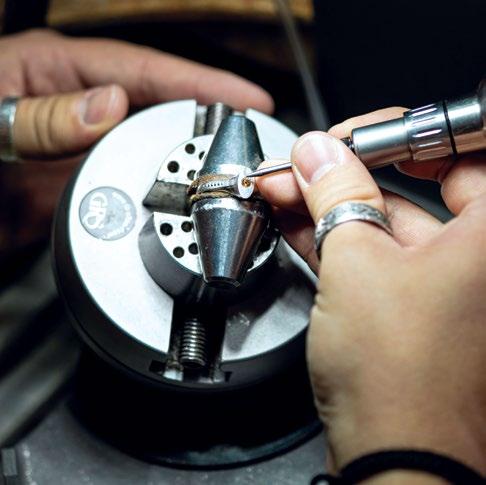


John Sterner was ranked by Forbes as the #1 Financial Security Professional in TN and #46 nationwide. Al Waldrop was ranked #4 in TN on the Best-in-State list.
Northwestern Mutual is the marketing name for The Northwestern Mutual Life Insurance Company (NM) and its subsidiaries in Milwaukee, WI. BrightView Capital is a marketing name for doing business as representatives of Northwestern Mutual. Northwestern Mutual Private Client Group is a select group of NM advisors and representatives. BrightView Capital and Northwestern Mutual Private Client Group are not a registered investment adviser, brokerdealer, insurance agency, federal savings bank or other legal entity. Ranking Published 7/10/24. Data as of 12/31/23. No compensation provided for ranking. Licensing fees apply to use Forbes logo. Research and ranking provided by SHOOK Research, LLC. Rankings and recognitions are no guarantee of future investment success.

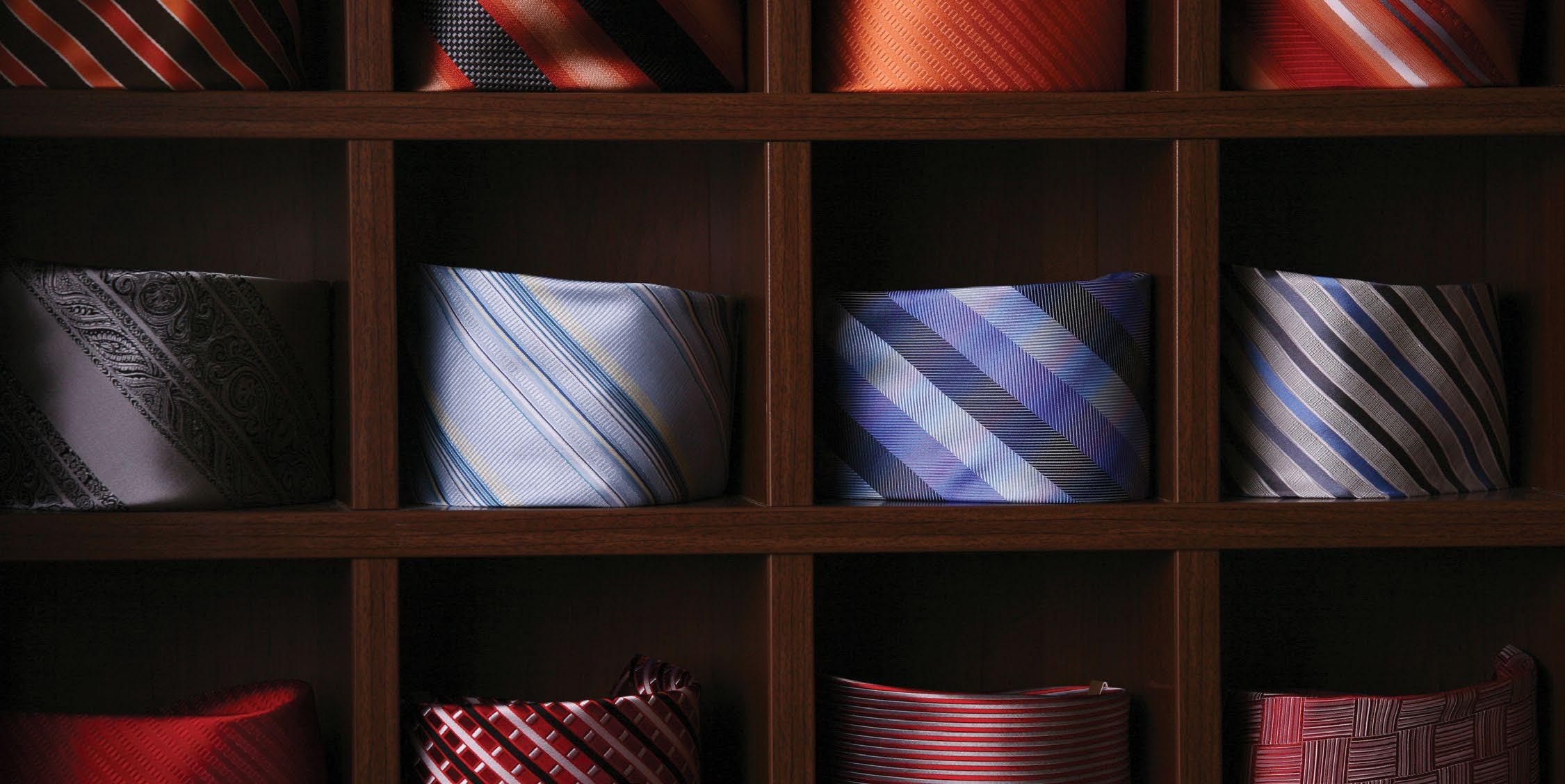
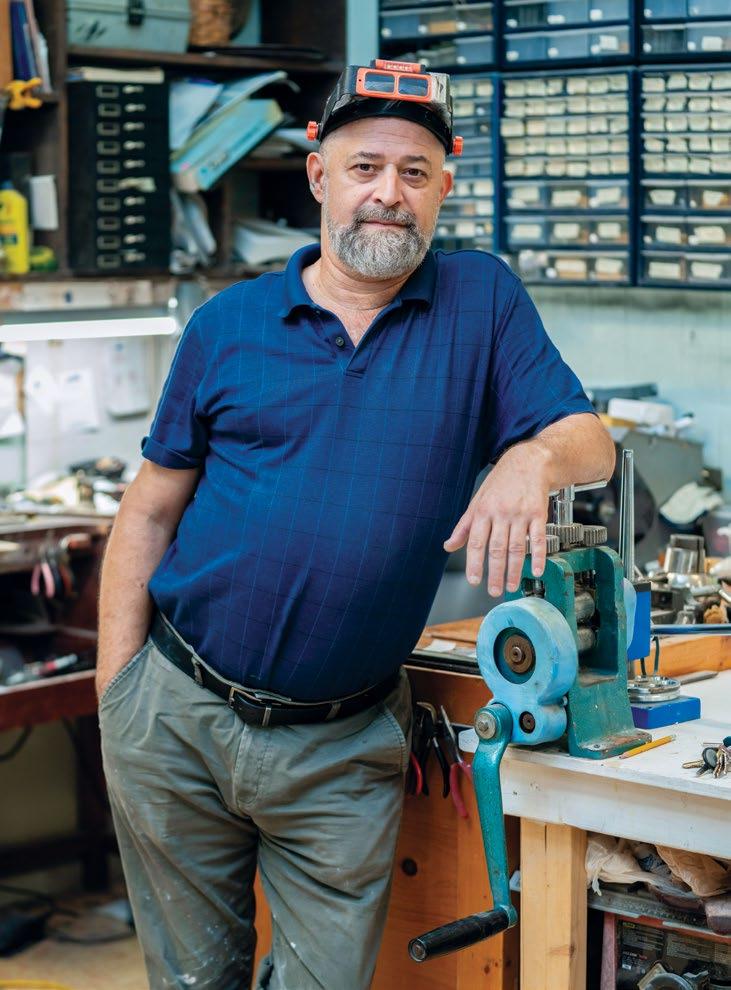
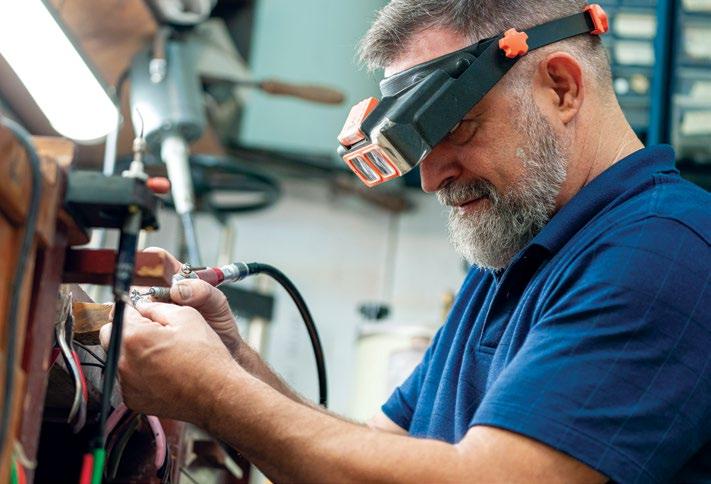

What types of products do you make and why do you gravitate toward those? I am blessed to be able to work in all kinds of disciplines, but have focused on silver and gold jewelry. Rings and pendants have been what people want; coming into my place they can have about any design they want. I sit with the customer, try to hammer out what they want, and make a lot of drawings until we hit on something. People come to me to get things they can’t find other places.
Which piece has been the most challenging and why?
Trying to make mainstream rings and pendants has been challenging, most of which are produced with machine, whereas I’m carving by hand using dentist tools I’ve had for over 30 years. People want me to carve and produce what they see in the stores.
How would you describe your style?
My style is not for everyone, as far as my personal work. I enjoy Celtic work and jewelry that to some might be considered a little over the top. I’ve had a couple of customers refer to some pieces as a bit too sculptural.
What is your creative process?
A lot of drawing, settling on a design, and then making a big mess in the floor carving the wax, but the hardest part is finding the time to focus and get it completed.
Do you have any memorable moments from any of your projects that you’re willing to share?
Every piece has a story. There’s the dogwood cross that is made for a group of wonderful ladies that symbolizes their passing from one stage of their lives into a new one. There is the men’s wedding band that had the groom’s father’s ashes inlaid in a band around the center because his father passed away a couple of weeks before the wedding. The special promise ring for a 16-year-old from her father that was also the first diamond she had received. The men’s ring with a hidden Scripture on the inside for a man that provides help to individuals that are in places that jail people for their beliefs. Over the years, there have been so many stories. I could go on and on.









Photography by Kristina Armstrong / On location at The Edwin Hotel
While every Southern gentleman walks a unique path, an underlying dedication and determination fuels each journey. A variety of people, principles, and passions come together to influence us along the way. In their own words, five men share the experiences and values that have guided them to where they are today.
I grew up in Carrollton, Georgia, shaped by the influence of my family – my mother, a dedicated community college educator in adult education, and my father, both a university dean and a United Methodist pastor. They taught me the importance of hard work, compassion, and the pursuit of self-improvement. These values have guided me in my role as vice president for organizational culture and engagement at Chattanooga State Community College. My journey is anchored in empathy, resilience, and a deep respect for every individual’s unique story. I lead with an open heart, committed to understanding, grace, and creating inclusive spaces where everyone feels valued. By embracing our shared humanity, I aim to uplift others, fostering environments where a profound love for all people serves as our common guiding light.
Dr. Quincy Jenkins Vice President of Organizational Culture and Engagement, Chattanooga State Community College

Having lived in every Southeastern state before moving to Tennessee, I have been mentored by many who have instilled upon me a deep sense of what it means to be a “gentleman.” My parents taught me to be considerate and respectful of others and, above all, to “mind your manners.” During my early years, I thought “yes, sir” was a single word. "Yes" or "No" standing alone was not an option. I have been fortunate to have practiced law in Chattanooga for over 48 years. The adage that “no matter how flat the pancake, there are always two sides” has guided my legal career. Treating others with respect and with an understanding of their views are keystones to being a gentleman. My wife and I are blessed beyond measure to have raised our two sons in a faith-based community. I am grateful to God for those who have touched my life and have shaped my journey.
Bill Godbold Attorney, Leitner, Williams, Dooley & Napolitan, PLLC







I am grateful for those who have invested in me and modeled what it means to be a faithful husband, dad, worker, friend, and leader, all grounded in my faith in Jesus Christ. Despite my selfish pride, desire for control, and pursuit of significance, I learned unconditional love and respect from my parents, grace and resilience from my bride and our three kids, the importance of prioritizing family from my siblings, grandparents, and extended relatives, and the privilege of serving others from my teachers, baseball coaches, coworkers, pastors, friends, and mentors. As a Chattanooga native, I am thankful for the opportunity to graduate from McCallie School and UTC, and to serve two impactful organizations with remarkable people, cultures, and communities: Southern Champion Tray, where I learned “To serve customers . . . in ways that value people and glorify God,” and McCallie, where I learned "honor, truth, duty" and "Man's chief end is to glorify God and to enjoy Him forever.”
T. W. Francescon, Jr. Senior Director - Alumni Culture & Engagement, McCallie School










I am a native Chattanoogan. Genera tions of my family have lived in East Tennessee since the late 1700s. Most days, I am a practicing employment law attorney. I also love studying and sharing the rich history of Chattanooga and its people. This was fos tered early on by my parents, who en couraged a love of reading. I also re call with great fondness hours spent listening to my grandparents spin tales of our family’s history in this area. That foundation was built upon by wonderful, dedicated teachers and professors who actively pushed a love of education – to name but a few: Helen Murray at The Bright School; Cleve Latham at McCallie School; college English professor Bill Engel; and law professor Rebecca White. Each of these individuals went well beyond teaching the nuts and bolts of a specific topic; they took a special interest in their students, encouraging curiosity, creativity, and confidence in one’s self. My path has led me to where I am because of all of these people, and for that I hope they know how very grateful I am.
Maury Nicely Attorney, Evans Harrison Hackett PLLC



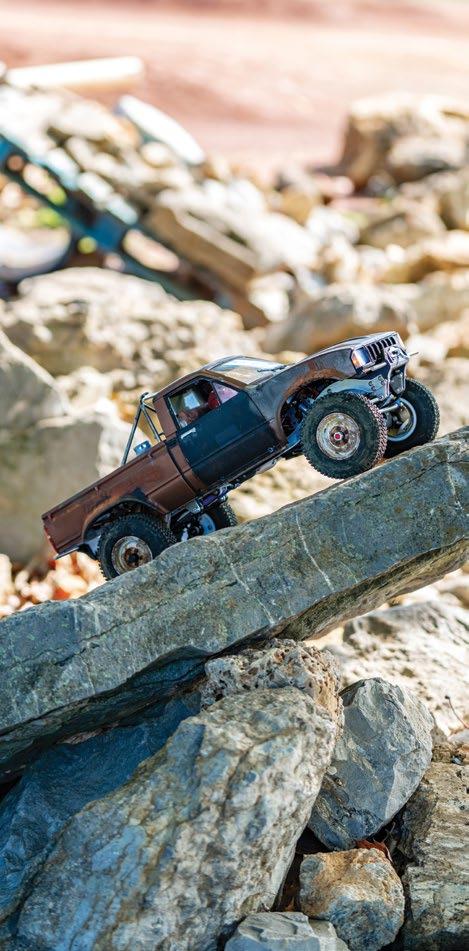
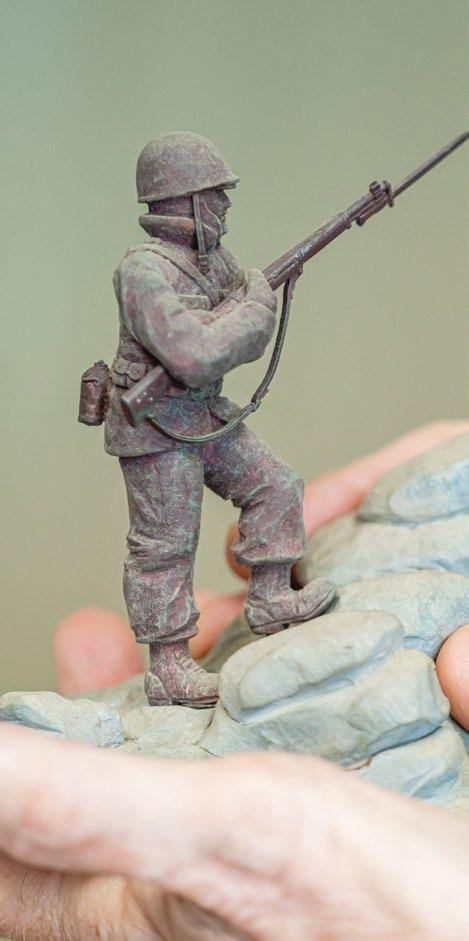
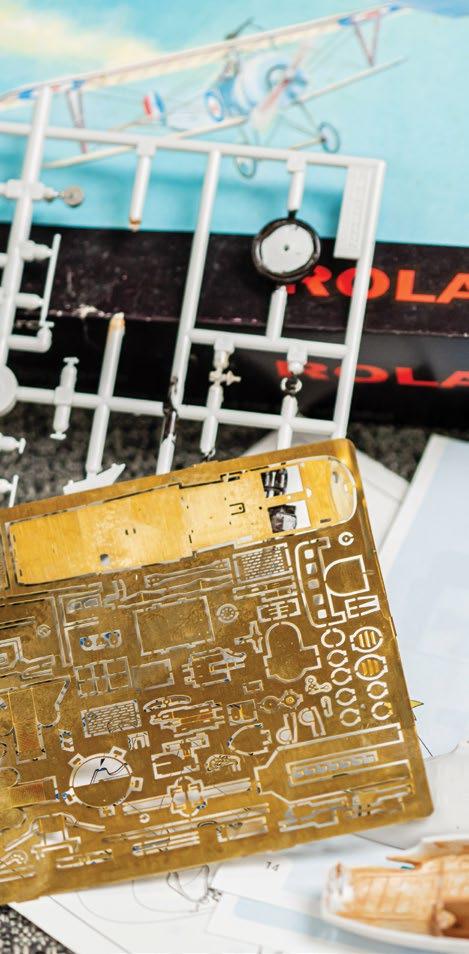
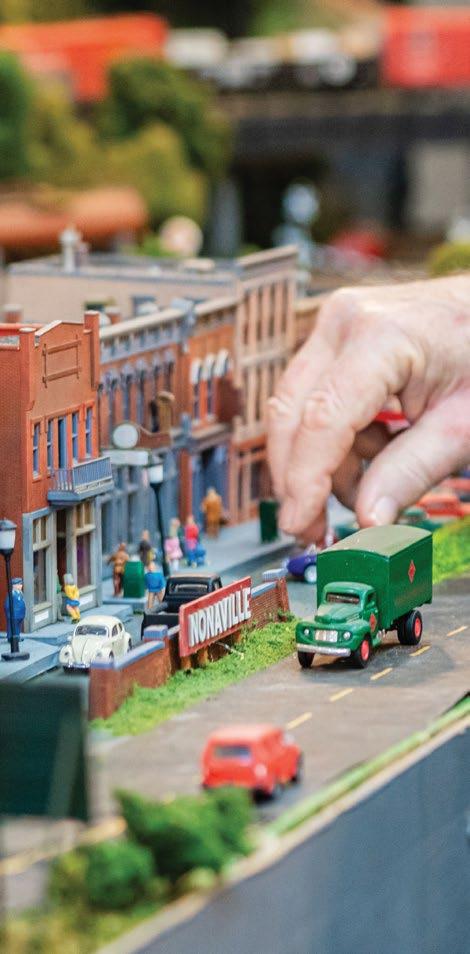

What does it take to see the world in miniature? For model builders, a passion for the craft and a keen eye for detail are key to bringing imagination to life. Despite working on the small scale, this hobby requires a wide array of skills ranging from the technical to the creative, not to mention the time spent researching materials, history, and construction techniques. Here, we get some insight into the different realms of four local model builders as they share how their craft is a gift that keeps on giving.
Photography by Vityl Media
Notable composer Dr. David Holsinger also boasts an impressive hobby: model trains. Over the past 25 years, he has built, torn down, and rebuilt five different layouts, each stocked with fun, personalized details, which he shares often with his grandkids, friends, and students.
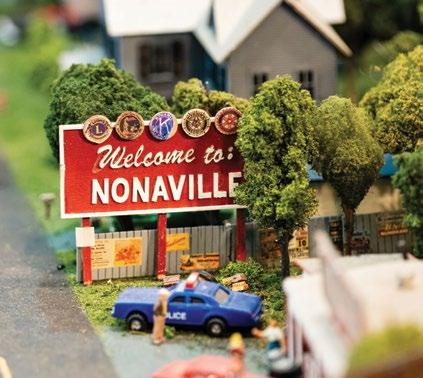


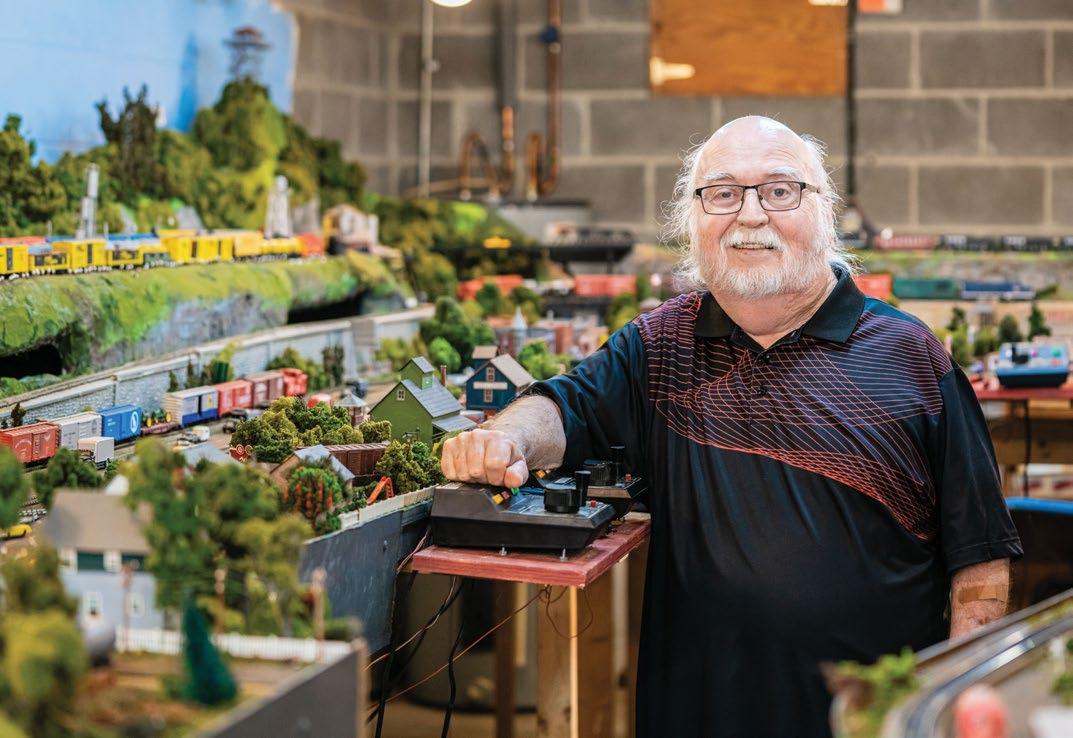
WHAT PIQUED YOUR INTEREST IN TRAINS?
I grew up in a small town in north central Missouri. The main Santa Fe and Wabash lines between St. Louis and Kansas City ran right through the middle of my little farm community. On those four tracks, over 85 trains a day barreled through town. From my upstairs bedroom window, I watched as those freights and passenger trains of the ‘50s and early ‘60s roared across the countryside just a half mile from my house, so my fascination with railroads started long ago.
TELL US ABOUT SOME OF YOUR FAVORITE PIECES YOU'VE BUILT. One thing I really enjoy is actually the natural scenery. The present layout contains 2,400+ trees. A number of years ago, I concentrated on farmland and built over 8,000 individual corn stalks from toothpicks, Elmer’s glue, and chopped up raffia ribbon. Of course, it's also fun building up mountains and hillsides with paper mâché over chicken wire forms.
ARE THERE ANY INTERESTING ELEMENTS YOU'VE INCORPORATED IN YOUR MODELS?
The main namesake on my layout is my wife. The town is called Nonaville, the grain elevators are part of the Nona County Cooperative, and I also have a Nona County diamond mine. There are some tongue-in-cheek references including the Hoffa Cement Plant, the Soylent Red Snack Food Factory, and the Acme Building – exclusive distributor to Wile E. Coyote. Unlike many club layouts I have visited around the country, I draw the line at adding dinosaurs in the woods!
WHAT HAVE YOU LEARNED THROUGH THIS HOBBY?
My “hobby” is actually another facet to my vocation. In Mihaly Csikszentmihalyi’s book “Creativity,” he discovered that almost all creative people formulate their ideas in a controlled environment, incubate those ideas in activities not normally associated with their projects, and return to that controlled environment to complete their task.
I am a composer. As it were, I sit at my computer selectively adding “small dots” to a larger expanse. A number of times, when mentally blocked, I might move to my trains and begin building some small item on my layout. Literally, I am still thinking in the context of creating “small” on larger expanse. My mindset has not really changed, and that activity is the incubation factor that stimulates the answer to my musical problem. And in my return to the controlled environment of my computer, I may solve the creative problem that I had earlier encountered.




WHAT PIQUED YOUR INTEREST IN STEAM ENGINES?
After I graduated from Kirkman Technical High School, I started my career in the machine shop business. I worked at Ortmeier Machine Company for 18 years, and then I started my own shop, which was a pretty progressive thing for years and years. A man had come in at Ortmeier one day wanting to build a steam engine, and I got acquainted with him. I started at that time building an engine, mostly under his direction telling me what to look for and how to get into it. After that, it kind of just snowballed on me. I just enjoyed building them.
WHAT GOES INTO THE MAKING OF A STEAM ENGINE?
I see something I like and I'll acquire some kind of a blueprint or a picture, and then I build the engine off of it. I started out doing casting sets of stationary steam engines, and then later on in life I decided those were too expensive, so I started just building off the print. Having the machine tools here, I can make all these up in my shop.
HOW DOES BUILDING ENGINES CONNECT WITH OTHER ASPECTS OF YOUR LIFE?
It teaches you patience and hones your skills if you’re doing some real fine work. You know, these things are small, and the bolt sizes are miniature. If I can make one of these engines run precisely, then it bleeds over into when I do a job for someone. That precision is right there with me all the time.
WHAT IS ONE OF YOUR FAVORITE MODELS THAT YOU'VE BUILT?
I acquired a set of castings from an outfit in England. It’s a beam-type engine, which has an arm that sits over the top of the engine that operates it. It was a very, very difficult engine to build. First of all, it was all in metric, so it had to be converted, and the parts were extremely small. It's a pretty engine, and it's a complicated engine, but it came out beautifully. The engine it’s based on actually still exists in a college over in England.
WHAT IS YOUR FAVORITE ASPECT OF THE CRAFT?
When I start into one, it’s the creation of taking a raw piece of material, cutting all the shavings away from it, and building it up from the base. With the cranks and the cylinders and the rods and the gearing and all that – just a piece at the time, and it turns into a living thing, nearly. To me, they're just like a fine-tuned instrument.
Machine shop owner Ken Oliver –known fondly by some as “Mr. Wizard” – has long been the go-to guy for all things machine repair, from plane parts to antique cars. As if that weren't enough, he took up the hobby of steam engine model making around 1970 and has made around 40 models to date. These stationary engines would have steam-powered boats, factories, and other utilities in their heyday around the turn of the 20th century.
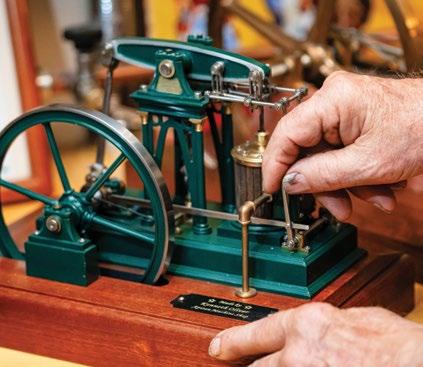






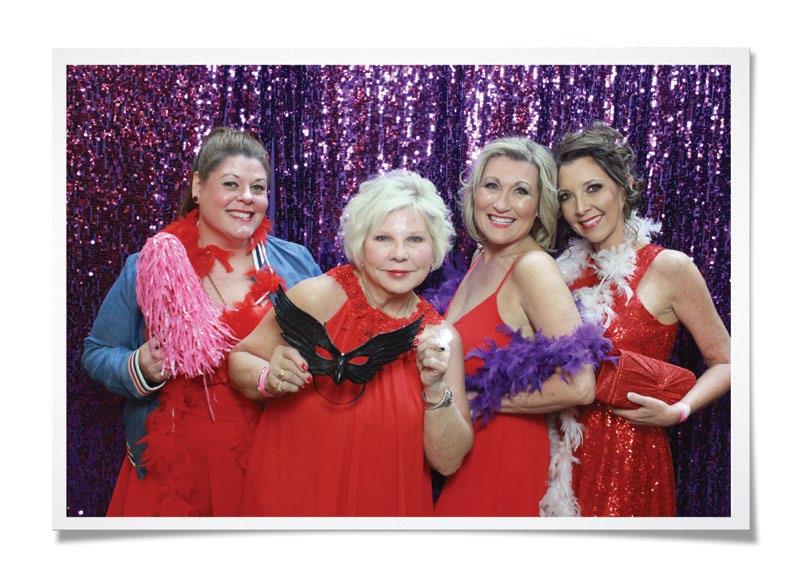
Leave preconceived notions of model race cars at the door when it comes to Chad Melton’s custom-built remote control (RC) vehicles. These models can reach up to speeds over 100 miles per hour or tackle rocky terrain, and you might notice a miniature driver in the passenger seat as they crawl by.

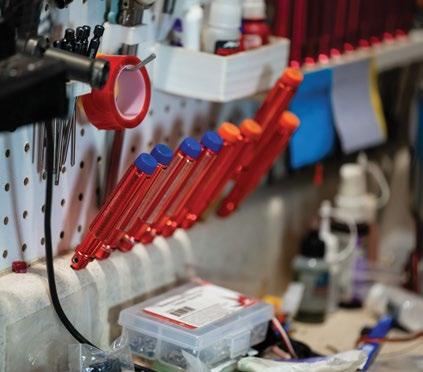
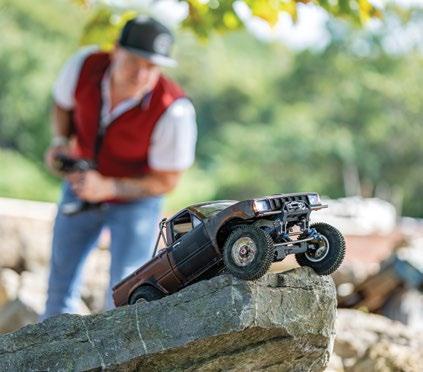

WHAT PIQUED YOUR INTEREST IN RC MODELS?
As a kid growing up in Memphis there was an indoor dirt track where my dad would take me and my older brother to watch RC car racing. This sparked my interest and led to my first purchase of a Tamiya Lunchbox monster truck style RC van. From just playing around as a kid it then developed into competitive RC car racing. As I got older I started developing a strong interest in speed run cars. Today, I am still into speed runs as well as scale RC building and competition crawling.
WHAT IS ONE OF YOUR FAVORITE MODELS THAT YOU’VE BUILT?
Each car is different and comes with new creativity which makes it hard to name a favorite. The first car I built that was a 100-mile-per-hour car stands out. Over the years building hundreds of different cars, boats, and helicopters, there are many good memories of the process. Seeing an idea come to light and then watching something you built race or compete is a unique feeling. It's very intricate, time consuming, and more than just buying an RC car off a shelf. RC builders spend so much time on each detail and are dedicated to their builds.
ARE THERE ANY INTERESTING ELEMENTS YOU'VE INCORPORATED IN YOUR MODELS?
I've worked with paint and fabrication specialists across the entire country on customizing pieces to a level beyond my own abilities. Be it adding custom carpets, speaker systems, or a unique paint scheme, each car I've built has something special about it. Many of the more non-racing vehicles have small touches that you would see related to the actual vehicle. I built a custom scale Ford Bronco that had a sleeping bag, canoe, and camping gear in the back. Many builders also sometimes add skeleton or scale drivers in the vehicles. If a piece is being built for racing, these items are sometimes left out to keep the weight down. Having real transmissions, axles, bead lock rims, true nitro engines – just to name a few – makes these cars so interesting.
HOW HAS RC MODEL BUILDING CONNECTED YOU WITH OTHERS?
I've met so many great people through RC car racing and competitions. Battlefield RC hobby shop is the local hub where we get together and work on our next builds. We've traveled together to national competitions across the U.S. Also, there are several groups that get together locally with their crawlers at the Ocoee. Sharing this experience with my dad is still something we talk about and enjoy today. I’ve even built an RC car for one of my dogs and she knows it is her car. She loves to chase it around our yard.

One of the things that I was able to do, even when I was a kid, was read blueprints. I just understood what they were trying to explain. My father was an engineer and was the president of Georgia Tech from 1957-69, so I grew up watching all those projects they had, which was really amazing. One day when I was about four, I’d gone with my mother to the grocery store, and it snowed about four inches in the parking area around the town square. The grocery store was on the far side, and my father was complaining, “Why don’t they make the store closer?” So I went out in the snow and started stomping out a city, trying to see how you could make the grocery store better, what’s the next busiest shop, and where to put parking, etc. Basically, that was a model.
The early model kits, you pretty much just made up models with what you had at home until after World War II, when there were businesses set up to make different kits. They started making these wooden ones, and then the plastic versions came out in the 1950s when they started getting injection molding. Finally, they transitioned into the modern versions with the ailerons working on the planes, the full interiors, and so on. Now, with 3D printing and laser cutting technology, that’s changed it some, but you still have to be able to visualize the project first. Where experience comes in is knowing what material to make it out of and how to finish it.
THE DOLL FOR ALL MODELS ARE SIMILAR TO ACTION FIGURES. WHAT INSPIRED THE TECHNOLOGY BEHIND THESE POSEABLE TOY DOLLS?
The most articulated figure made was a Spiderman that was about 20 inches tall. It was a failure as a toy because it was really heavy for a character that was supposed to be able to climb walls. But the hand they made was a masterpiece –every joint worked. I saw it in the store when it came out and I was just astounded at it. I also have a doll from 1909 called the Schoenhut doll, which wasn’t as articulated as that, but had elbows, knees, ankles, hands that would move, and a head that could turn. They had springs in the joints that created friction so the doll could even stand on one leg and pose. I thought that was amazing.
WHAT’S THE SECRET TO MAKING MODELS LIFELIKE?
I once won a contest with a model Sherman tank. All these guys were talking about the different ways you can replicate the rocks and the trees going by and the grass it’s crawling over. But I had my godson over, and we just went out and played with the model. By the time we played with it and got dirt on it, I stuck it in the exhibit just for fun. When I won the exhibit, they asked, “What did you use for the dirt?” I just used dirt!
If you can name it, there’s a good chance Rick Harrison has built a model of it – buildings, cars, airplanes, historical dioramas, set designs, and most recently, custom dolls for kids with disabilities as part of The Doll for All project. With over 50 years of fabrication technology experience under his belt, Rick strikes a balance between practicality and fun in the diverse projects he undertakes.



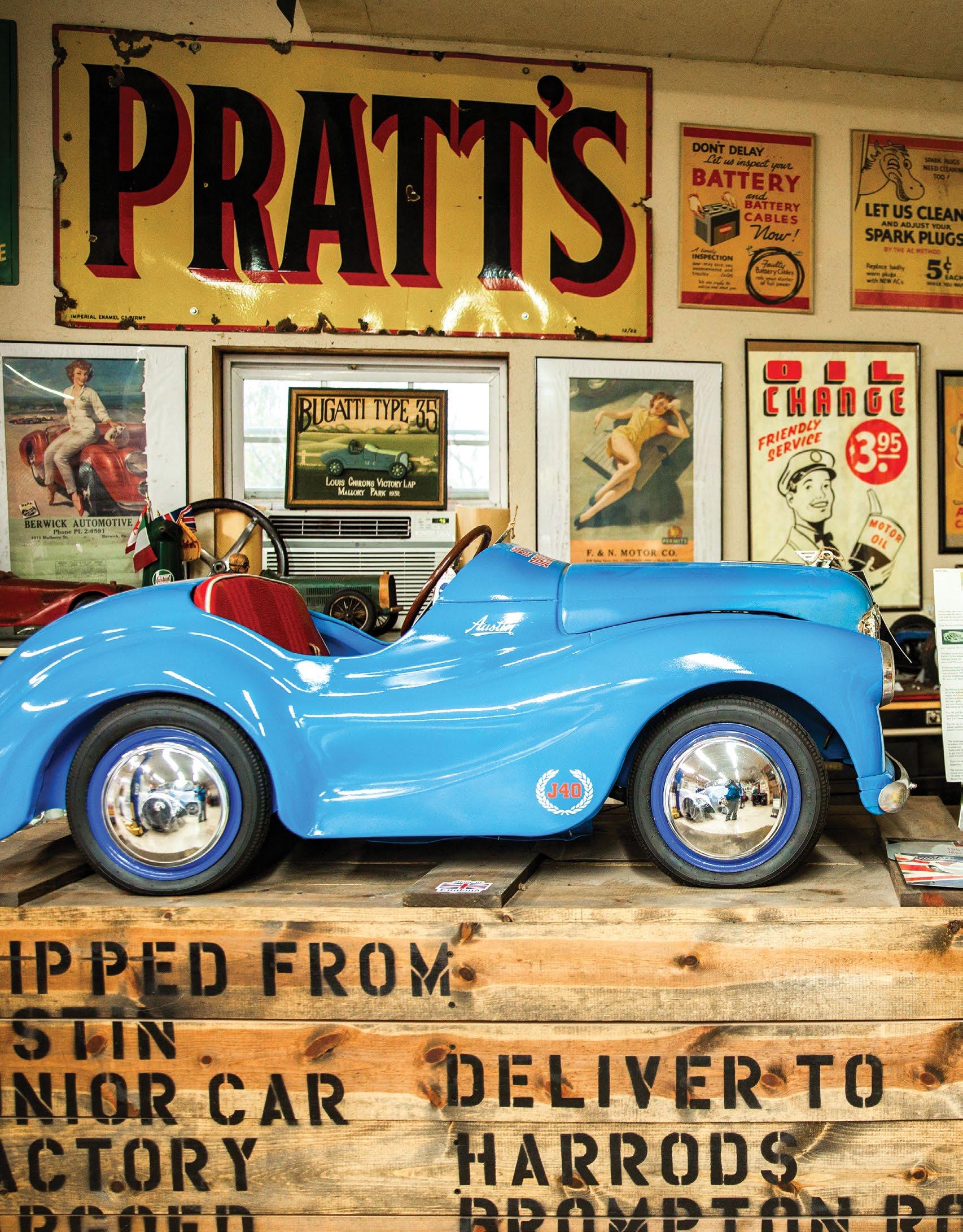

Local Men Share the Stories Behind Their Prized Possessions
While collections come in all shapes and sizes, all are driven by an interest for the items at hand. Here, five local collectors with impressive and storied collections showcase the variety of this universal hobby and provide insight into their interests. From artwork and wine to coins, cars, and more, read on to learn more about the art of curating a collection.
By Rachel Studebaker

Decades spent acquiring any item will result in an impressive collection, and this is certainly the case for Rick Rader. An avid comic book art collector for 40 years, Rader’s interest in this art style began when he was a boy.
“Like many young kids, I first gravitated to reading comic books for the stories and the characters. Somehow, I became fascinated by the artwork. The unique styles of the various artists and how they depicted action and backgrounds became a focus of my interests. I found myself collecting comics not for the content but for the artwork,” he recalls.
Rader points out that admiration for this artistry, from the skill that goes into figure drawing to the details that distinguish each artist, hasn’t always been commonplace in the comic book industry, explaining, “For years, the artwork was a secondary consideration. The artists were unknown to most people; the limelight was on the writers.”
Since he began collecting, however, much has changed. “I have seen the appreciation of comic book art grow from a small band of collectors to its recognition as a true artform. The original comic art drawings were once swept up at the end of the day and now command space in museums and galleries,” says Rader.
These days, Rader rarely adds to his collection and instead enjoys the fruits of his efforts. Dozens of his favorite finds are displayed on a wall in his home, ranging from sketches and fi-
nal prints to rare concept art for comics that were never realized.
“I have a collection that reflects my favorite artists. I am at the stage where I am reaping the benefits of years of active collecting,” he shares.

“Despite the fact that they have been displayed for over 20 years, I never get tired of them or take them for granted. Plus, it seems that I am always discovering some overlooked details of the artwork.”
While Rader’s collection contains many a valuable item, for him, the true value lies in his love for the art and the ability to view it every day. “Don’t think of collecting as ‘investing,’” he advises. “The dividends are the ongoing enjoyment of what you have acquired.”
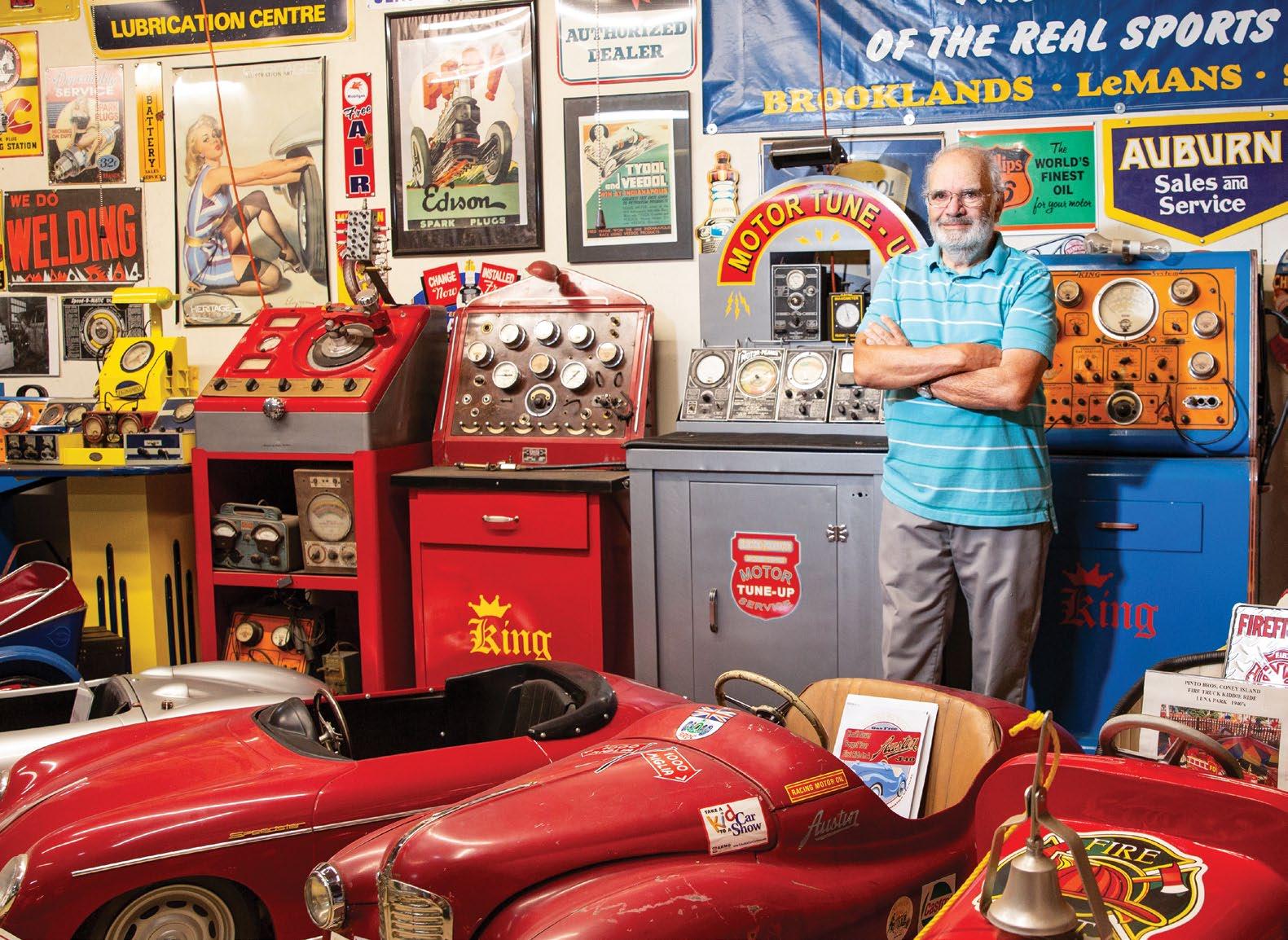
Philip Rader is a car enthusiast. He makes repairs in his workshop, attends car shows, and takes pride in his collection of antiques. These are no ordinary cars, however.
Rader collects pedal cars, toys that have been delighting children for over a century and are now a valued collectible item. Highly knowledgeable about this niche, Rader says he has been collecting “since I was old enough to fit into my first pedal car, many decades ago.”
He acquires new additions by attending toy and car swap meets, connecting with other collectors, and “of course, the internet.” His favorite find? “The Austin J40 built in the 1950s. It is all original, has a great patina, and is a favorite of kids to sit in when we bring them to shows.”
In addition to collecting, Rader is devoted to restoring well-loved pedal cars to their original glory, driven by his love for “the design, level of craftsmanship, and the history of these cars.”
He is joined in these efforts by his brother and fellow collector, Rick, who often accompanies him in the garage that serves as his home base for housing and working on the pedal cars. “We work together to repair and restore the cars. We also share this hobby with adults and children by bringing these cars to antique auto shows as well as antique toy shows. It brings us closer together as we spend time (sometimes too much time… ask our wives) working on our hobby,” shares Rader.
Attending these shows has allowed Rader to connect with fellow pedal car connoisseurs and provided plenty of stories along the way. “At a well-known car show, we convinced the chairman of the show to let us display the car as a ‘real car’ alongside other antique cars … and yes, we won an award,” he recalls.
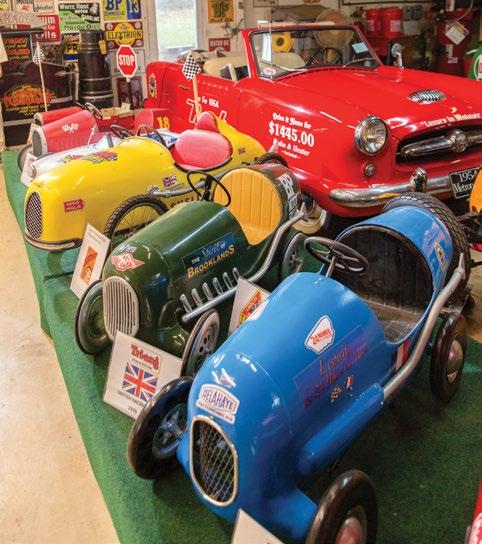
Having chosen a hobby with its fair share of involvement, Rader advises anyone considering taking up a collection to keep in mind how much work they are willing to do. For him, however, he wouldn’t change a thing as he pursues his passion for preserving pedal cars and lets their histories live on.
with Jenny Hullander
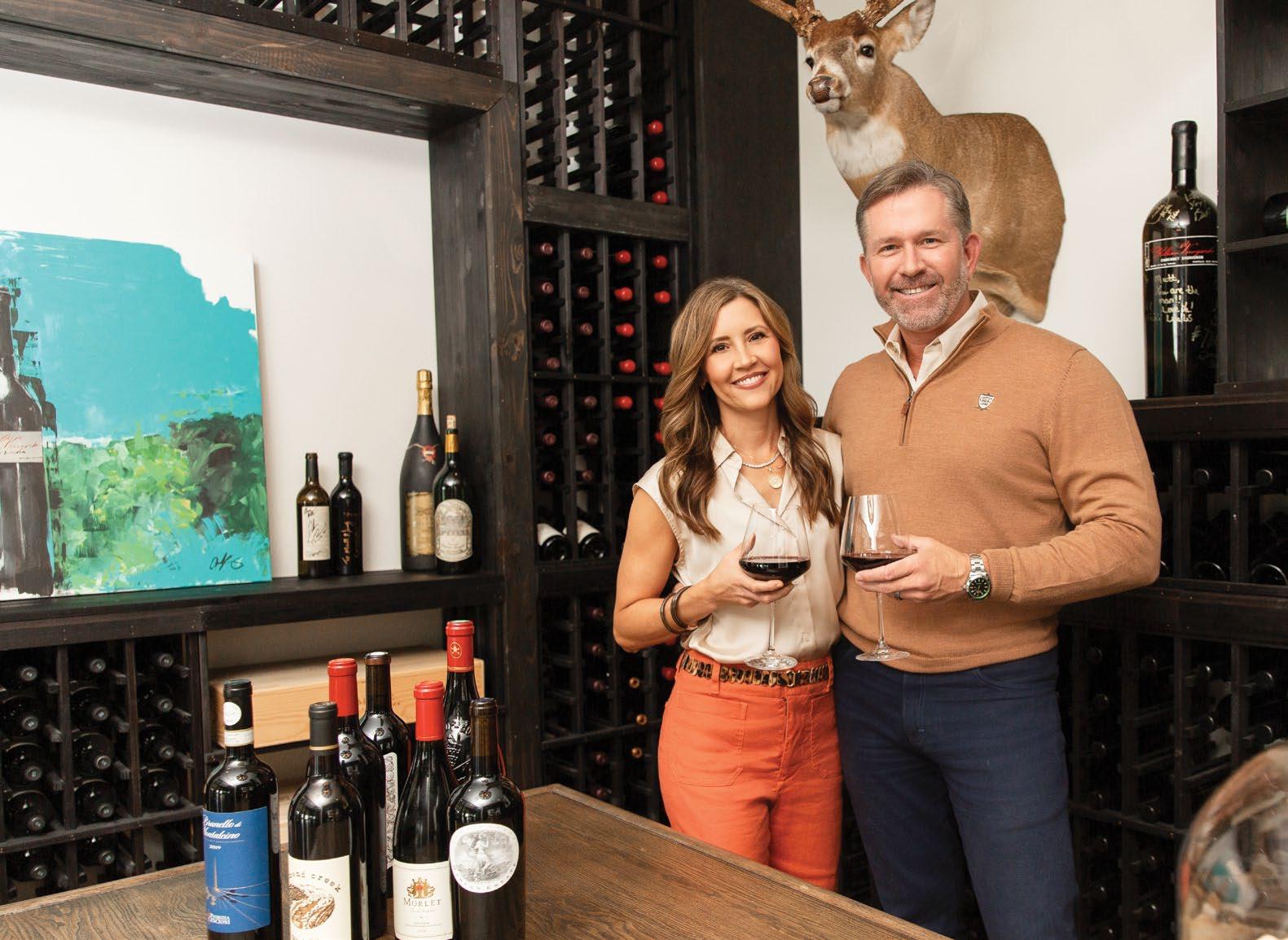
For Matt Hullander and his wife, Jenny, a shared appreciation for wine has turned into a curated collection of 800 bottles from around the world. The couple has been actively collecting wine for the past five years, with every new addition bringing a special memory to mind.
“Each bottle can have its own story, from the vineyard it came from to the circumstances of how I was introduced to the wine,” shares Hullander. “My wife and I have often met the owners of the vineyards, and knowing their story and having met them personally adds to the enjoyment of the wine.”
The Hullanders’ differing palates have produced a varied wine collection, which they enjoy sampling with friends and fellow connoisseurs during tasting parties or by bringing unique bottles to dinners. “Introducing them to a wine they haven’t tried and seeing their reaction is fun,” says Hullander. “Sometimes they love it, other times it doesn’t suit their taste.”
When asked which wine is his favorite, Hullander jokes, “That's like asking which child is your favorite. I only have one child but many favorite wines. It can change, but a few of mine are Schrader, Morlet, Revana, different Brunellos, and my current favorite is a cab from Del Dotto Caves.”
To house their collection, Hullander built a custom cellar that offers benefits beyond storage. “Keeping the wine climate controlled lets you keep the wine longer and enjoy it
years, sometimes decades, later depending on the quality, varietal, and vintage,” he explains.
These many facets fuel Hullander’s fascination with the beverage. “It’s interesting to learn about the different wine making processes and traditions, the regions the grapes come from, and the history behind the wine. The vast range of wine styles, regions, and vintages offer a lifetime of learning and discovery,” says Hullander.

While collecting is half the fun, Hullander advises, “If you have great wines you don’t have to save them all for a special occasion. It doesn’t have to be your anniversary. The occasion may just be a Tuesday night. Drink the wine.”

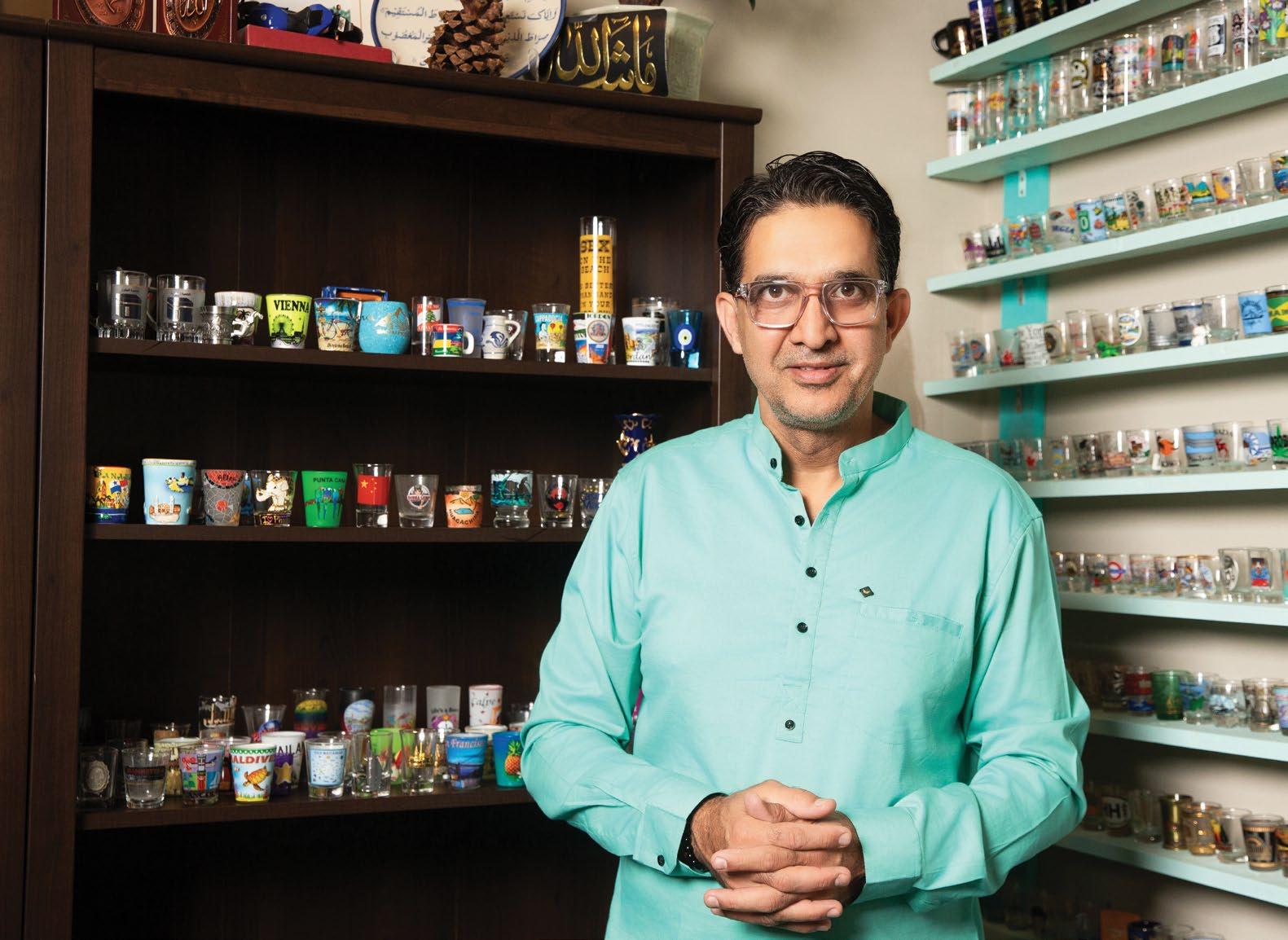
Collecting has been a part of Salman Nayab’s life since he was a boy. Though his childhood currency collection was left behind when he moved to the United States, his interest in the hobby would prove to be far from over.
Rebuilding his collection has been a process over 20 years in the making and has involved keeping an eye out for rare U.S. coins, exchanging currency with international friends that come to visit, and converting cash during his travels.
These efforts paid off, as Nayab’s collection now contains coins and binders full of bills from countless countries, including rare currency no longer in circulation. He is wellversed in the histories of the currency he owns and how each item’s value has changed over time. He shares, “Some currencies are obsolete and some have a high valuation as being ‘rare’ now. It is fascinating!”
While currency remains his favorite collectible, Nayab also began collecting shot glasses in 2007, inspired when a coworker gifted him one from the Philippines. “I thought it was pretty cool and such a unique and fragile item to collect from different places,” he recalls. Today, shelves lined with hundreds of decorative shot glasses chronicle Nayab’s travels, each a conversation piece with a story to tell.
Though his two collections each have a character of their own, Nayab is equally fascinated by “the different cultures and values that are imprinted on the currencies and shot
glasses of the world and the stories behind them.”
Nayab is joined in his love for collectibles by his wife, Amna, and their two children, each gravitating toward their own interest. “My wife shares this passion of collecting mementos from our travels. She collects magnets and keychains; my son collects hats and stickers; and my daughter collects pebbles from different places of different colors and hat sew-ins. We are a family of collectors!” he shares. For those new to the hobby, Nayab offers a wise reminder that even the most impressive collections begin with one item. “You have to start somewhere,” he encourages. “So, start small, and if you are passionate about it, it will grow into a larger collection before you know it! It becomes a second instinct.”

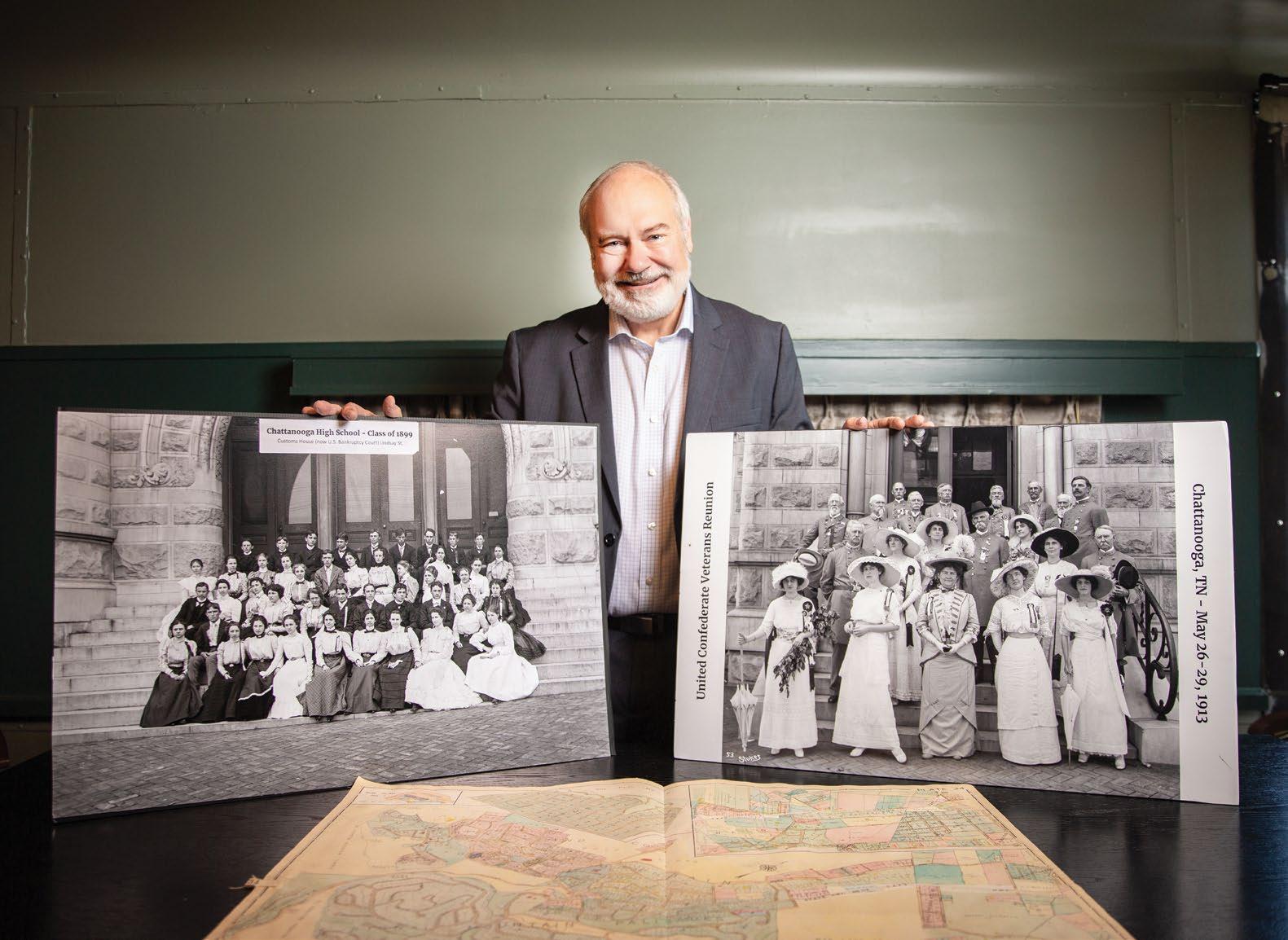
Local historian Sam Hall’s collection was born from a passion for preserving vintage photographs. Looking for a way to display high-resolution historical images online, Hall created Chattanoogahistory.com in 2014, a public resource that includes photos, documents, and maps, all local to the region.
“Most of my collection are not physical objects but loaned and digitized unique historical views. Many people want to share but not part with the items. I do own many photos and documents, but ownership is not my primary goal,” Hall explains.
The majority of the Chattanooga History collection comes from contacts who reach out via his website, though Hall also keeps an eye out at estate sales and online resale shops for pictures he can preserve. As more locals have become aware of this avenue to preserve their family’s history, the collection has only grown.
“Finding previously unseen views and identifying the people and places in photos is a passion,” says Hall. “I've uncovered many stories that have been lost or forgotten. Most people don't realize how good the photography was over 125 years ago because they've never seen it presented in full resolution. Printed media is, by design, low resolution. Anytime I can cause jaws to drop in amazement makes me happy,”
To transform original documents into high-quality digital images, Hall operates from a workspace that covers two rooms of his home. “This includes computers, scanners, video
digitization equipment, file storage, file conversion hardware, and physical media storage, as well as a growing library of books,” Hall describes.
While Hall digitizes photographs in all forms, his favorites are from glass plate negatives, which he explains were the popular method of capturing photos prior to film. By processing these negatives, he is able to share the impressive quality of images taken over a century ago.
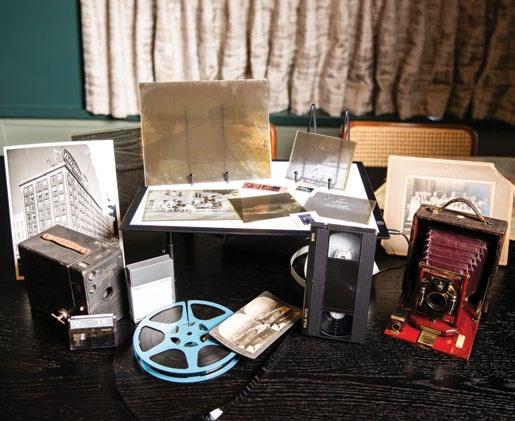
“My favorite story is when I identified 40 of 47 students in an amateur glass plate negative scene,” shares Hall. “They turned out to be from the 1899 graduating class of Chattanooga High School. One student was Alice Fletcher, who married Spencer J. McCallie – co-founder of McCallie School… I take great pride in adding a photo to her memory.”
Set among rolling hills, sparkling lakefront vistas, breathtaking panoramic mountain views, and flourishing farmlands, the homes in this collection showcase a variety of authentic home styles available across Southeast Tennessee and North Georgia. From bungalows with charming amenities or idyllic river retreats to horse farms, mountain bluff estates, and more, these homes demonstrate the highest level of architecture and design with elements genuine to the South.
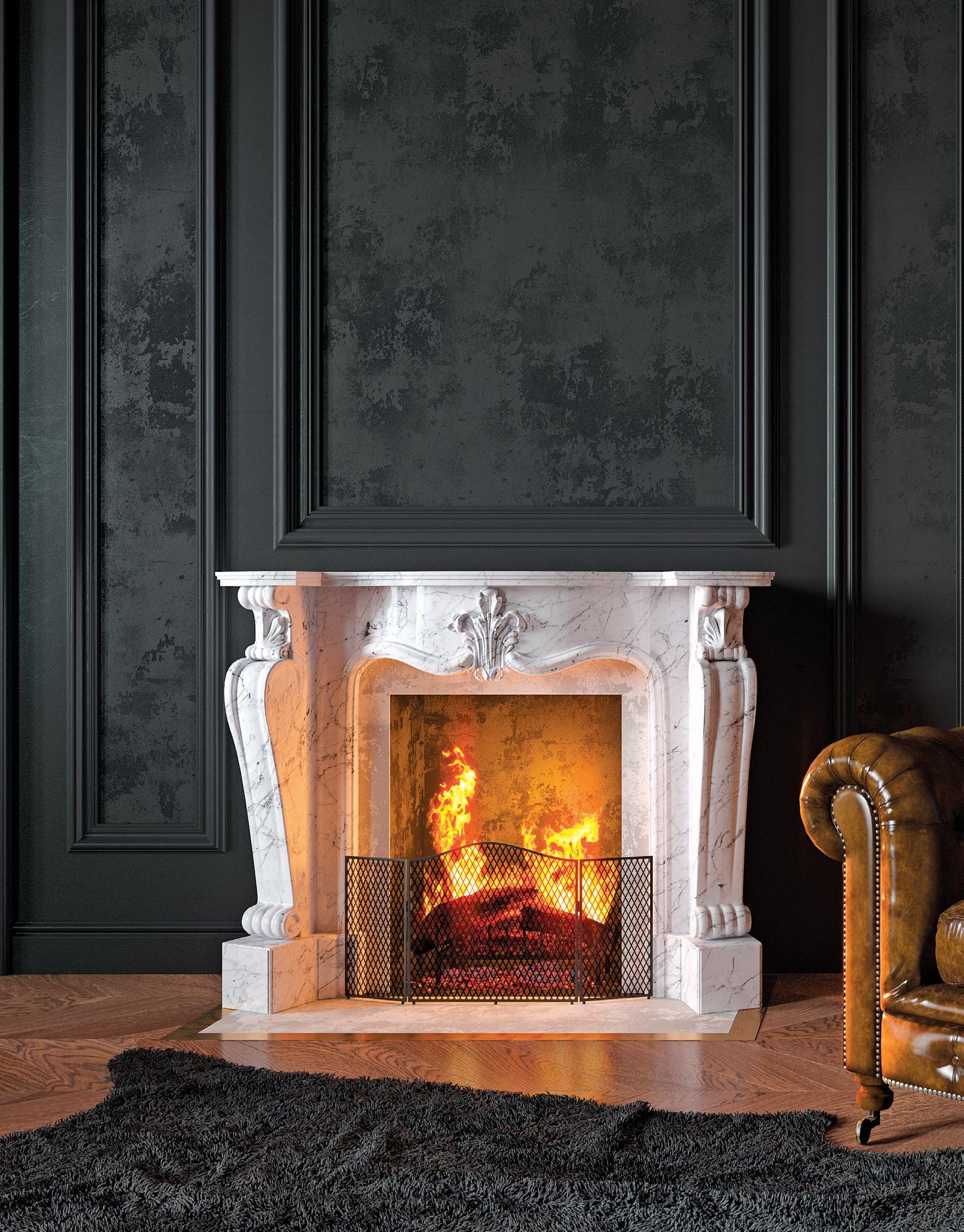
“A man travels the world over in search of what he needs and returns home to find it.”
- George Augustus Moore

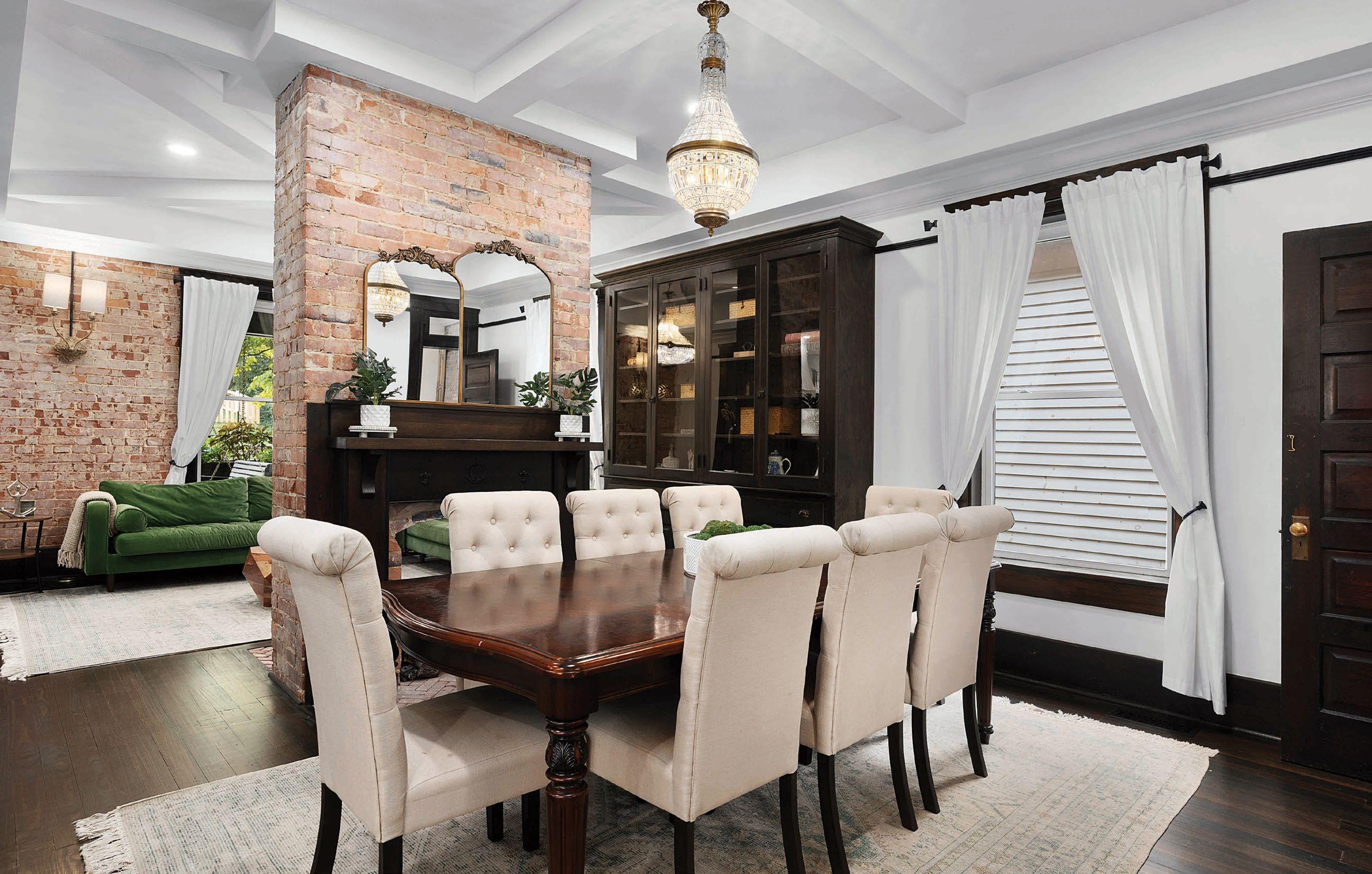
4401
Built in 1914, this historic home lies at the bottom of Lookout Mountain and just minutes from the conveniences of downtown Chattanooga. Listed on the National Historic Register in St. Elmo, this one-of-akind home has been fully renovated, making it the perfect blend of classic design and modern comforts.
With a red brick exterior and dark roofing, this house has plenty of curb appeal to offer, including an inviting front porch, complete with the perfect spot for a porch swing and plenty of room for patio furniture.
Upon entering the home, the eye is immediately drawn to the stately hardwood floors and red brick accent walls, adding character and charm to the modern interior. On the first of four levels, the home boasts a living room with a gas fireplace, formal dining room, full
guest bath, and a breakfast room adjacent to the well-equipped kitchen. At-home chefs will be inspired by the eight-burner gas stove, double oven, and convenient pot-filler faucet.
Heading upstairs, the house features three bedrooms and two full baths, including the primary bedroom and luxurious ensuite bath, complete with a dual vanity, claw-foot tub, and green-tiled shower. Also upstairs is a relaxing sunroom overlooking the backyard and a spiral staircase to access a spacious bonus room on the fourth floor, perfect for a playroom, home office, and more.
On the lowest level, one can find the daylight basement, accessible indoors and from the covered back patio. Complete with another full kitchen, family room, two bedrooms, and a full bathroom, this is the perfect spot for hosting family and other guests.

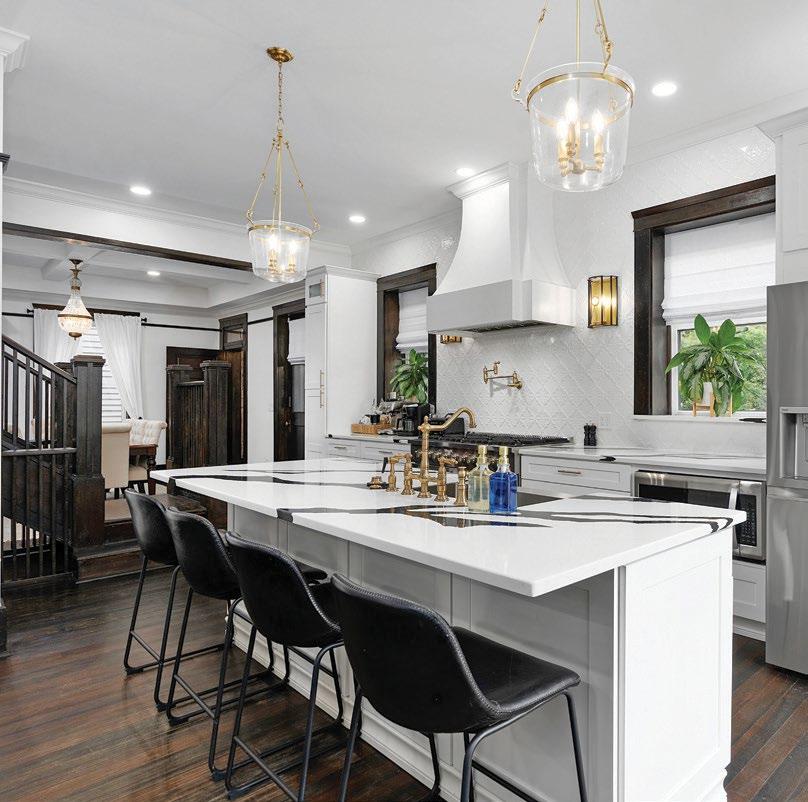

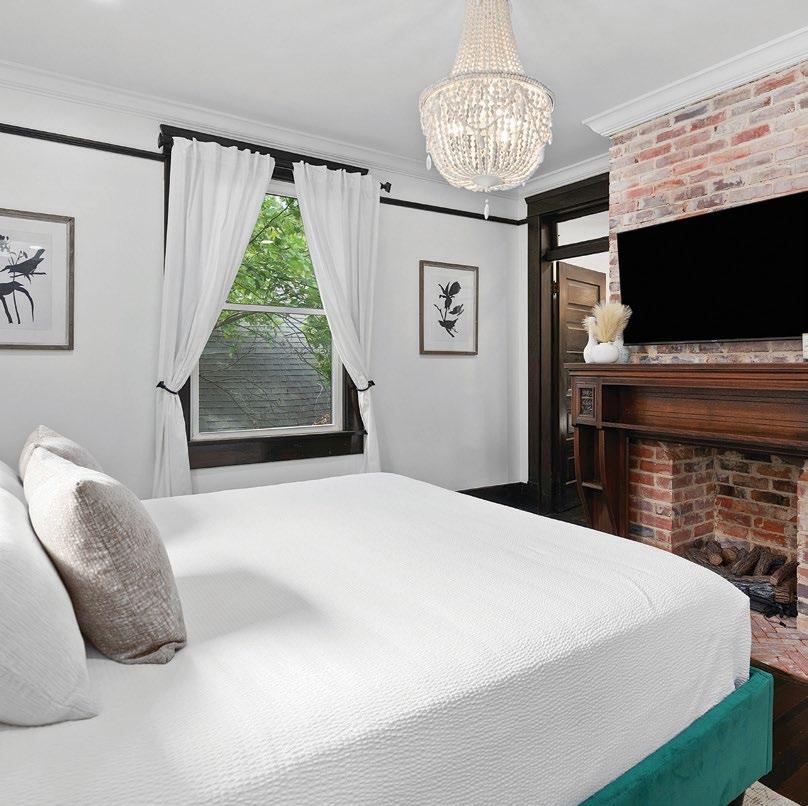





Atop Lookout Mountain lies this refined retreat, nestled in the quiet countryside of North Georgia. This luxurious home offers sweeping views and is located in a quiet, gated community, offering plenty of peace and privacy to enjoy.
However, convenience is never far away, as the home is adjacent to grocery and dining options, and just 25 minutes from the illustrious McLemore Club, making it the perfect blend of solitude and accessibility.
The 2023-built, “smart technology” home boasts mountain stone accents and large picture windows, perfect for taking in the panoramic brow view. Off to the side, lies one of the home’s peaceful escapes, a covered, craftsman-style porch, complete with a woodburning fireplace.
With 4,146 square feet, including three bedrooms, four bathrooms, and a home office with inspiring views, this home is designed with luxury in mind. Stepping
through the front doors, one is greeted with white oak hardwood floors and soaring ceilings, and guests will immediately be drawn to the living room’s cozy stone fireplace. The kitchen is every at-home chef’s dream, complete with quartz countertops, wooden cabinetry with gold pulls, and a spacious island for meals and entertaining.
The main level features three bedrooms including the sophisticated primary suite. In the morning, the primary ensuite makes getting ready a breeze with its dual-vanity, complete with expansive counterspace, gold fixtures, and sconce lighting. Also notable are the marble-tiled shower and walk-in closet.
The home also offers unique luxury features, including its sauna, professional dog grooming station, and enclosed gardening station. Surrounded by inspiring scenery, nature enthusiasts will thrive with proximity to Cloudland Canyon State Park and Little River Canon Preserve.




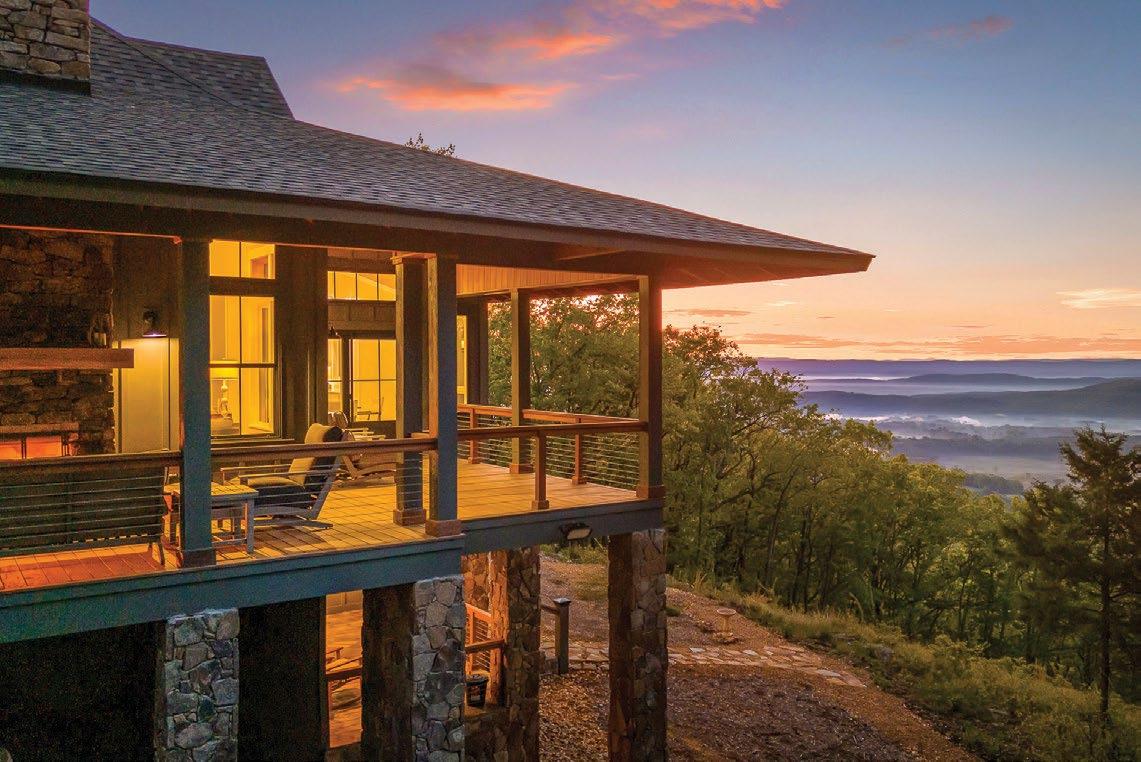
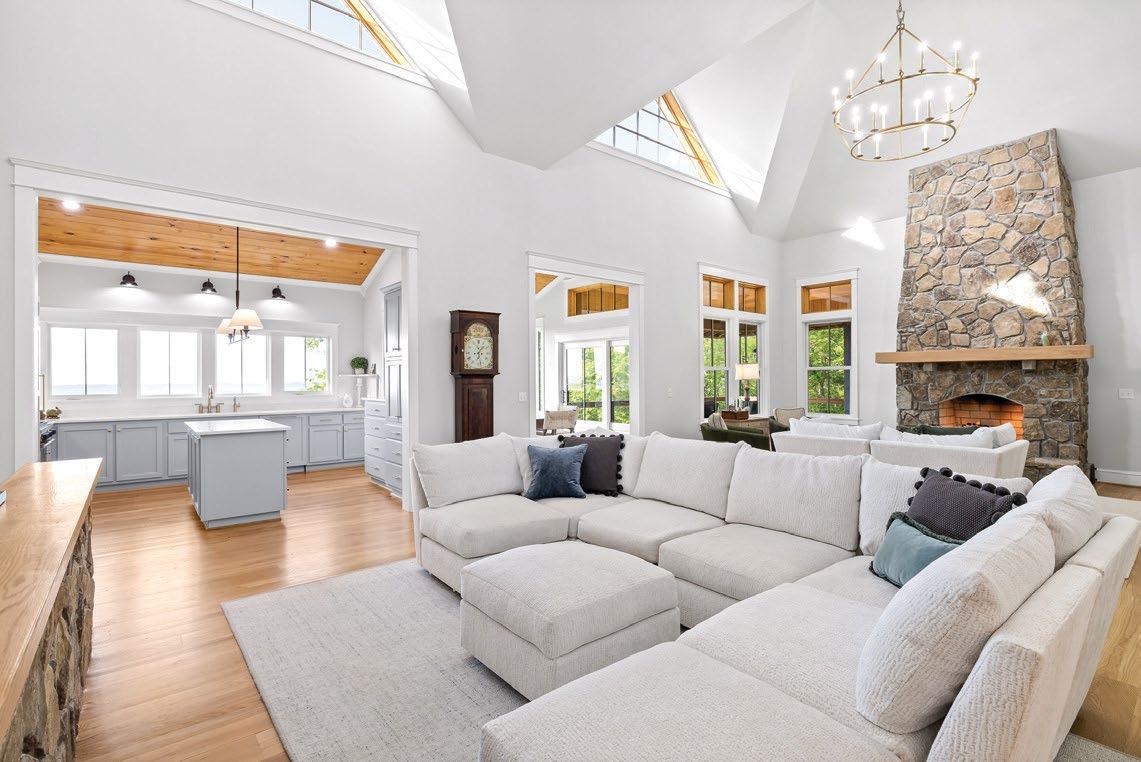


Located on a quiet street atop the Tennessee side of Lookout Mountain, this wellmaintained and charming home is just steps away from the conveniences and attractions of the mountain, making it the perfect blend of peaceful and convenient.
The home’s exterior boasts red brick complemented by white accents in the window frames and gabled roof. Attractive landscaping and a lovely window box complete the home’s charming curb appeal.
Also on the first floor lies the primary bedroom, featuring a recently-renovated ensuite that includes new marble countertops, a large tiled shower, and luxurious heated floors that will keep you warm all winter long. With a walk-in closet in the bathroom and a smaller closet in the bedroom itself, the primary bedroom also offers an abundance of storage.
1012 Evanwood Drive
Lookout Mountain, TN 37350
Moving inside, one is greeted with beautiful hardwood floors and high ceilings. Families will enjoy the spacious dining and living areas, all awash in natural light. Towards the center of the home, the kitchen is a vision in white with inset cabinetry accented by gold pulls, a subway-tiled backsplash, and quartz countertops. This eat-in kitchen also offers space for a large table.
The top floor houses the last of the four bedrooms with a full bathroom and plenty of closet space, perfect for hosting family and friends or as space for an at-home office. Outside, enjoy the peaceful sounds of nature from the private yard’s stone patio, accessed by beautiful French doors, or from the newly constructed deck, complete with a stunning pergola. With so much inviting entertainment space, guests will never want to leave.
FEATURES: Well-maintained mountain home | 2,890 square feet 4 bedrooms | 3 baths | Newly-renovated baths | Deck and pergola


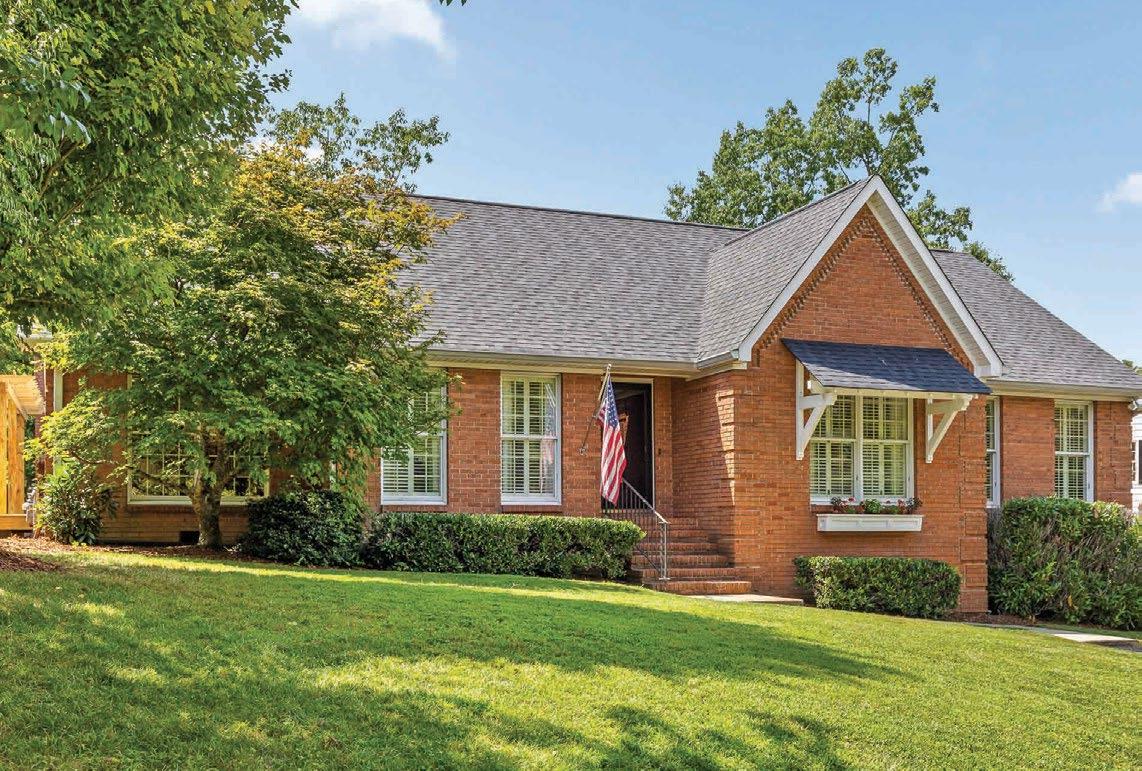
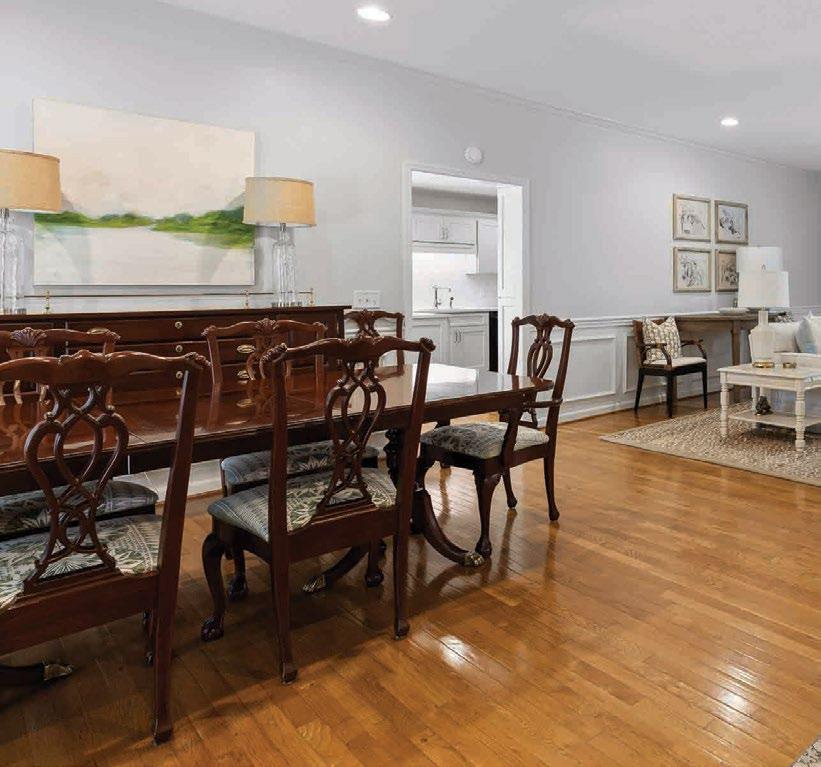
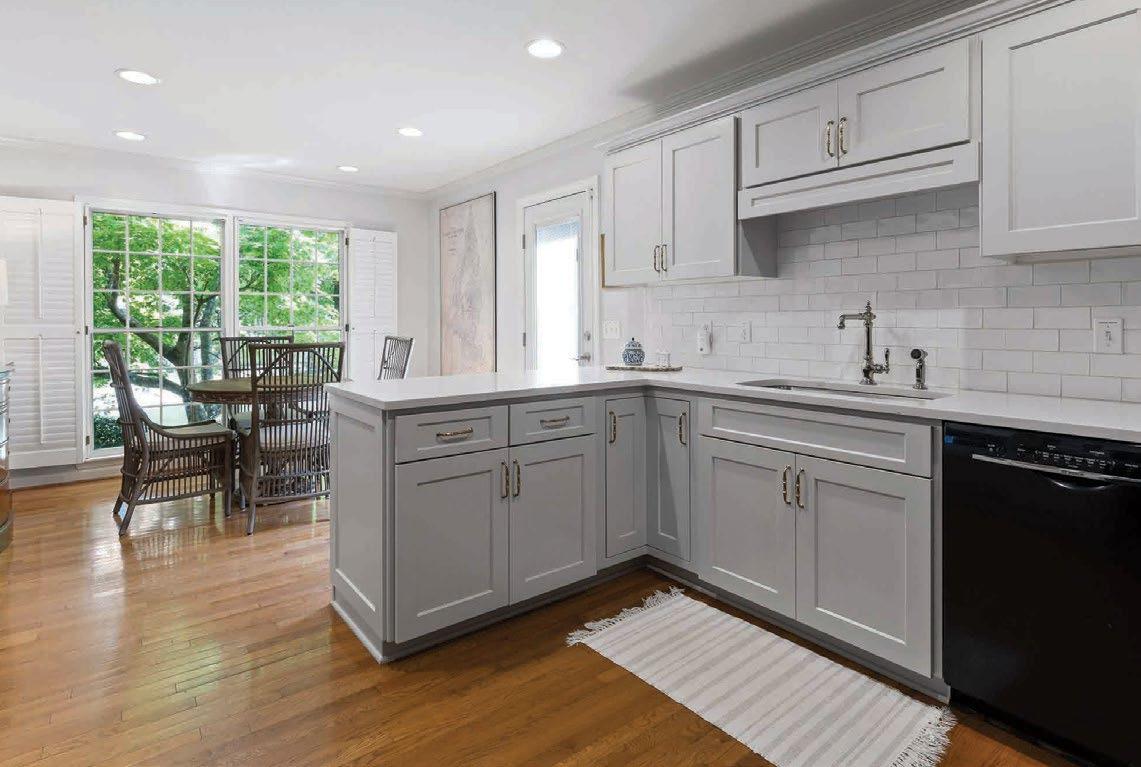




I503 Winston Road
Chattanooga, TN 37405
n the heart of the desirable Riverview area lies this luxurious home with modern stylings. The home’s exterior boasts gray batten and brick siding, complemented by black roofing and window frames. The home’s finishing touches lie in the stone-accented walkways and lush landscaping, offering plenty of curb appeal. Through the custom-made mahogany doors, one is greeted with light oak hardwood floors and an open floor plan, allowing for optimal space and flexibility in furnishing. The living area boasts a custom-designed fireplace, set within a tile feature wall, and plenty of natural light from its abundance of windows.
In the heart of the home lies the wellequipped and stylish kitchen, complete with sleek inset cabinetry and a 4-foot
gallery sink with a built-in workstation. Overhead, the workspace is lit with gold pendant lighting. At-home chefs will also appreciate the water filtration system, expansive quartz island, and a walk-in larder for ample storage.
With four bedrooms and four and a half bathrooms, this home offers plenty of space for a growing family or those who love to host. What truly makes this home unique is its two primary suites, one on each level, with ensuites including spa-like features, such as a sauna and steam shower.
Outside, one can’t forget about the detached two-car garage, complete with a rooftop deck. The garage also houses its own kitchenette and half bathroom, making the rooftop hangout the perfect space to host family and friends.




FEATURES: Top-tier craftsmanship | 5,858 square feet 4 bedrooms | 5 baths | 2-car garage | Rooftop deck





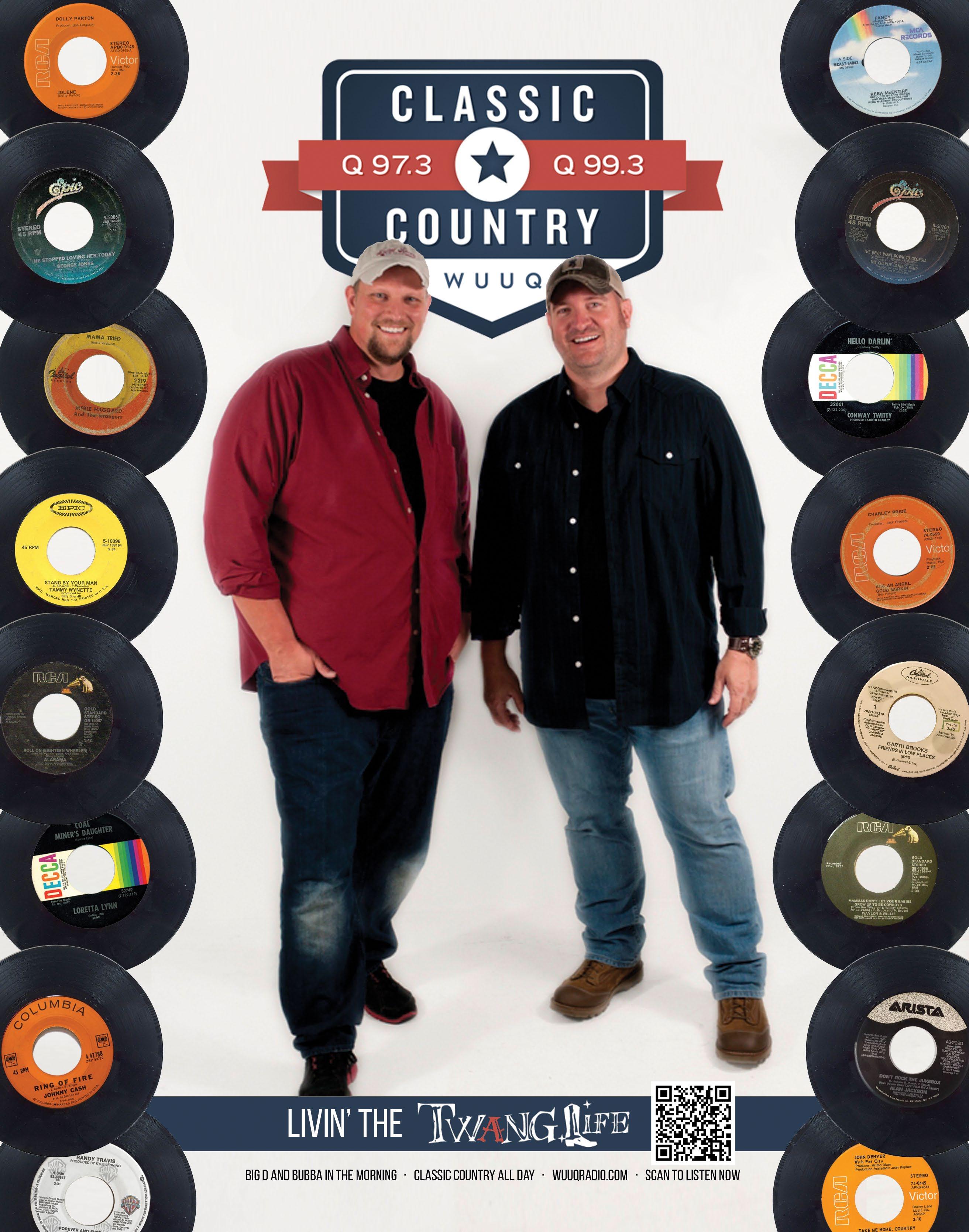

“TO ME, FOOD IS AS MUCH ABOUT THE MOMENT, THE OCCASION, THE LOCATION AND THE COMPANY AS IT IS ABOUT THE TASTE.” – HESTON BLUMENTHAL
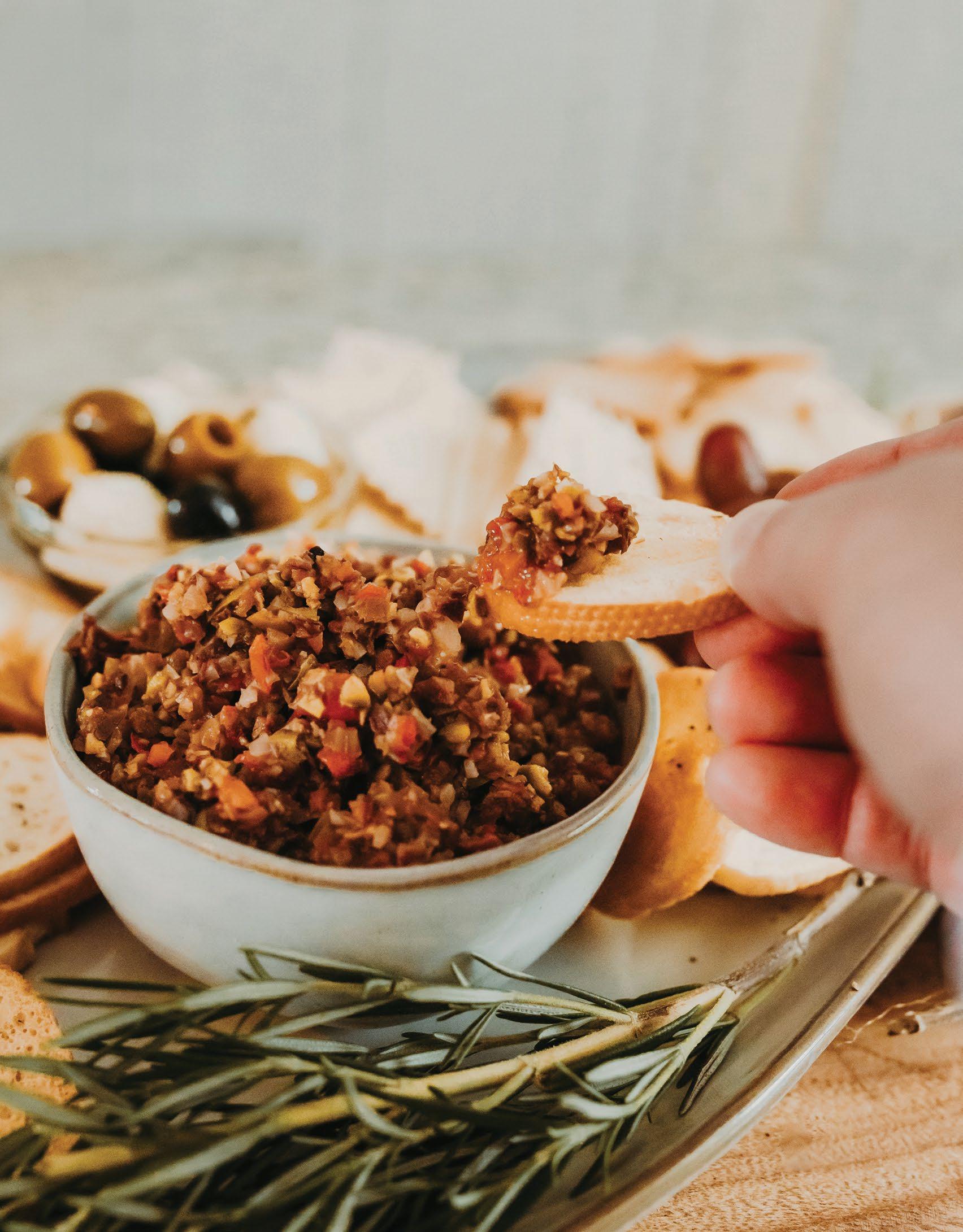





Local home chefs share their go-to dip recipes to impress guests at any gathering.
Photography by Kristina Armstrong



“My dip is our go-to favorite because it’s simple and packed with great flavor. I serve it with pork tenderloin sliders at backyard cookouts. Friends and family love it.”
Ingredients
• 2 strips of cooked bacon
• ½ cup mayonnaise
• 1 Tbsp. apple cider vinegar
• 2½ Tbsp. yellow mustard
• 1 Tbsp. hot bacon grease
• ¼ tsp. all-purpose seasoning
• 1 pinch of cayenne pepper
• ⅛ cup honey
Directions
Mince the bacon very finely. I use a mini grinder to make it a bacon dust. Add the remaining ingredients, and stir. Store the dip in a sealed container, and refrigerate until ready to serve.

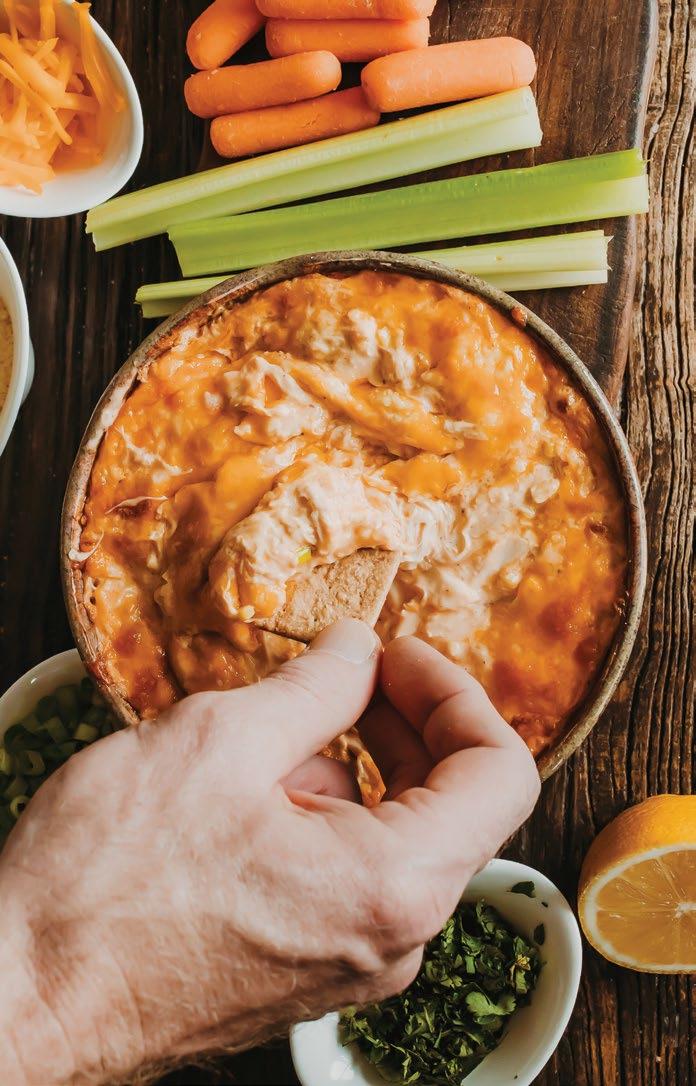
“I love the cool, crisp air of fall, especially when it's time to cheer on the Georgia Bulldogs. There's nothing like spending a Saturday immersed in college football, surrounded by friends and family, and the smell of hot crab dip. The combination of the season, the sport, and that savory dip makes fall my favorite time of year!”
Ingredients
• 1 (8 oz.) package cream cheese, room temperature
• ¼ cup mayonnaise
• ¼ cup sour cream
• 2 cloves garlic, minced
• ¼ cup green onion, chopped
• ¼ cup Italian parsley, chopped
• 2 tsp. Old Bay seasoning
• ¼ tsp. kosher salt
• 1 tsp. Worcestershire sauce
• ½ of a lemon, juiced and zested
• 1 cup freshly shredded cheddar cheese, divided
• ½ tsp. hot sauce, or more to taste
• 1 lb. jumbo lump crab meat
• ¼ cup Parmesan cheese
Directions
Preheat oven to 350°. Add cream cheese to a mixing bowl and beat until smooth. Stir in mayonnaise, sour cream, garlic, green onion, parsley, Old Bay seasoning, salt, Worcestershire, and lemon juice and lemon zest. Add ¾ cup cheddar cheese and hot sauce and mix until smooth. Stir in crab meat. Spread into a 9-inch pie dish or similar-size baking pan and sprinkle remaining cheddar cheese and Parmesan cheese on top. Bake for about 20 minutes or until the top is golden and bubbly. Serve warm, with slices of sourdough bread, crackers, or chopped, cold veggies.

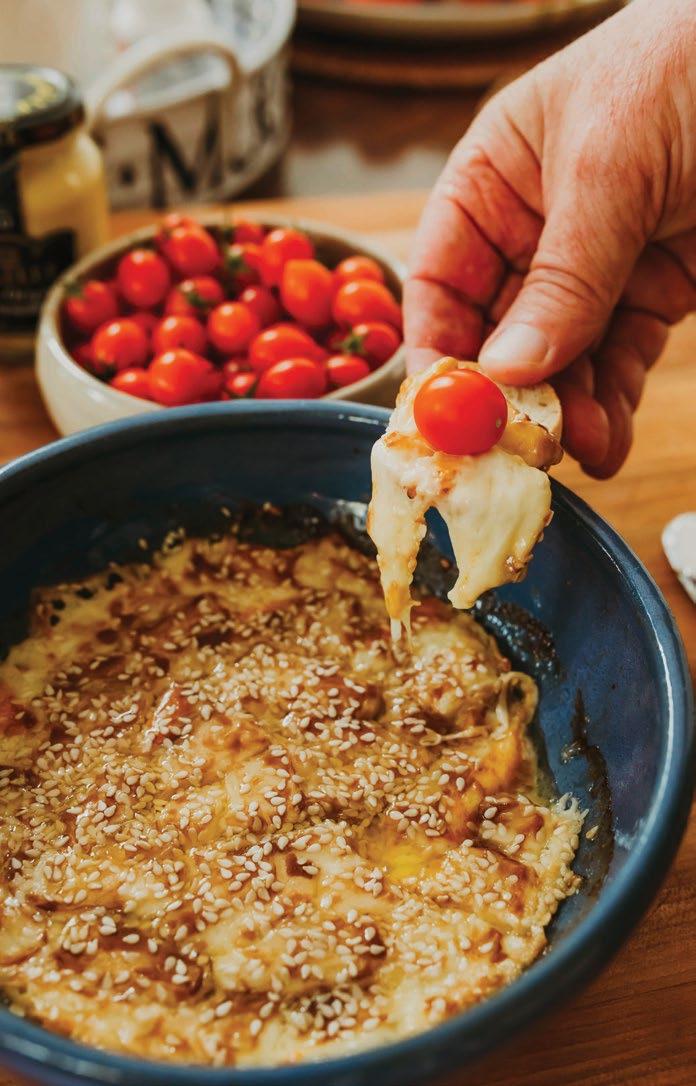
“A dip should be fast, easy, and flavorful, something you can make on short notice when you know friends are coming over. It should also be a bit unexpected and so delicious that people keep coming back for more. If you're cooking a full meal for guests, you don't want to spend too much time on a dip, but you still want it to be special.”
Ingredients
• ½-lb. block of Muenster cheese, or melting cheese of choice, cubed
• 2 tsp. Dijon mustard
• 1 tsp. soy sauce
• Sesame seeds, for topping
• Cherry tomatoes, halved, for topping (optional)
Note: Muenster cheese can be hard to find. Other melting cheeses like Colby, Havarti, Fontina, or Monterrey Jack would substitute nicely.
Directions
Place cubes of cheese in an ovenproof dish not too much bigger than the block of cheese. Combine mus -
tard and soy sauce. Spread mustard mixture over all the cheese, then sprinkle liberally with sesame seeds. Bake uncovered in a 350° oven or on a grill away from direct heat until melted, about 15 minutes. Serve with crusty slices of a baguette for scooping. Top with half a cherry tomato for a burst of acidity.


“This is an easy-to-make recipe and a versatile, different way to start an evening. While I love Italian food, this works as a prelude to pasta, pizza, or anything else when your neighbor says ‘bring something.’ It also is easy to tinker with. Want it spicy? Add more Calabrian peppers. Want a more subtle olive taste? Add less Kalamata olives. Any cracker, pita chip, or toasted bread partners with it.”
Ingredients
• 1½ cups pitted Kalamata olives
• 1 cup pitted Castelvetrano olives
• 1 cup mild crunchy vegetable giardiniera
• ⅔ cup mild Chicago-style giardiniera
• ⅔ cup pickled red onion
• ⅔ cup mild banana pepper rings
• ½ cup roasted red pepper
• 2-3 Tbsp. olive oil
• 1 tsp. capers
• 1-3 Tbsp. Calabrian peppers, chopped (to preferred spiciness)
Directions
Blend all ingredients in food processor/ blender until preferred thickness and consistency. Store in airtight container in the refrigerator for about 2-3 weeks. Stir before enjoying and serve with crackers or as a sandwich spread.

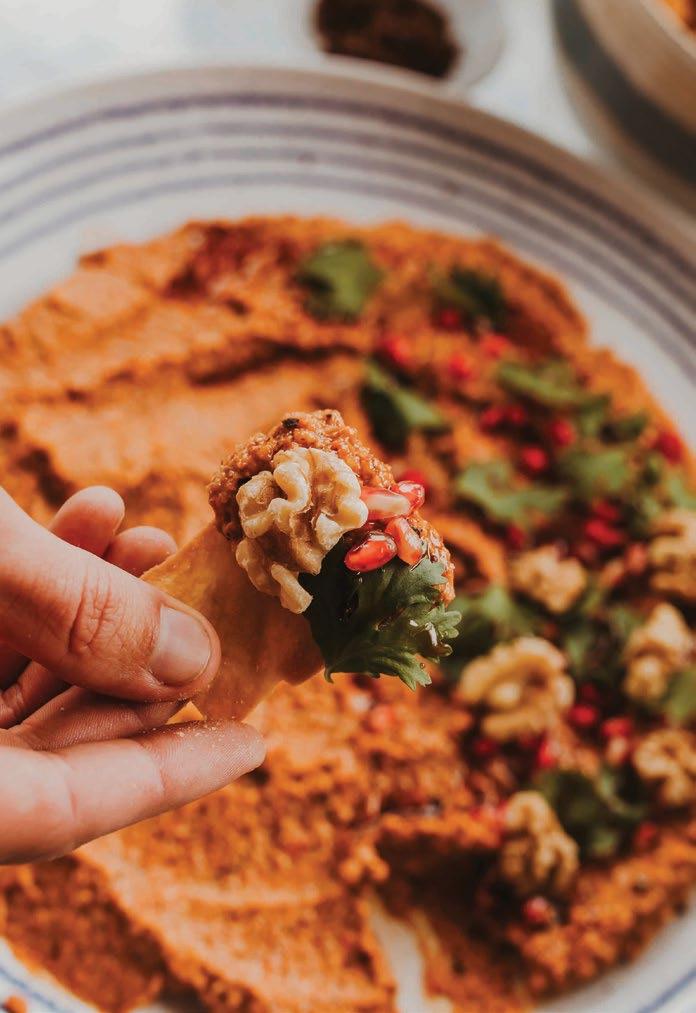
“Muhammara, a sweet and savory mezze made with roasted red bell peppers and walnuts, is one of my all-time favorite dips. I appreciate its vibrant, red-orange color that brings life to any spread, and the complexity of flavor (tangy, smoky, spicy, sweet) makes for an exciting departure from our typical American fare. I enjoy sharing this recipe with friends, family, and neighbors any time of the year!”
Ingredients
• 1½ cups red bell peppers, roasted
• 1½ cups walnuts + extra, for topping
• 2 tsp. salt
• 2 tsp. cumin
• 2 tsp. fresh lemon juice
• 3 tsp. Aleppo pepper (or red pepper flakes)
• 2 tsp. za’atar (optional)
• 3 Tbsp. pomegranate molasses
• 10 Tbsp. panko bread crumbs
• 10 Tbsp. olive oil
• Pomegranate seeds, for topping (optional)
• Mint, for topping (optional)
• Cilantro, for topping (optional)
Directions
Place red peppers, walnuts, salt, cumin, lemon juice, Aleppo pepper, za’atar, pomegranate molasses, bread crumbs, and olive oil in a food processor or blender, and pulse until well combined. The end result should be coarse, but slightly creamy. Pour into a serving bowl or wide-rimmed plate. Top with extra walnuts and pomegranate seeds, mint, and/or cilantro, if using. Serve with pita chips, soft pita, pretzels, carrots, celery, or just about anything else you’d like.

Expert craftsmanship, timeless design, and high-quality kitchen essentials provide the ideal landscape for crafting a perfect meal. Whether hosting friends after a round of golf, grilling for family, or simply cooking for one, what follows are a collection of kitchens and the staples that fill them – perfect for any southern gentleman looking to whip up a five-star meal.

1 Tile is a popular and versatile addition to any kitchen. Here, a simplistic tile design adds a classic visual that complements the room’s neutral palette and enhances the overall functionality of the working kitchen.
2 A tiled backsplash is aesthetically pleasing and is available in an array of colors, textures, and styles to suit any homeowner’s tastes. It is also hypoallergenic and nonflammable, providing an extra safety feature when using cooking oils.
3 Tiles can be used on a kitchen floor and offer the benefits of being slip resistant, impermeable, and easy to clean. This low maintenance feature gives the chef more time to focus on preparing meals in a beautiful environment.

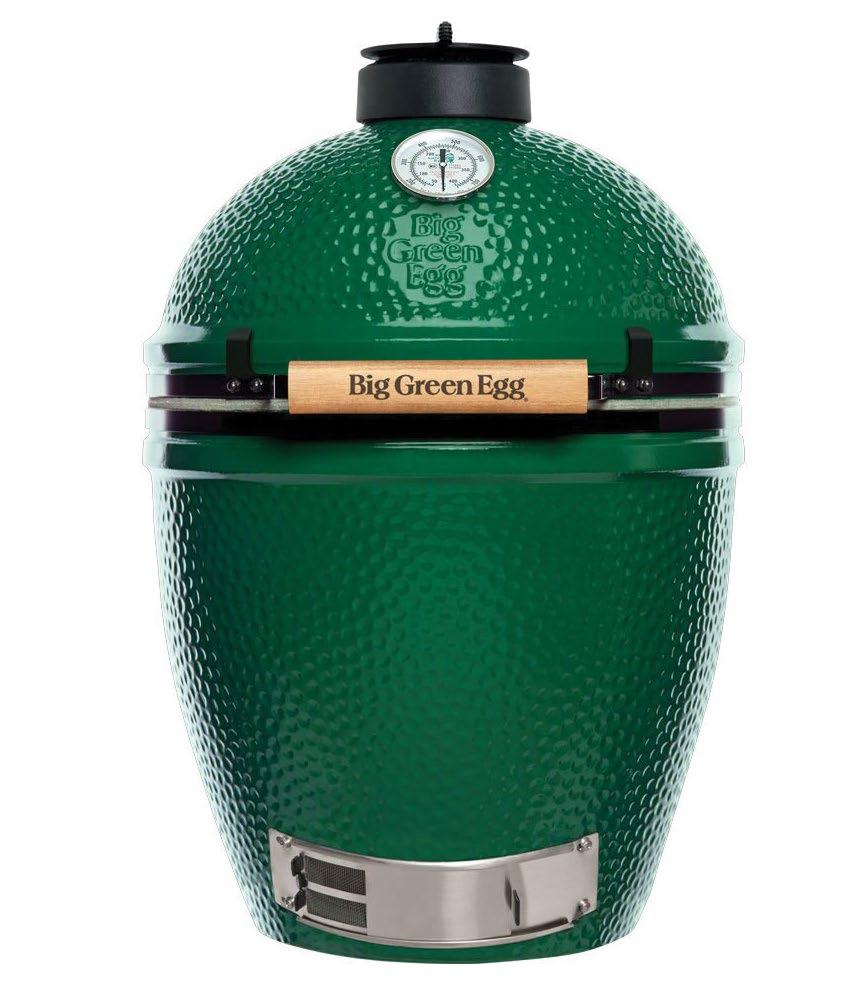


1
Big Green Egg is a premium, versatile outdoor cooker that functions as a grill, oven, and smoker. Made from durable ceramic, it retains heat efficiently, delivering precise temperature control for a wide range of cooking styles. Available in a variety of sizes, Big Green Egg is ideal for both casual grilling and gourmet cooking in the outdoors.
2
Fire pits can add a warm and inviting ambience to any outdoor dining setting. Crafted with premium materials and attention to detail, OW Lee’s Casual Fireside fire pits offer exceptional durability and performance, whether for relaxing evenings with family or entertaining guests.
3
It’s easy to relax in the Modern Curveback Adirondack Chair. With spacious seat cushions, these chairs feature curved back slats and a waterfall front for added comfort. This blend of contemporary and comfort is the perfect complement to outdoor dinner parties.



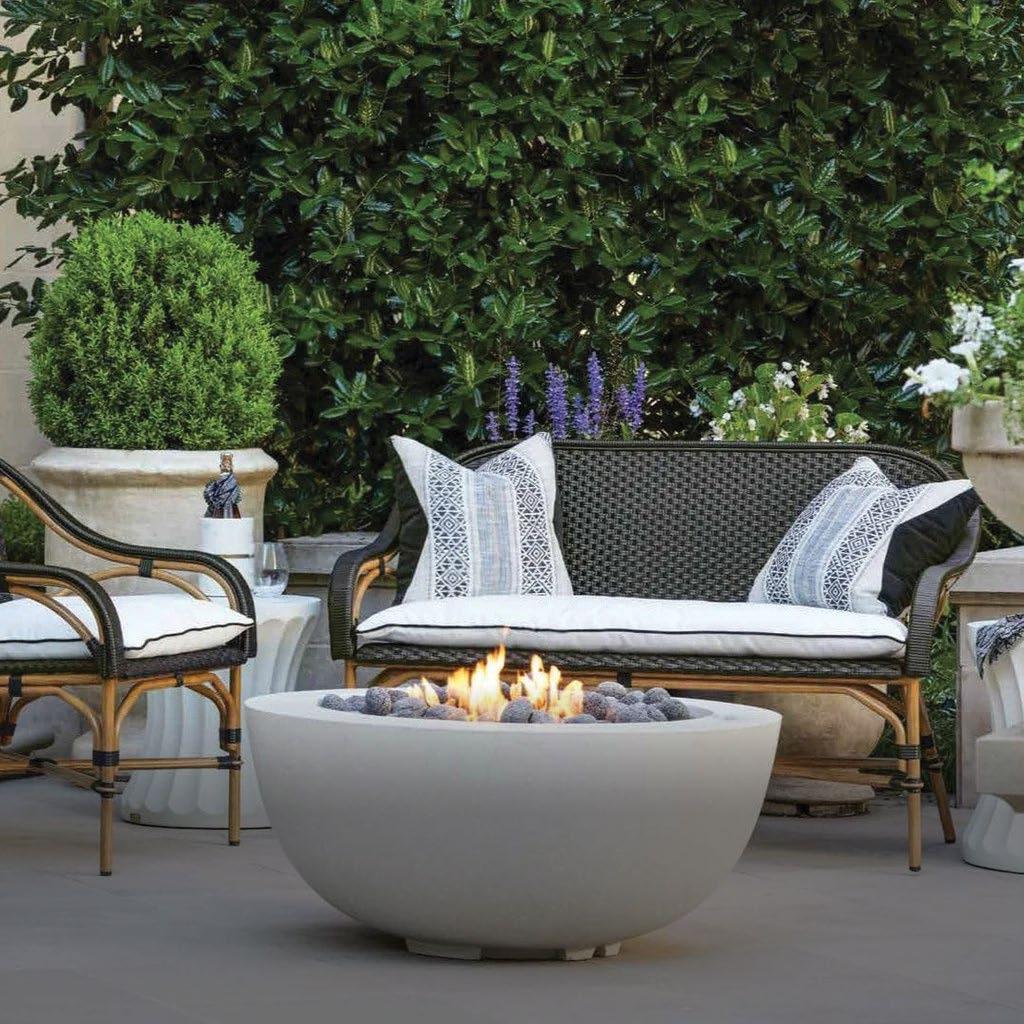



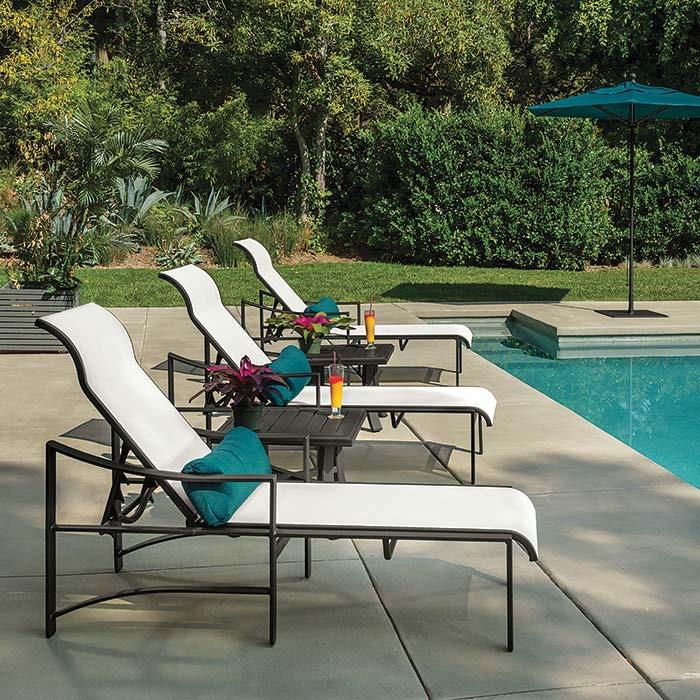
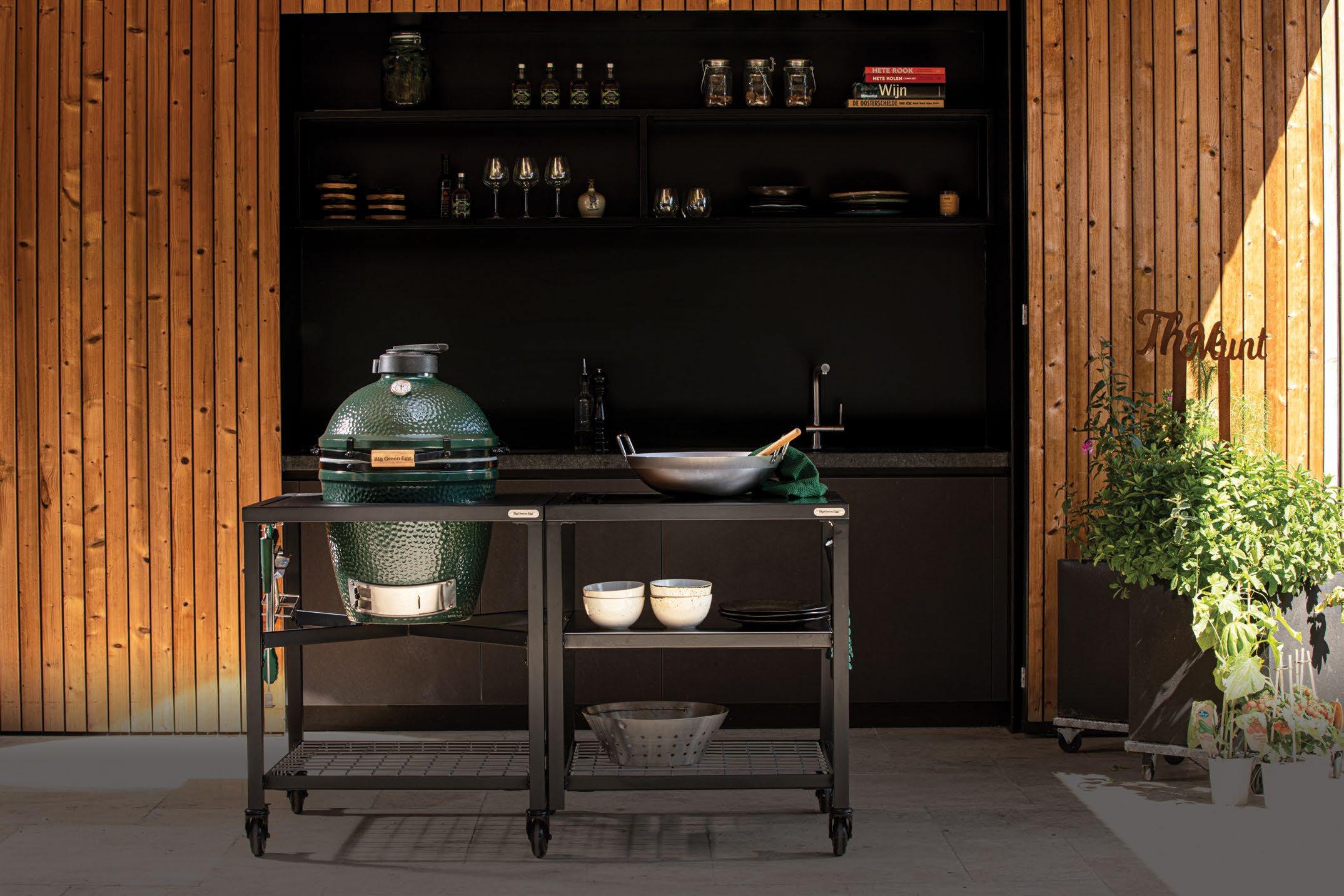
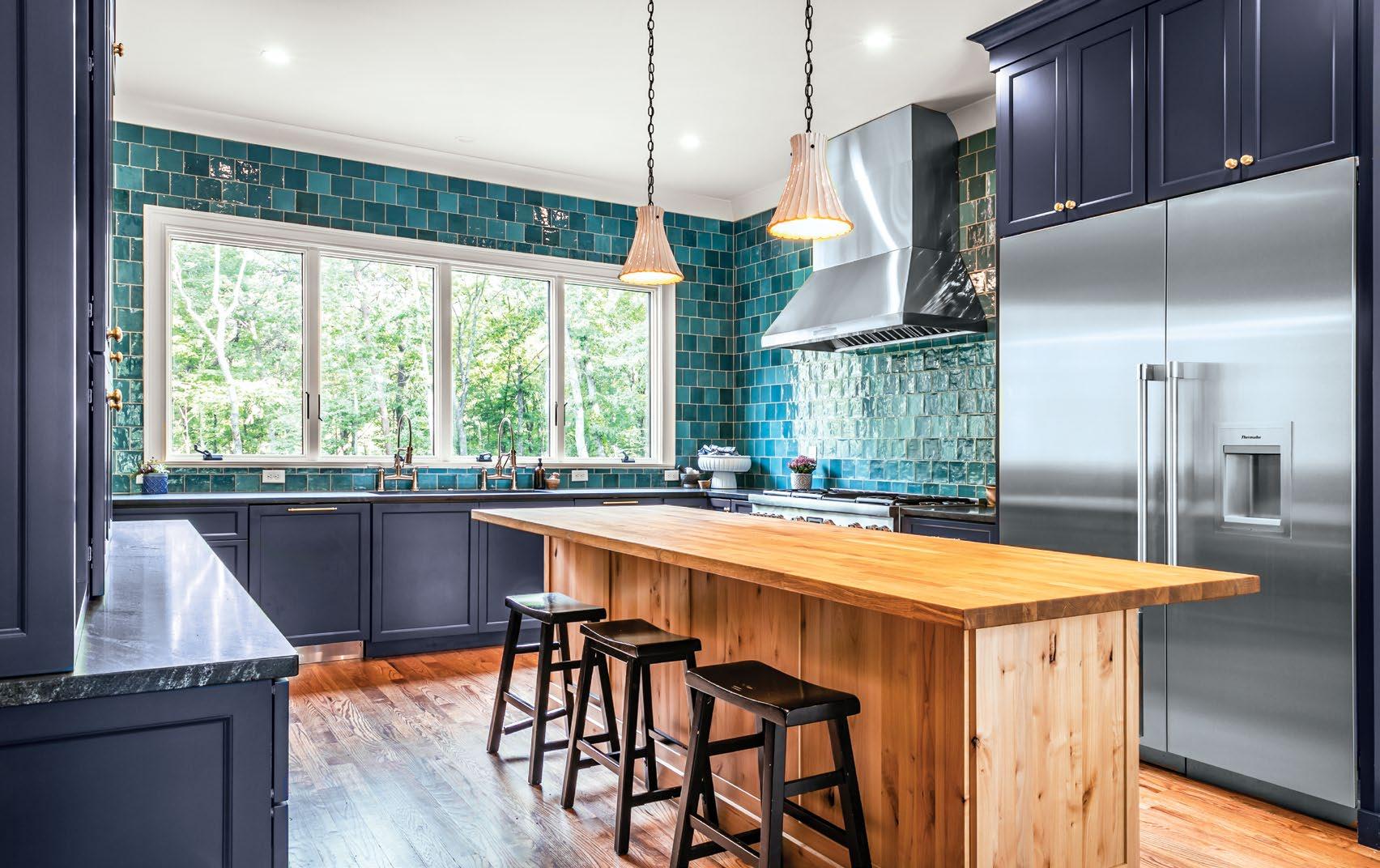
1 Nothing says wow like a wall of colorful tile! The first thing you notice in this kitchen is the beautiful blue backsplash tiles. They cover the walls and protect from splatters as well as provide visual interest in the room.
2 Let’s talk about the double faucet situation! This sink is built for two. The extra-wide sink bowl and dual faucets are perfect for cooking together and allow for simultaneous prep work and clean up for large occasions.
3 Granite countertops are the workhorse of a kitchen. The Negresco honed granite in this kitchen will last forever, is easy to clean up, and looks sleek and modern.
PHOTO BY SARAH UNGER



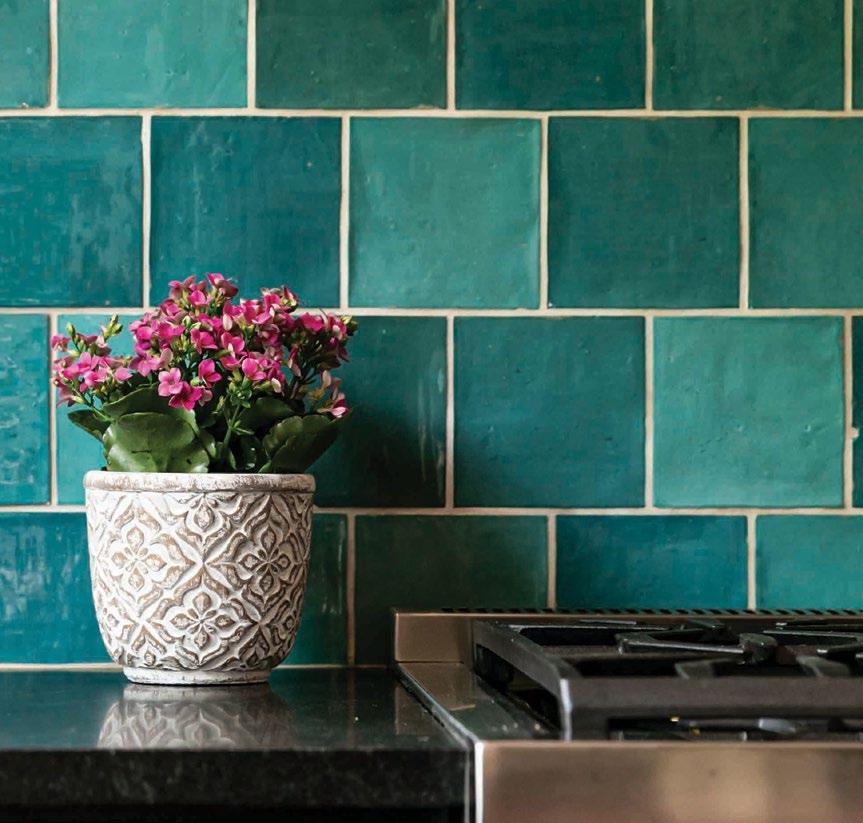

1 Hutch cabinets are a handy storage solution that can help keep counters clutter-free. Conveniently located in a central spot in the kitchen, this hutch cabinet features pocket doors and custom shelving designed to store appliances, coffee cups, and more within easy reach.
2 Including a furniture base in kitchen cabinetry is a simple way to elevate the room’s design. Available in a variety of styles to suit any homeowner’s tastes, this easyto-install accent can give cabinetry a high-end look.
3 A convenient and customizable kitchen addition, coffee bars provide a set-aside space for preparing beverages. This custom coffee bar blends seamlessly into the kitchen’s design and includes a sink, plenty of cabinetry storage, and open shelving to display décor.

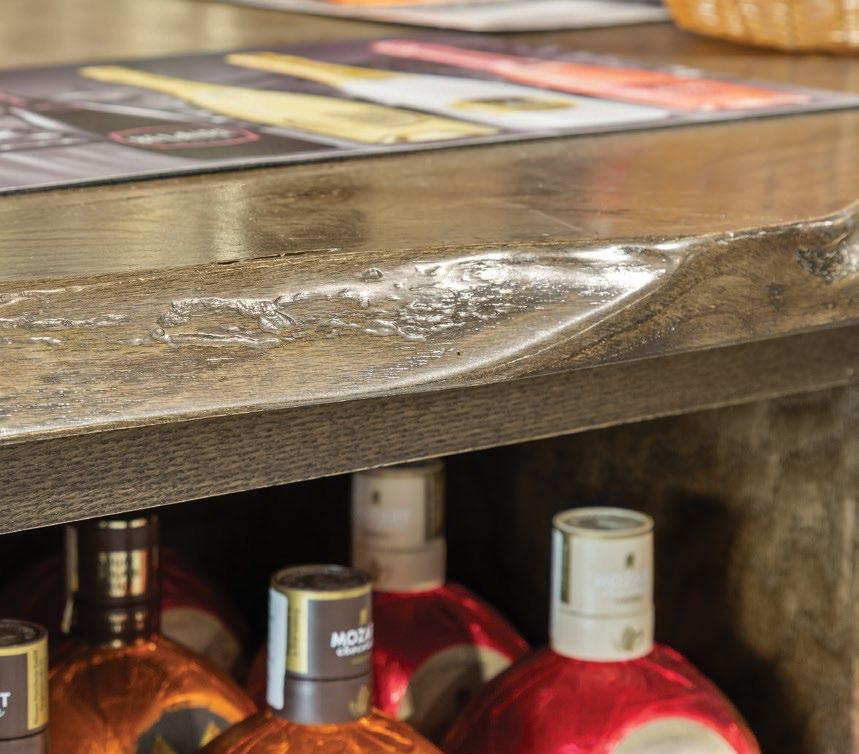

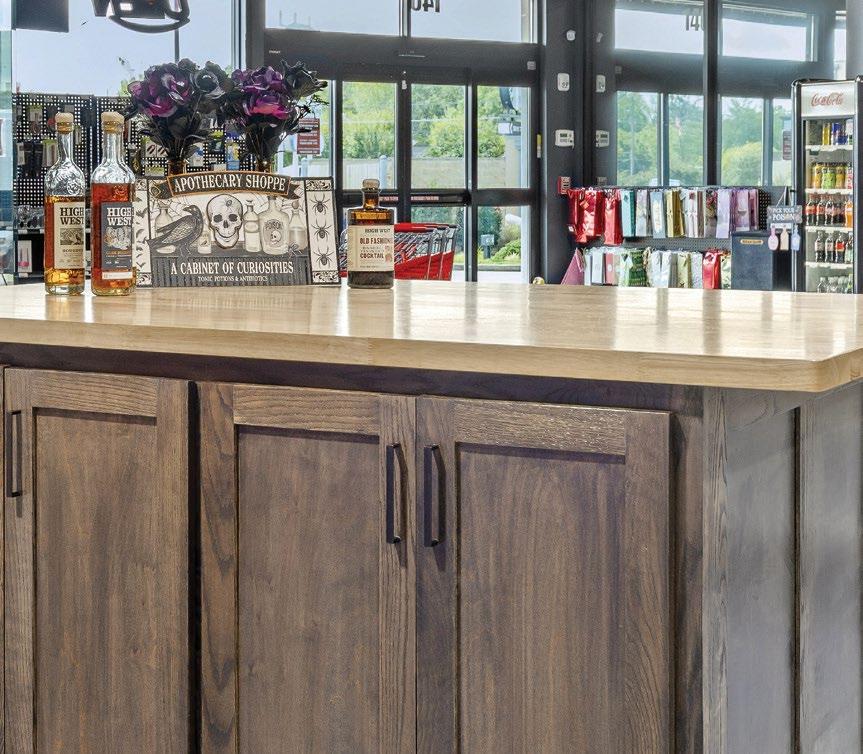





1
These CW Woodworking cutting boards are handcrafted by local artisan, Garit Sullivan. Available in multiple sizes, each cutting board is not only functional but a piece of art for your kitchen.
2
The Lodge Enameled Cast Iron Dutch Oven can handle it all – soups, braises, pasta sauces, cassoulet, and more! This versatile pot is a must-have in any kitchen and its durable design means it will last for decades.
3
For over 40 years, Samuel Lamont Poli-Dri tea towels have been a kitchen mainstay. These super absorbent towels come in a variety of colors and are a worthwhile addition to any home kitchen.
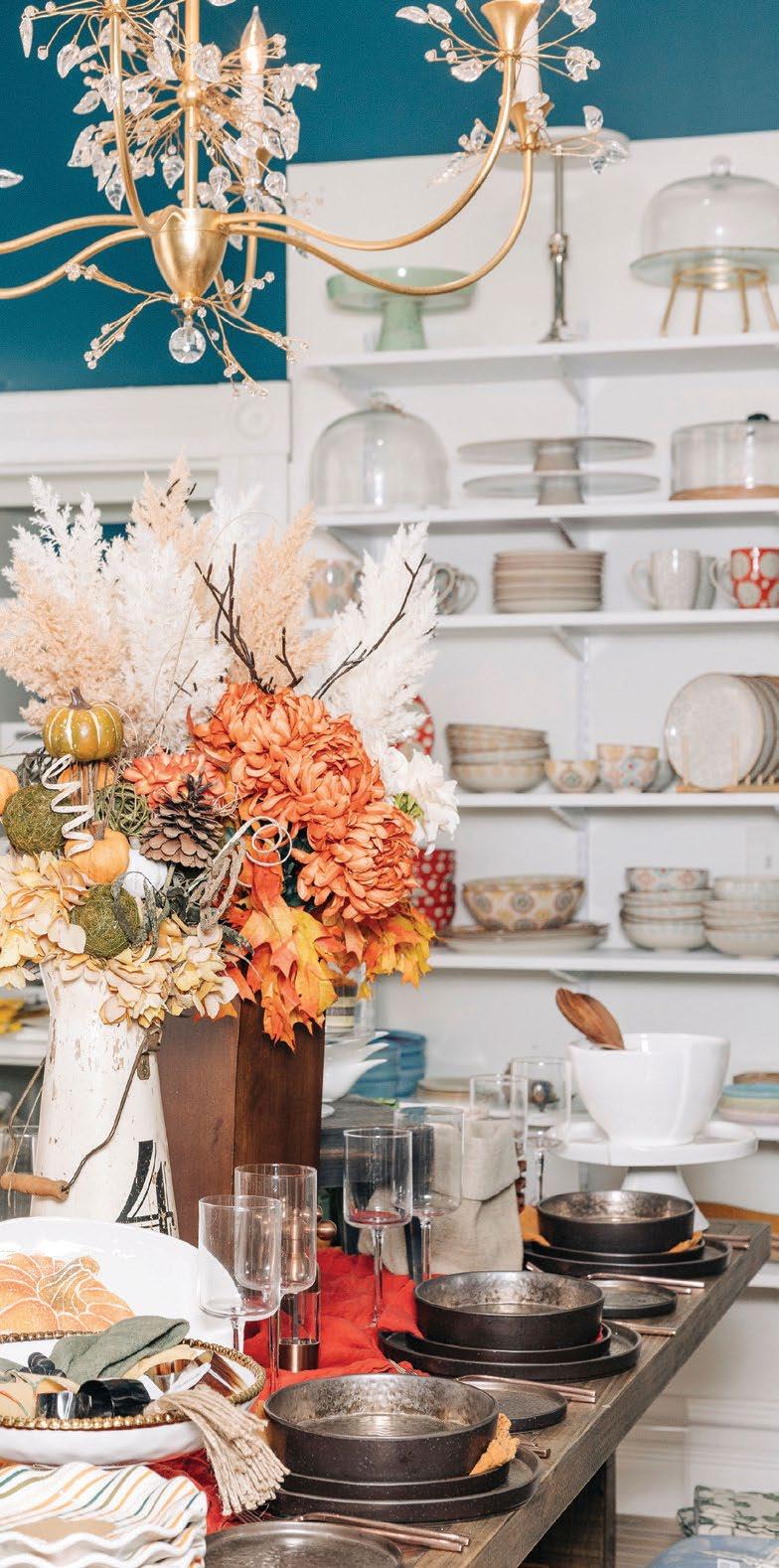

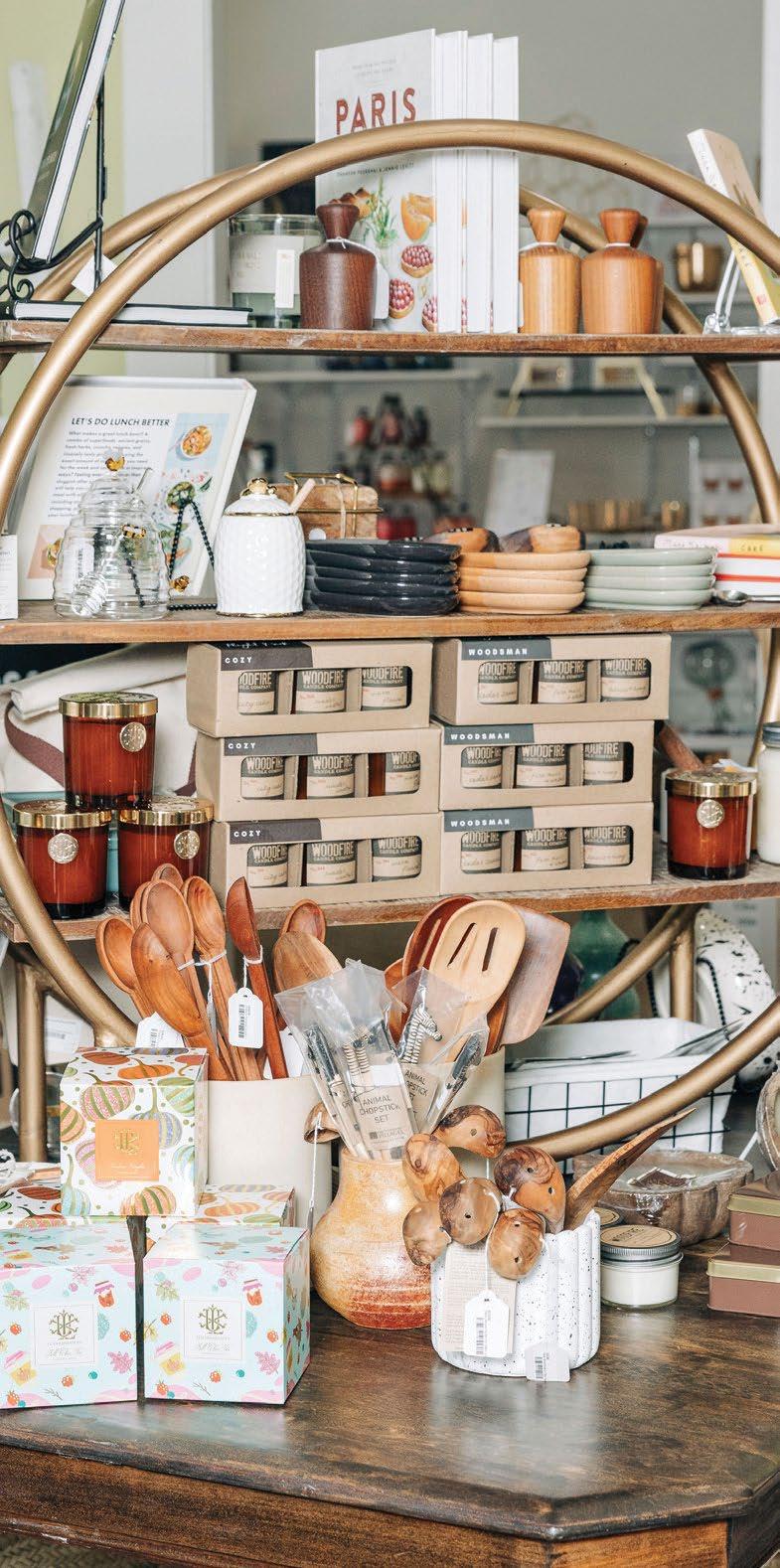

1 The centerpiece of this kitchen is the striking waterfall countertop on the center island. The seamless design of Classic Calacatta Quartz flowing over the sides adds a touch of luxury and modern flair to the space. This design choice not only enhances visual appeal but also increases the functionality of the island, making it ideal for both food prep and social gatherings.
2 Chattanooga Cabinets and Floors’ white shaker cabinet collection combines timeless design with modern craftsmanship. These cabinets are not only visually stunning but built to last, with durable finishes and materials tailored to your space and lifestyle.
3 Using the latest technology, these Chattanooga Cabinets and Floors™ cabinets are precisely measured, cut, and finished by highly skilled craftsmen, resulting in a flawless fit and finish that enhances both the aesthetics and functionality of the space.
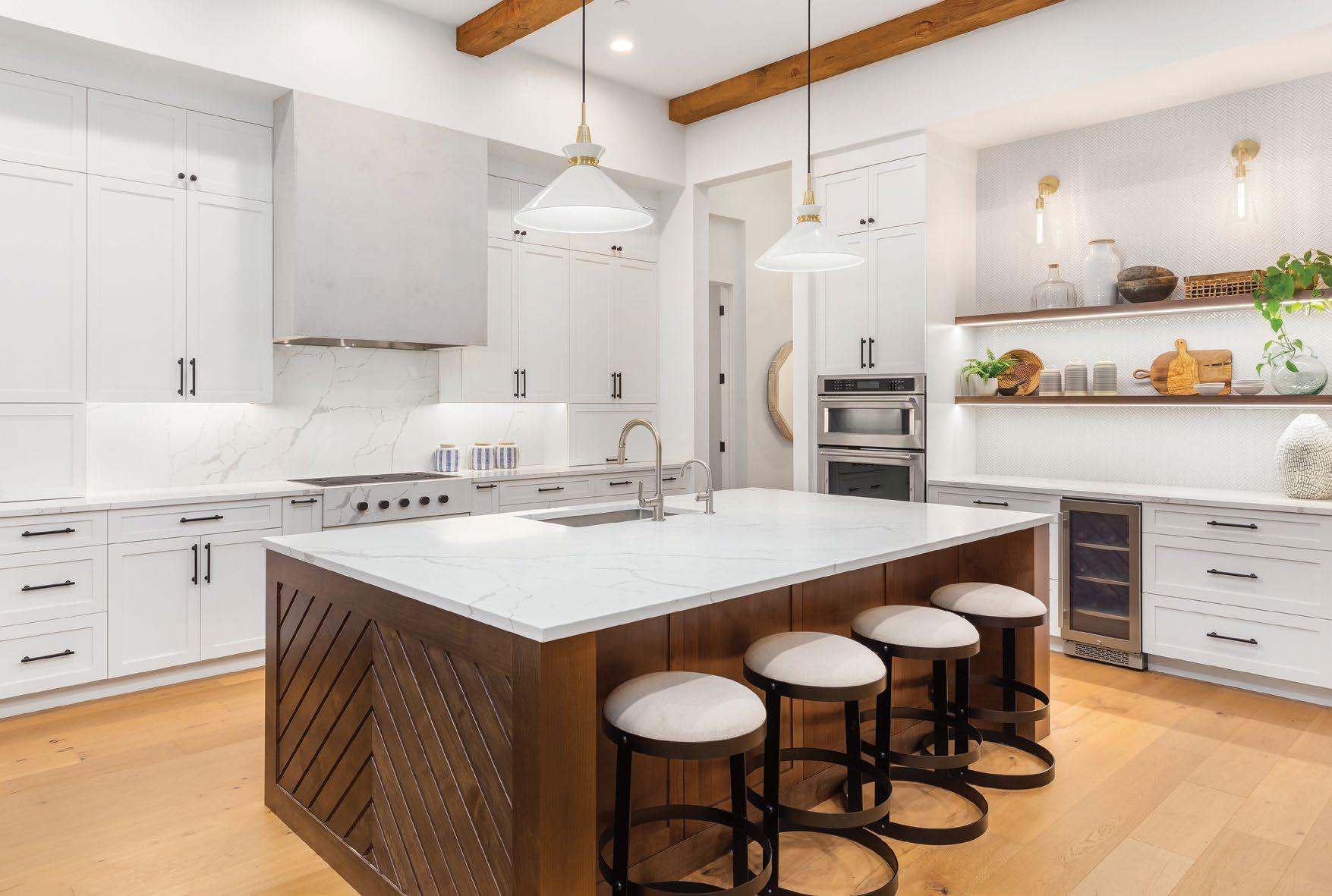
From bacon to ham and more, pork is a staple meat in the Southern diet. Here, we break pork down into its primal and subprimal cuts and discuss some of the best ways to prepare them. Whether you’re hosting a family dinner or a backyard barbecue, this guide will make sure you’re ready to impress your guests.
BY ALI LEMMONS
Typically, pork can be broken down into four basic, or primal, cuts: shoulder, loin, leg, and belly. Each of these primal cuts can later be divided into subprimal cuts. Retail cuts are even smaller cuts of meat that are sold in the grocery store, like bacon, pork chops, and more. Each cut varies widely in its fat content, tenderness, flavor, and texture, so it’s important to adapt your cooking technique to the cut of meat you will be using.
Pork shoulder is cut from the front portion of the hog and is typically high in fat. The upper portion of the shoulder is referred to as the butt, and the lower portion is called the picnic. Pork shoulder can be divided into five different subprimal cuts: blade, shoulder, jowl, hock, and front feet.
How to prepare it: Because shoulder portions are usually tougher, these cuts are best slow-cooked, with techniques like roasting or braising, to tenderize the meat for that melt-in-your-mouth texture. Due to its higher fat content, pork shoulder is also a popular choice for making sausage links or patties which are best pan-fried and grilled.
Pork loin is cut from between the shoulders, all the way to the back legs. This is the most tender and lean part of the pig and produces popular retail cuts like loin chops and tenderloin roasts. Loin is also one of the easiest cuts to cook, and it can be divided into three subprimals: rib end, center, and sirloin.
How to prepare it: Because loin is already tender, slowcooking methods aren’t necessary. Instead, opt for a dry heat technique, such as grilling, baking, or sautéing. The loin center, the most popular cut for pork roasts and chops, can also be pan-seared or braised.
Pork leg comes from the pig’s hind legs and rear, all the way up to the hip. This is where ham is cut from. Leg can be divided into four subprimals including butt, shank, hock, and back feet.
How to prepare it: Most hams are cooked through a curing and smoking process before they wind up on store shelves. While country hams are safe to eat with no cooking required, try pan-frying for additional flavor. Wet-cured, or “city” hams, simply need to be thoroughly heated, usually by baking. However, you can choose to add an extra glaze or marinade to upscale the dish. While hock can be slowcooked and eaten as an entrée, it’s also a popular choice to throw them in soups and stews for extra flavor.
Cut from the bottom portion of the middle of the hog, pork belly is one of the fattiest cuts, and usually inexpensive. Pork belly does not have subprimal divisions, but its most popular retail cuts include bacon and spare ribs.
How to prepare it: Because of its high fat content, bacon is prepared best by pan-frying to get that crisp, crunchy texture. For spare ribs, try roasting or smoking to tenderize the meat, make it juicier, and give it that delicious, smoky flavor.

Soft, flaky, and deliciously versatile – biscuits are an iconic Southern staple. Topped with a swipe of melty butter or dressed up with a drizzle of caramel sauce, there are endless ways to bring this classic comfort food to the next level. Read on for four mouthwatering recipes from local Chattanooga chefs.
Photography by Kristina Armstrong

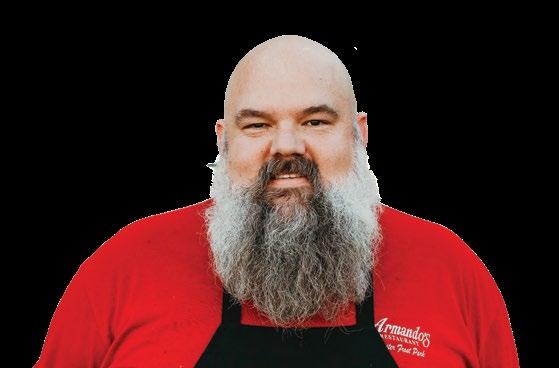
Ingredients
• 1¾ - 2 cups all-purpose flour, sifted, divided
• ½ tsp. salt
• ⅛ tsp. baking soda
• ⅛ tsp. baking powder
• 3 Tbsp. Crisco shortening
• ¼ cup Sprite
• ¼ cup whole buttermilk (do not use fat-free, skim, or 2%)
• Strawberry jam, to taste
• Butter, softened, to taste
Directions
Preheat oven to 425°. Add the salt, baking soda and baking powder to about 1½ cups of sifted flour. With a fork or pastry blender, cut shortening
Tip: Make this recipe vegan by replacing the buttermilk with Sprite
into the dry mix, not so much as to blend it, but to get the shortening broken down into smaller pieces, covered in the flour.
When it's a crumb texture with no lumps larger than a pea, add the Sprite, lightly folding the mix to wet the crumbs. Then add the buttermilk, slowly folding it in, not really stirring, to just wet the dough into a sticky single mass. It may need a little more flour if it’s too sticky, but we can adjust now as we dump the dough out onto a floured countertop. Slowly fold the mass onto itself, at least three times, to make the layers in your biscuits. Add even more flour – only as needed – to keep the dough from sticking to your work surface, hands, and the biscuit cutter.
Pat out your dough to about ½ inch thick, or your desired thickness. With your biscuit cutter of choice, press quickly straight down, no twisting, and place all the raw biscuits, touching each other, on the preferred baking vessel. (Higher sides, like cast iron, will result in taller biscuits. Just like they climb up each other, they'll rise on the walls of the pan they're baked in as well.) Take remaining dough, fold it back into a mass, flatten, and cut again, until there's none remaining.
Bake at 425° for about 12-15 minutes, until lightly golden brown, or modify time depending on your preference of color and doneness. Top with plenty of strawberry jam and softened butter, and enjoy.
“My grandad, the breakfast guy, amongst other titles, would pat these biscuits super thin and bake them till they were a little drier, but that's what he wanted for cleaning up everything on his plate, especially my grandmother's strawberry freezer jam mixed with copious amounts of soft butter. Kind of like the dessert of his breakfast.”


Ingredients
For the caramelized onion butter:
• 1 sweet onion
• 1 cup Sprite
• 1 Tbsp. soy sauce
• 1 tsp. Dustin Poirier’s Creole Maple Hot Sauce or hot sauce of choice
• 2 Tbsp. brown sugar
• 2 Tbsp. syrup
• 2 Tbsp. salted butter
• 1 Tbsp. rice wine vinegar
For the brown butter-bottomed Sprite biscuits:
• 1 stick salted butter, halved (one half cubed and refrigerated)
• 2 cups Bisquick + extra for dusting
• ¼ cup Sprite
• ½ cup sour cream
For the beer cheese dip:
• 6 oz. Coors Light or beer of choice
• 2 oz. cream cheese
• 4 oz. white cheddar, freshly shredded
• 4 oz. gruyere, freshly shredded
• 5 slices of white American cheese
• ½ tsp. smoked paprika (optional)
• 1 Tbsp. Texas Pete hot sauce (optional)
• Chives, to taste (optional)
• Bacon bits, to taste (optional)
Directions
First, get caramelized onion butter going, as it will take a little longer
to cook than everything else. Blend all the ingredients together, except for the butter and vinegar. Melt the butter in a pot over medium heat and pour your onion concoction on top. Simmer for 20 minutes, stirring every 3-5 minutes. (Tip: Start your biscuits now.) After 20 minutes, crank the heat to high and let the onions scorch and brown a little while moving the mixture back and forth for a couple of minutes. Kill the heat and add vinegar to deglaze the bottom of the pot. You should be left with an umami bomb mixture that resembles apple butter.
For the biscuits, take your half stick of solid butter and melt it in a pan over medium heat until it starts to brown a little. Once you start to see the browning happen, kill the heat completely. Pour the butter on your baking sheet to cool. (The biscuits will go on top.)
Then, dust your surface with a small handful of Bisquick. In a bowl, cut your butter into 2 cups of Bisquick until it’s incorporated. (Try not to handle it too much so the butter stays cold.) Add the Sprite and sour cream and work them into the Bisquick gently until you start to have a unified dough. It’s okay if it’s a little wet. Move the dough to the dusted surface and keep working it gently until it’s not tacky. Add a sprinkle of Bisquick as you go if needed. Fold the dough no less than six times over
itself, turning it 90° each time you fold. Press the dough down with your hands onto the surface until it’s around the thickness of your hand.
Dust your glass or biscuit cutter in Bisquick to press and cut the dough. (Don’t twist. Push down and pull up.) Depending on the size of your cutter you should get around 6-8 biscuits from one batch. Place the biscuits on the brown butter on your baking sheet and refrigerate for 20 minutes. Preheat your oven to 450°. Pop your biscuits from the fridge directly to the oven. (Tip: Start your beer cheese now.) Check the biscuits for golden brown tops at 15 minutes. If they need a little longer, check them every 2 minutes until they are golden.
For the beer cheese, whisk the beer and cream cheese together in a pot over medium heat until the cream cheese has melted into the beer. Add your shredded and sliced cheeses. Slowly fold the cheese in and be patient as it melts. Once everything feels nice and smooth, kill the heat and add paprika and hot sauce and whisk. If you’ve played your cards right, the beer cheese should be the last thing to finish up. Pour your beer cheese directly on your biscuits and spoon or drizzle your onion butter on top of the cheese. For bonus points, you can add some chives and bacon bits to the top before serving.
“Biscuits, beer cheese, and caramelized onions ... need I say more? I crafted this recipe to be accessible to chefs of all levels by using ingredients you likely have on hand already. Most ingredients can be tweaked to your preference. Make this recipe your own and impress your friends with your skills on game day!”
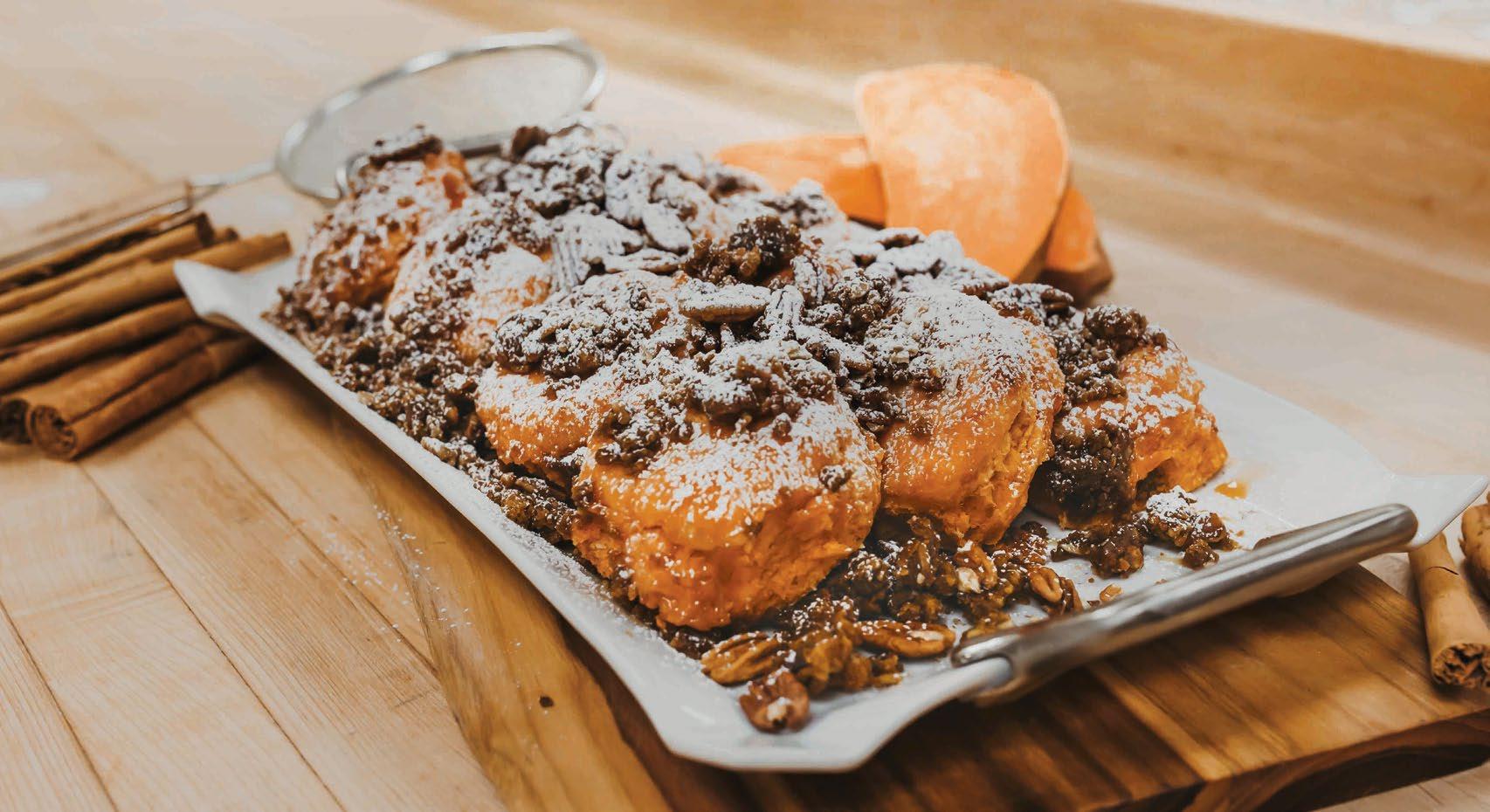

Ingredients
For the biscuits:
• 1 stick unsalted butter, extra cold
• 3 cups all-purpose flour
• ½ tsp. salt
• 2 Tbsp. baking powder
• 2 Tbsp. white sugar
• ¾ cup buttermilk
• 1 small sweet potato, baked and mashed
• 2 tsp. vanilla
• Powdered sugar, for garnish
For the pecan streusel topping:
• 1 cup dark brown sugar
• ⅓ cup all-purpose flour
• 1 cup pecans, chopped
• ½ cup sweet cream unsalted butter, melted
For the salted caramel sauce:
• ½ stick unsalted butter
• ½ cup dark brown sugar
with Crunchy Pecan Streusel Topping & Salted Caramel Sauce Drizzle YIELDS 8-10 SERVINGS
• 1 tsp. vanilla
• ¼ cup heavy cream
• Kosher salt, to taste
Directions
Place 1 stick of unsalted butter in the freezer 15 minutes before you begin the biscuits. Next, make the pecan streusel topping. Combine dark brown sugar, allpurpose flour, pecans, and melted butter in a bowl. Mix with hands until the mixture resembles wet sand and keep in an airtight container at room temperature for storage. Then start the biscuits by mixing flour, salt, baking powder, and sugar in a mixing bowl. Remove the unsalted butter from the freezer, and grate it directly into the dry ingredients. Gently stir with a fork to combine. In a separate bowl, add buttermilk, sweet potato, and vanilla. Mix well. Add dry ingredients to wet and mix until combined. Don’t over-mix.
On a clean surface, add a dusting of flour and knead dough for 1 minute (don’t over-knead). Use a rolling pin to roll out dough until about ½ inch thick. Use a ring mold to cut out biscuits. Place on a greased oven-safe baking sheet. Brush buttermilk on top of each biscuit. Bake in oven at 425° for 12-15 minutes. Make the caramel sauce while the biscuits bake. Melt butter over mediumlow heat. Once melted, whisk in brown sugar until it’s dissolved, and then whisk in vanilla and heavy cream. Finish with kosher salt to taste.
Once biscuits are done, brush with melted butter and cover with pecan streusel topping. Place in a high broiler for 15 seconds or until a crust forms. It should get crunchy. Once it’s done, drizzle with salted caramel sauce and dust with powdered sugar.
“If you could capture the essence of the entire fall season and blend it with the charm of the Southern United States, then mix it into some flour with your wet ingredients, knead, cut, and bake the dough, you would create these delightful biscuits. They bring back fond memories of my childhood in the Deep South, evoking the spirit of autumn.”


For the lemon-blueberry skillet biscuits:
• 1 cup + 1 Tbsp. all-purpose flour, separated
• 1 cup cake flour
• 1 Tbsp. baking powder
• ½ tsp. baking soda
• 1 tsp. fine salt
• 1 Tbsp. sugar
• ½ cup blueberries
• 1 lemon, zested
• 1 stick unsalted butter, grated (very cold)
• 1 cup Cruze buttermilk (very cold)
• 1 Tbsp. fresh thyme leaves, chopped
For the thyme glaze:
• ½ cup powdered sugar
• 2 tsp. lemon juice
• 2 tsp. milk
• ½ tsp. fresh thyme, finely chopped
• Pinch of salt
Directions
Preheat oven to 425°. In a large bowl, sift flours, baking powder, baking soda, salt, and sugar. In a separate bowl, mix blueberries with lemon zest and 1 tablespoon flour. Set aside. Grate cold butter into the flour mixture and mix until it resembles coarse crumbs. Work fast so the butter stays cold. Reserve a dash of lemon zest. Then, gently fold in the lemon zest and blueberry mixture. Pour in cold buttermilk, sprinkle in 1 tablespoon of thyme, and stir until just combined. Turn the dough out onto a lightly
floured countertop. Using floured hands, shape dough into a rectangle the size of a piece of paper. Fold the dough into thirds and repeat, lightly rolling and dusting the dough three times. Pat the dough into an inch-thick rectangle slightly larger than your skillet and cut seven biscuits using a 2¾ inch biscuit cutter. Place the biscuits in a 10.25-inch Lodge skillet, so they are just touching. Brush with buttermilk and bake for 15-20 minutes, or until golden brown and risen. While the biscuits bake, whisk together powdered sugar, lemon juice, milk, ½ teaspoon of thyme, and a pinch of salt. Remove the biscuits from the oven, drizzle with glaze, and garnish with reserved lemon zest and extra fresh thyme as desired.
“Baking biscuits in cast iron isn’t just about making food, it’s about preserving a legacy. There’s a certain pride that comes with fresh biscuits coming out of a hot cast iron skillet, a tradition passed down from generations. As a chef and Southerner, there’s no greater joy than serving up something made with love, knowing that every biscuit holds the warmth of family, the comfort of home, and the heart of true Southern hospitality.”

By Tory Irmeger
Forks, plates, and linens – oh my!
Dining etiquette has befuddled many over the years, but setting an elegant table doesn’t have to be a puzzle. While dining customs and preferences may vary, you can’t go wrong with a convenient and beautiful setting for your guests. Here, we outline a basic format that can be tailored to any occasion, whether dressed to the nines or throwing an elevated backyard brunch.
The devil is in the details: ensure that your linens are wrinkle-free and clean. Opt for a tablecloth that fits the table with about 12 inches hanging over each side. Adding table runners or placemats is personal preference; they can add decoration and protection from spills and hot dishes.
Place silverware in the order in which they’ll be used throughout the meal, working from the outside to the inside. To the left of the plates, the exterior fork is for salad and the interior for the main course. To the right of the plates, lay the soup spoon on the exterior and the dinner knife – blade facing in – on the interior.
1. Dinner Plate
2. Salad Plate
3. Salad Fork
4. Dinner Fork
5. Dinner Knife
6. Teaspoon
7. Soup Spoon
8. Dessert Spoon
9. Cake Fork
10. Bread Plate
11. Butter Knife
12. Water Glass
Dessert silverware can be brought out with the dessert course or placed horizontally above the plates, spoon handle pointing right, fork handle pointing left.
Tip: Not serving soup or salad? Skip the utensils! Same goes for plates – only place what will be used for the meal.
The water glass goes to the right, above the placement of the dinner knife. Then, add in appropriate glasses for any additional drinks that may be served, such as wine, champagne, or other beverages. These glasses are placed to the right of the water glass and angled slightly closer to the guest.
Stack plates on the table in the order they will be used throughout the course of the meal, working from top to bottom. For example, you may start with a soup bowl, followed by a salad plate, followed by the dinner plate. A charger plate can be used at the base of the stack to protect the tablecloth and help retain heat in dinnerware. Note: some charger plates may not be food safe and are used only for decorative purposes.
Tip: To conserve space, wait until dinner plates are cleared away to bring out dessert serveware.
Here is a chance to add some personal flair. Cloth napkins are a must for a luxurious meal, and they can be neatly folded in any variety of shapes, so long as they are easy for guests to access. Place on top of the plates, in the water glass, or in a decorative ring beside the silverware.
13. Wine Glass (Red)
14. Wine Glass (White)
15. Coffee Cup
16. Napkin
17. Placecard
Place cards are a nice touch for parties with assigned seating or guests who may not know each other. Name cards are placed above the plates facing the guests, and they can be labeled on both sides. Ensure they are neatly printed with the guest’s correctly-spelled name, and use quality cardstock or stationery to take it up a notch.
Tip: If assigning seating, remember to pair guests with common interests to encourage conversation.
If serving coffee or tea with dessert, bring the cups and saucers out with the final course to avoid cluttering the table. For uniformity, set all the cup handles in the same position – typically 3 or 4 o’clock. (Exceptions can be made for your left-handed friends, who will thank you for such thoughtfulness.)
Centerpieces will add a decorative touch to your table, so long as they aren’t obtrusive. A large bouquet is a stunning showcase, but it may belong on a sidebar if it impedes guests’ ability to see each other around the table. Small or sprawling arrangements might be a better fit, while tea lights and candles are also ambient additions for evening meals. Ceramics, glassware, and even photographs can add a boutique touch.
Menu
For formal events like weddings or celebrations, you may choose to print menus to lay alongside the settings. Note if any dishes are vegetarian, glutenfree, or contain potential allergens. Want a conversation starter? Add fun facts, trivia, other interactive elements that will engage party-goers.

Special touches like rims, garnishes, and even ice can turn a good cocktail into a great cocktail. Here, we share ways to style your favorite drinks and elevate your bartending skills, as well as recommendations for spirits to elevate your sips.
By Kristen Dee


Whether including a monogrammed block of ice in a shot of whiskey or using skull-shaped ice for your Halloween party, custom ice can elevate a basic drink to the next level. There’s a variety of ice molds in different shapes and sizes depending on your theme, or for those looking for a new hobby, you can buy large blocks and sculpt the ice yourself. Remember, the more filtered the water is, the more clear your ice will be, so use filtered water when possible.
Adding a special rim to your cocktail glass allows for a decorative element to your cocktail while also enhancing the flavor profile. For tequila-based drinks, popular rims include Tajin seasoning and lime, while a lemon-drop martini is completed by a sugar rim. You can play with colors to add interest, such as black salt or pink sugar, for a fun and unique twist.


Citrus garnishes bring out citrus notes in cocktails or spirits, while also adding to the visual appeal with a pop of color. A lemon or lime slice is a classic addition to margaritas or citrusbased cocktails, an old fashioned requires an orange peel, and a lemon twist is a must for a dry martini.

Glassware can make a big difference in the experience of a cocktail. Some drinks, like beer, wine, and whiskey, have specific glassware meant to optimize the spirit and perfect the flavor, while other drinks allow you to get creative. To impress your guests, have proper glassware on hand for beer, wine, or whiskey, and opt for something more creative for cocktails. A funky glass such as an oversized oyster shell is a great conversation piece, while disco ball cups are an exciting celebratory vessel.

Skewers of fruits, olives, or even meat are a fun addition to a cocktail. Opt for luxe garnishes like gourmet cherries in syrup, olives stuffed with garlic or blue cheese, and maple bacon to take a drink over the top. Candy is also an exciting garnish option – peach rings, rock candy sticks, and dark chocolate are lovely pairings depending on your spirit of choice.
In the past few years, smoked cocktails have increased in popularity. The technique is often reserved for bourbons and whiskeys, but the flavor also lends itself well to tequilas, gins, and even beer. A smoked gin and tonic is a fun twist on a summery cocktail, and a smoked marshmallow-flavored whiskey alludes to campfire fun. Many stores sell cocktail smoker kits you can add to your home bar.


For the holidays or a themed-party, adding colorful liquors can spruce things up in cocktails and shooters. You can even add edible glitter if you’re feeling extra fancy.


When styling cocktails, including a premium spirit is always a good idea. Below are a few recommendations from our friends Shelby Whalen and Courtney Daniels, on premise sales representatives from Athens Distributing.
Pour this award-winning, twice-barreled bourbon over a big cube of ice and enjoy. Elijah Craig uses a custom finishing process which adds an extra layer of sweet oak, and a flavor they describe as “big, rich, and complex,” with notes of spice, pepper, chocolate, and a hint of smoke.


This Irish gin gets a unique flavor from slow-dried gunpowder tea, oriental botanicals, and citrus. It’s a fantastic choice for cocktails, but it’s especially great for a gin martini.

Made from 100% Blue Weber Agave, this balanced tequila is earthy with a hint of butterscotch and notes of caramel, vanilla, dried fruit, and chocolate. It drinks well on its own, or it is a great addition to a margarita, paloma, or other tequila-based cocktail.

Made from several different botanicals, Izarra is a unique green liquor that has hints of mint and spice. Use it to create a spooky green Halloween cocktail or a refreshing summery beverage.
Chopin’s family-owned vodka production, based in Eastern Poland, offers three styles of vodka –potato, rye, and wheat. Each is unique in its flavor and profile. The potato vodka is perfect for a classic martini, while peppery notes in the rye add interest to a bloody mary, and the lightness of the wheat goes well in fruity cocktails or spritzes.
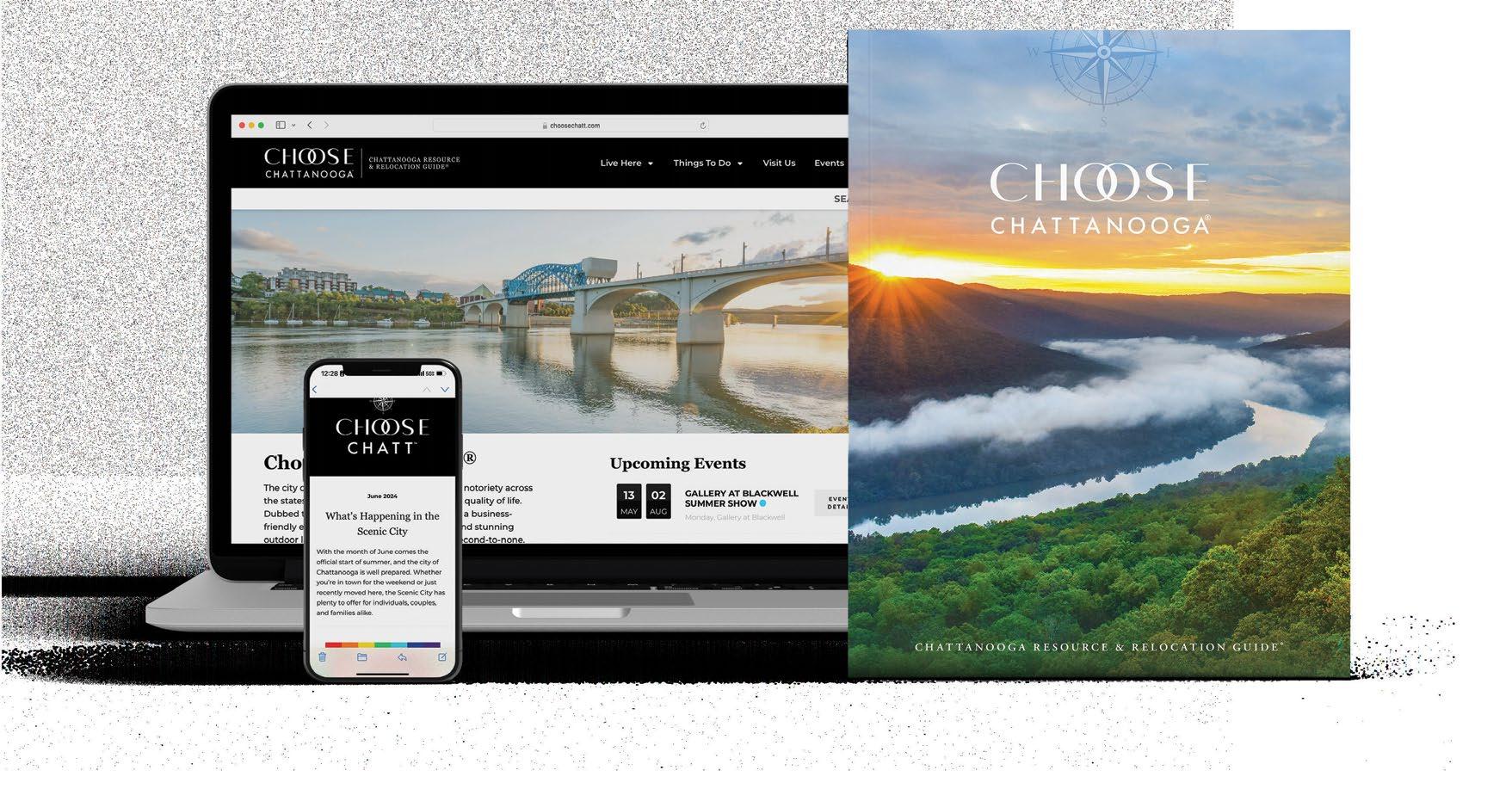


“FASHION IS NOT NECESSARILY ABOUT LABELS. IT’S NOT ABOUT BRANDS. IT’S ABOUT SOMETHING ELSE THAT COMES FROM WITHIN YOU.” – RALPH LAUREN
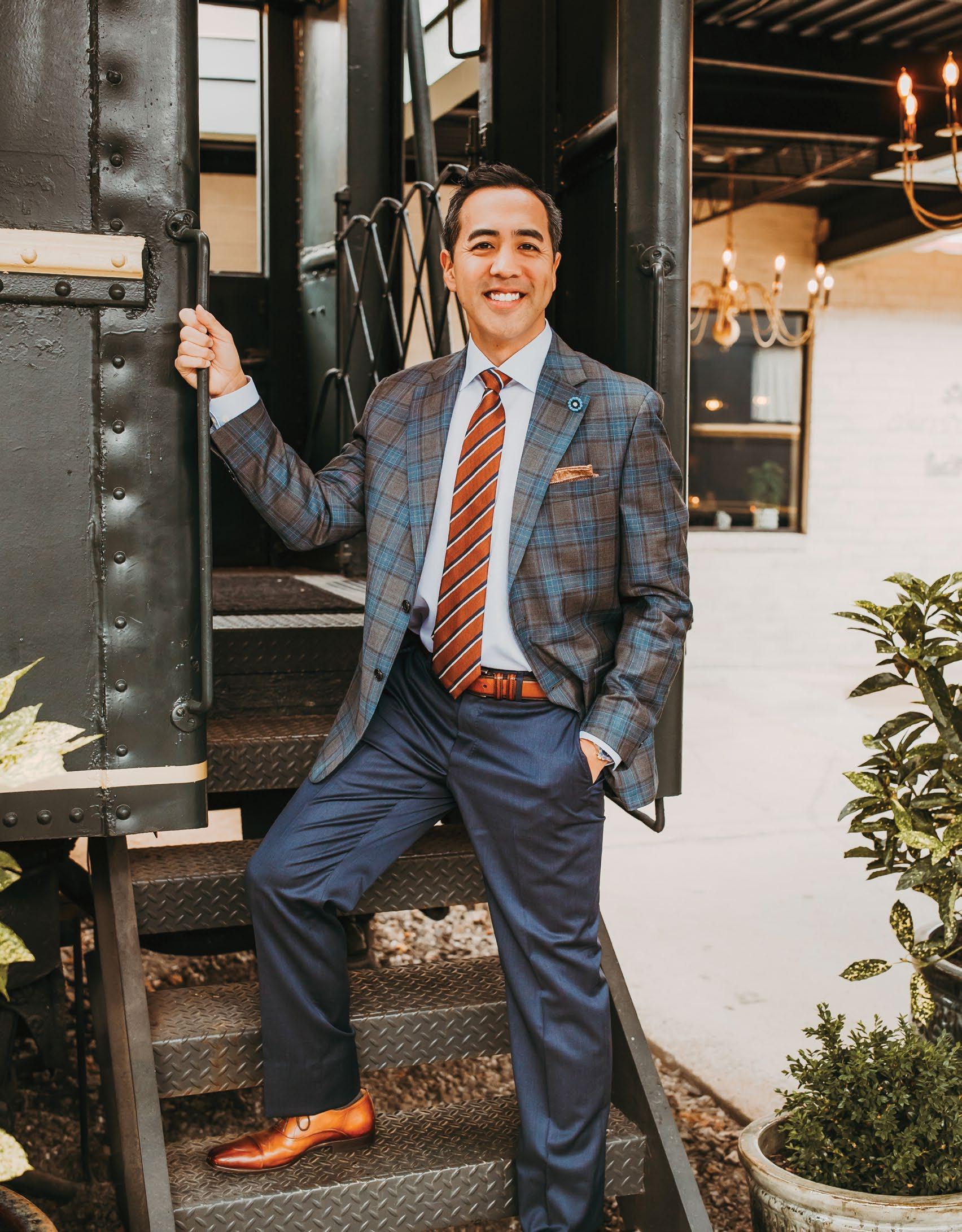
When it comes to elevating a clothing ensemble, prints and patterns are a classic choice for menswear. Whether dotted, striped, plaid, or more, a sport coat or shirt or aptly-placed accessories can make a stylish statement. Here, models outfitted by local retailers showcase sophisticated outfits featuring expertly paired prints and patterns.
By Rachel Studebaker |
outfitted by Yacoubian Tailors
This ensemble expertly combines both patterns and colors. Dr. Dizon’s plaid sport coat pairs nicely with navy dress pants, and his crisp white shirt provides the perfect background for a striped rust tie to pop. Additional warm accents include a pocket square and leather shoes, tying this sophisticated look together.
Yacoubian Tailors: Hart Schaffner & Marx jacket. Eton shirt. Zegna tie. Ballin trousers. Magnanni shoes. Peter Millar pocket square.
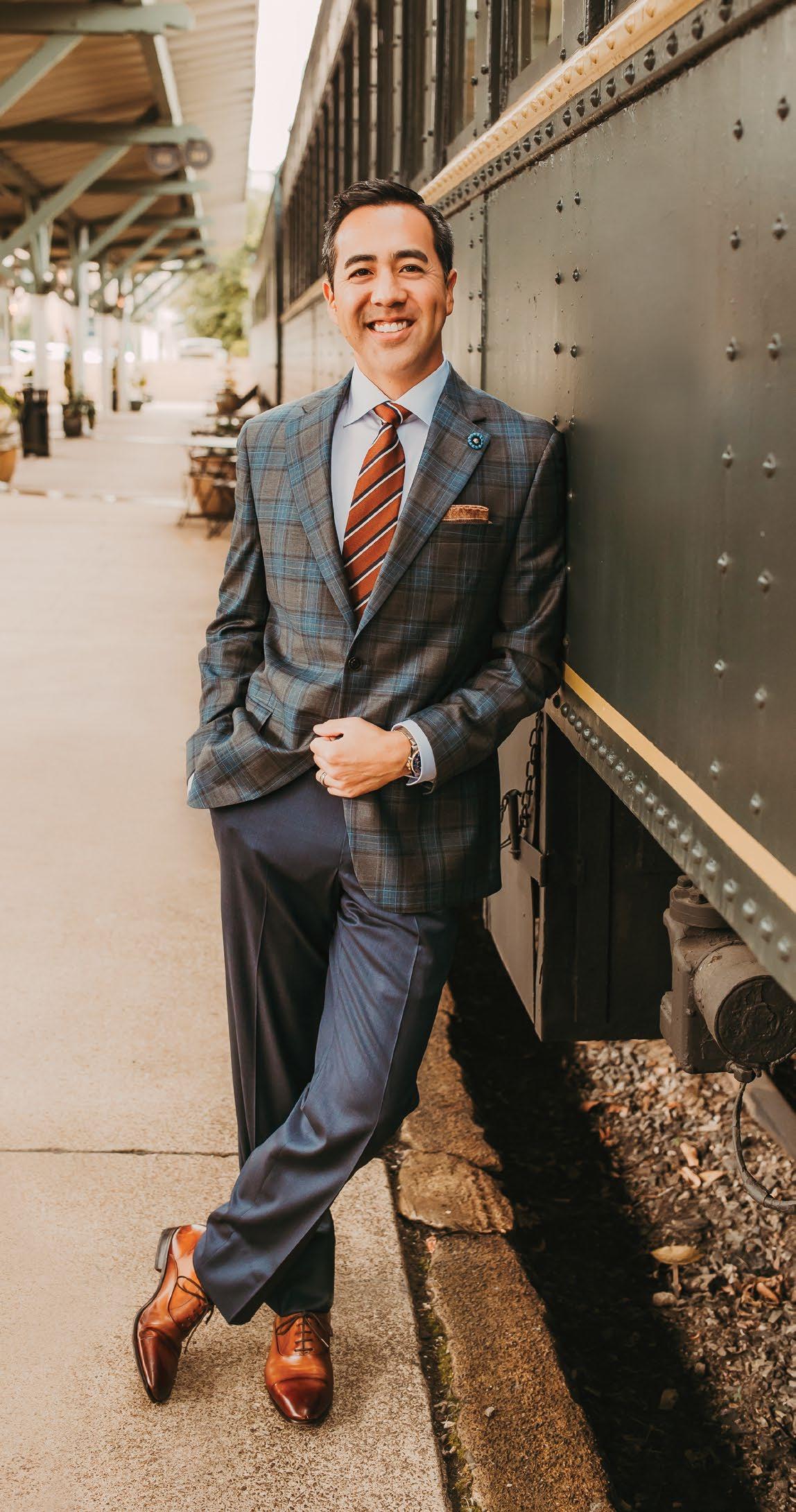
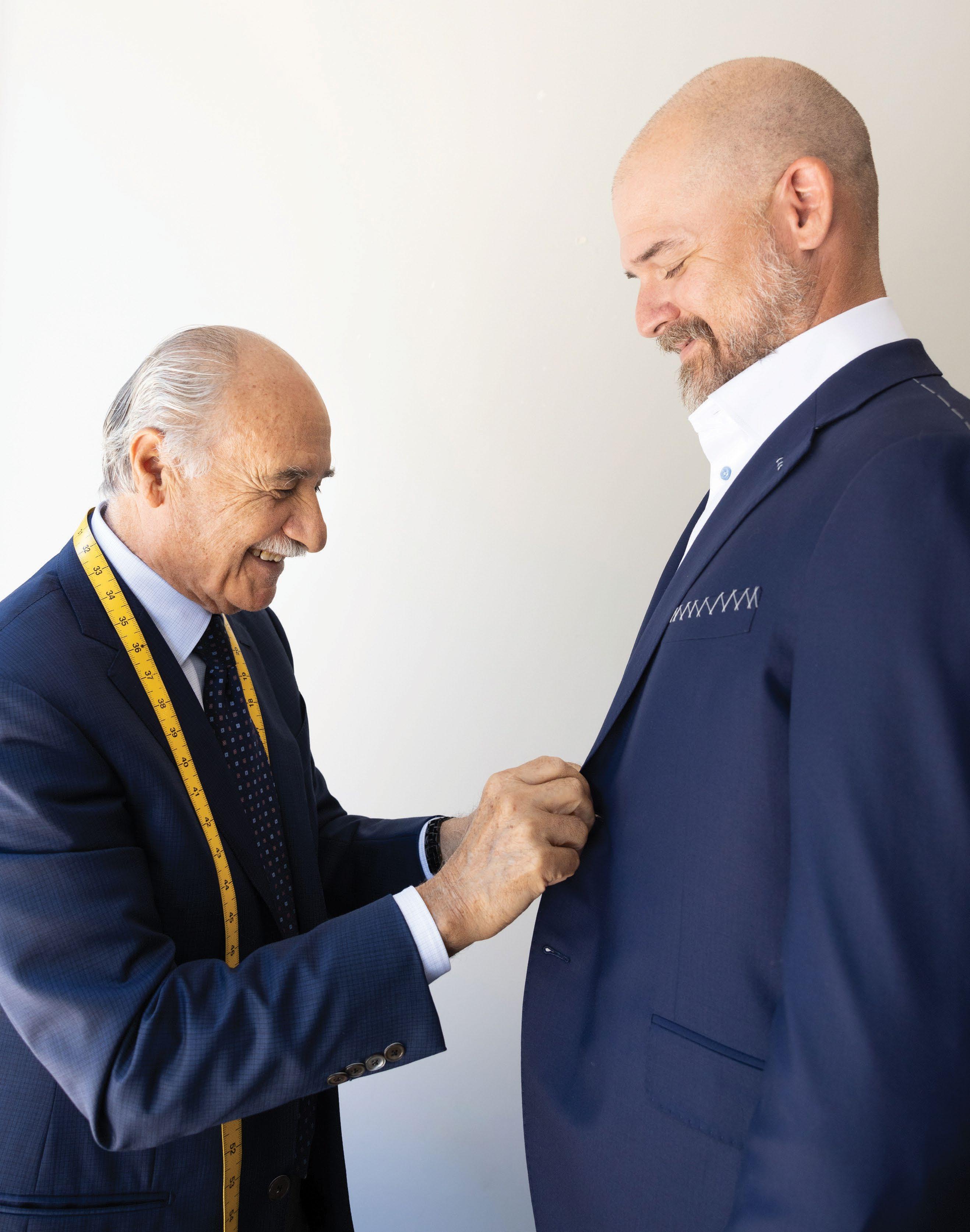
outfitted by
Tom James Company
Shades of blue take center stage in this stylish look that layers patterns.
Dalton’s deep blue plaid sport coat complements a classic checkered shirt underneath. A pocket square ties in the lighter blues of the shirt, while tailored trousers in a light neutral shade offer contrast.
Tom James Company: 120s wool sport coat and Albini stretch twill shirt by Tom James. 34 Heritage trousers. Zelli shoes.


Makinnon’s outfit is the picture of professionalism. Layered on top of a blue checkered shirt, his plaid sport coat draws the eye with texture and subtle shades of blues and greens. Simple slacks in a cream color keep the look light, while a pair of stylish suede boots and matching belt effortlessly complete this classy combination.
Onward Reserve: Vitale Barberis sport coat. Hilton Classic Fit button down. Classic Five Pocket pants. Tobacco Outback Chelsea boots.
outfitted by Hanover Blue
This elevated casual ensemble incorporates classic Southern elements. Chino pants in a camouflage pattern introduce interest while a dark sage green, diamond-quilted vest adds dimension. Departing from these earthy tones are pops of vibrant orange in Gerry’s checked shirt and accompanying accessories, which announce team spirit in style.
Hanover Blue: Volunteer Traditions hat and shirt. Barbour vest. W. Kleinberg belt. Duck Head trousers.
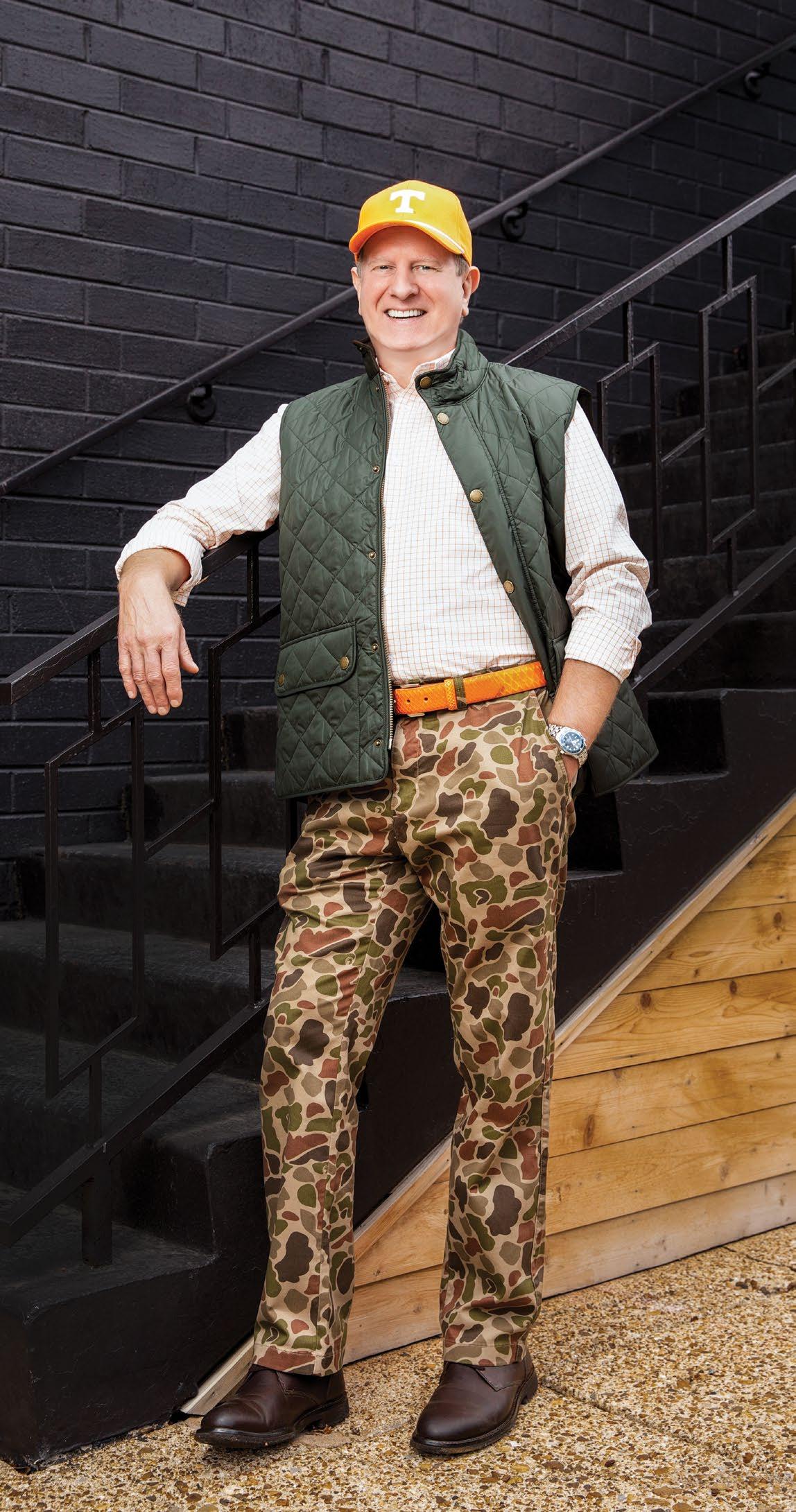
ASK YOUR SMART SPEAKER TO “PLAY US101”

ASK YOUR SMART SPEAKER TO “PLAY WRXR IN CHATTANOOGA”




ASK YOUR SMART SPEAKER TO “PLAY 103.7 KISS FM”


ASK YOUR SMART SPEAKER TO "PLAY 98.1 THE LAKE"



When considering a bag, there are a variety of styles to choose from, from canvas backpacks to leather briefcases and compact cross-body bags. Read on to see which bag may be the perfect fit for your lifestyle.
By Kristen Dee
This roomy bag style is less structured than a briefcase but more professional than a backpack. You can wear it across the body, or with a strap over one shoulder, making it great for commuters. There are options specifically for bikers, and ones that can be adjusted for left or right shoulder carrying. Find an option with several pockets to ensure maximum organization of your items.
Briefcases can add a stylish, practical element to your workday. These can hold laptops of any size in addition to your workday essentials. When choosing the right one for you, consider strap or handle length, room for all your essentials, and durability. Also think about how you’ll use the briefcase most – if you typically just bring your laptop and a few documents to the office, a smaller briefcase may work for you, while a larger briefcase may be better suited for frequent traveling.
Backpacks come in a wide variety of options. To narrow it down, consider the situations you will most often use it in. If you want a versatile backpack that can go from the office to your favorite hiking trails, something waterresistant like a canvas material works well. If you travel often, something roomy with a built-in charger and various storage compartments may be your best bet. If you prioritize style, spring for a handmade leather backpack or a designer brand.
Small cross-body bags like fanny packs provide convenience as you’re able to strap them across your waist, chest, or back, making them great for being on-the-go. They often have dedicated storage compartments for phones, water bottles, wallets, and more for added convenience. This is a great option for those with an active lifestyle.

These bold products will make you stand out from the rest.
PHOTOGRAPHY BY DAN HENRY

Whether you plan to head to the office, are boarding a flight, or are headed to hunt camp, the EJ Backpack can tag along and help carry all of your essentials. As a small run item, you won't meet another person with the same pack. So stand out, wherever you are headed next.
Chattanooga Leather Works
This wooden pocketknife is made from barrel stave wood from a Pappy Van Winkle barrel. Why just drink your bourbon when it can also be an impressive accessory?
Fink’s Jewelers
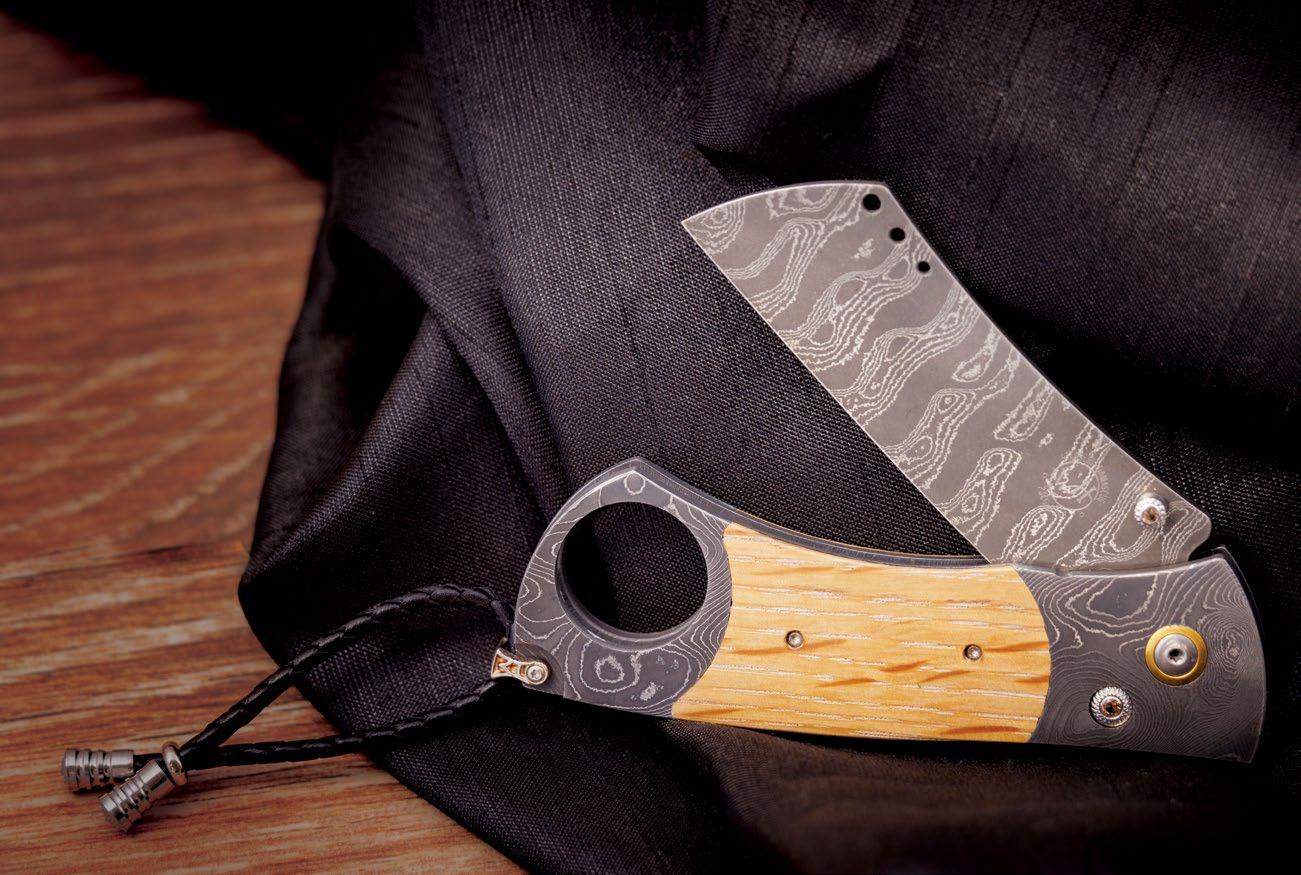

Hawk Gola suede shoes are a sleek, contemporary sneaker that blends style and comfort for a modern, fashionable look. Chattanooga Shoe Company












Made for the man who values quality in every detail. For the modern beardsman who knows it's all in the care.
Chattanooga Beard Co.
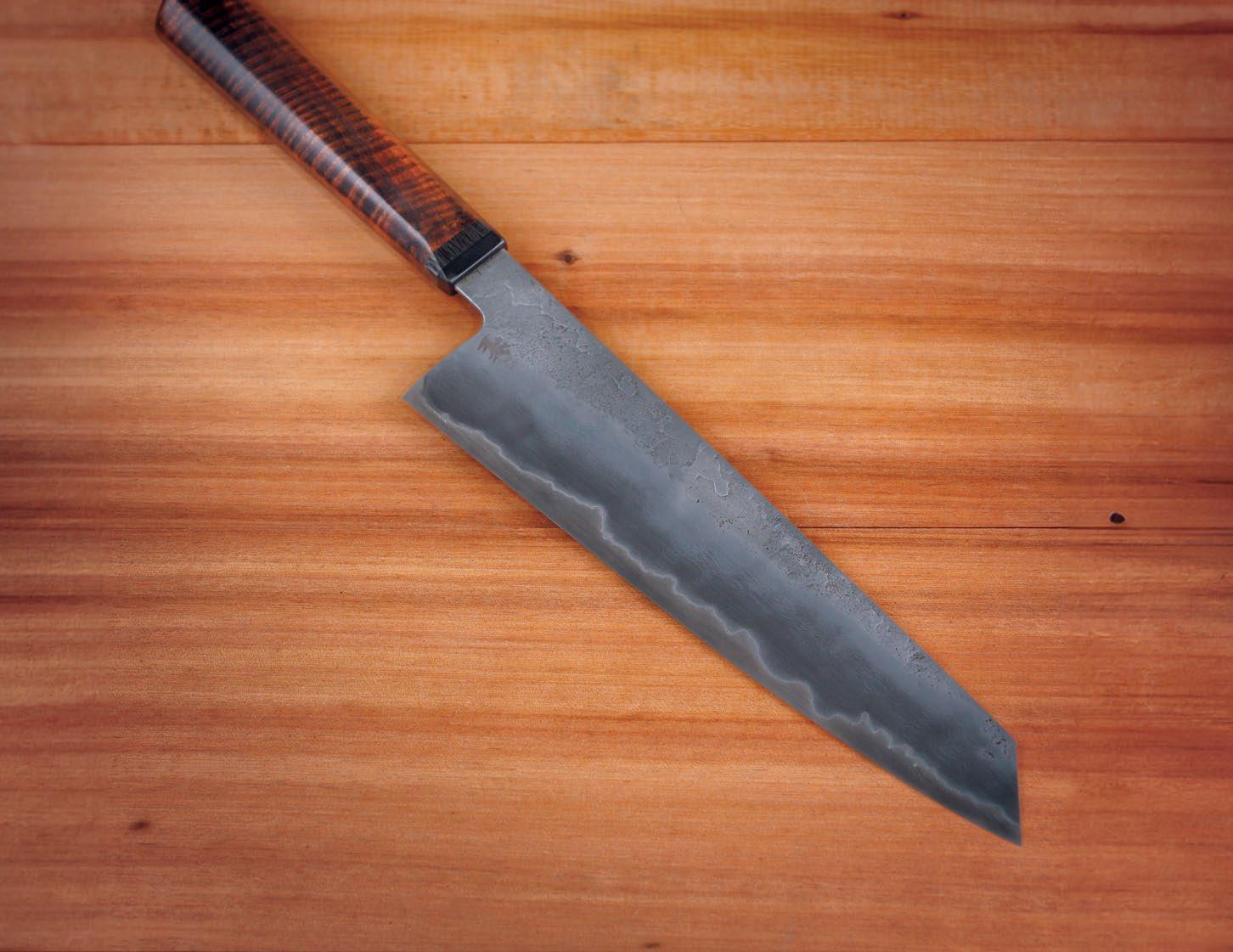
This 9” Gyuto knife is hand-forged from in-house made steel and Ringed Gidgee wood for the ergonomic Wa handle, reflecting unparalleled craftsmanship. A serious knife for serious chefs.
Six Ear Knife and Tool

In stock now, this elevated and luxurious Patek Philipe watch is fit for the true watch enthusiast. As the last family-owned watch manufacturer in Geneva, this watch is one-of-a-kind and fit for a true Southern Gentleman.
Brody Jewelers
Being a modern gentleman isn’t just about dressing well and knowing which fork to use at a dinner party, so we asked The Gentleman to chime in and answer your most pressing etiquette questions. Here’s his expert advice on everything from remote work etiquette to thankyou cards.
This upcoming holiday season, my wife and I have decided to slow down and do things differently. How can I express to my extended family that we won’t be participating in certain holiday traditions this year?
Ah, traditions. Traditions are the heartbeat of many Southern families, but the ability to embrace change gracefully is the mark of a true gentleman. In this situation, an in-person conversation or phone call may be received better than a casual text. Be clear about how your holiday plans are changing this year, but remember to show respect for the traditions you’ll be missing out on. An extra dose of care and consideration will go a long way.
I recently started freelancing full-time and am looking forward to working remotely from local coffee shops and coworking spaces. What should “office” etiquette look like for remote workers?
When working remotely in public spaces, preparedness and professionalism are essential. If you opt for a coffee shop, it’s generally an unspoken rule that you will make a purchase that correlates with the amount of time you plan to remain in the store. Be sure to pack earbuds or headphones to block out ambient noise, and consider moving outside during any virtual meetings or phone calls to avoid disturbing other patrons. Additionally, be mindful of other remote workers around you. Some might be open to networking or small talk, while others may desire to work quietly and keep to themselves.
I would like to build a new office wardrobe that feels professional without sacrificing my personal style. Any advice?
Professional attire tends to avoid trends and adhere to stricter dress codes, but a touch of personal style is a great way to set yourself apart in an office setting. I recommend you begin by reviewing your company’s policy on dress code. Once you know any requirements or restrictions that apply, use those guidelines to experiment with new cuts, colors, patterns, and textures. Keep your look polished with well-tailored pieces, and don’t forget the importance of classic accessories like belts, watches, and ties.
One of my close friends sent me an incredibly kind gift for my birthday, and I would like to send him a handwritten card in response. Any tips for writing a memorable thank-you message?
A thank-you card, eh? I like your style. Handwritten notes have become a lost art in this day and age, but they remain, in my humble opinion, one of the most thoughtful ways to express gratitude. My advice is to keep your message sincere and succinct. Be specific about what your friend’s gesture means to you, and don’t shy away from reminding him of the value of his continued friendship.
My spouse and I love to host dinner parties, but we have a couple of friends who tend to linger later into the evening than we expect. What’s the best way to let a guest know they have overstayed their welcome?
Good communication makes all the difference when it comes to setting boundaries with friends. Before your next dinner party, make sure to share clear information about when the party will begin and end. If you find that guests are still lingering later than you wish, provide subtle cues for them to notice. Begin lightly tidying the space, or turn off the music. If your guests still don’t realize it’s time to go, express gratitude for their company and politely let them know the evening’s festivities have come to a close.
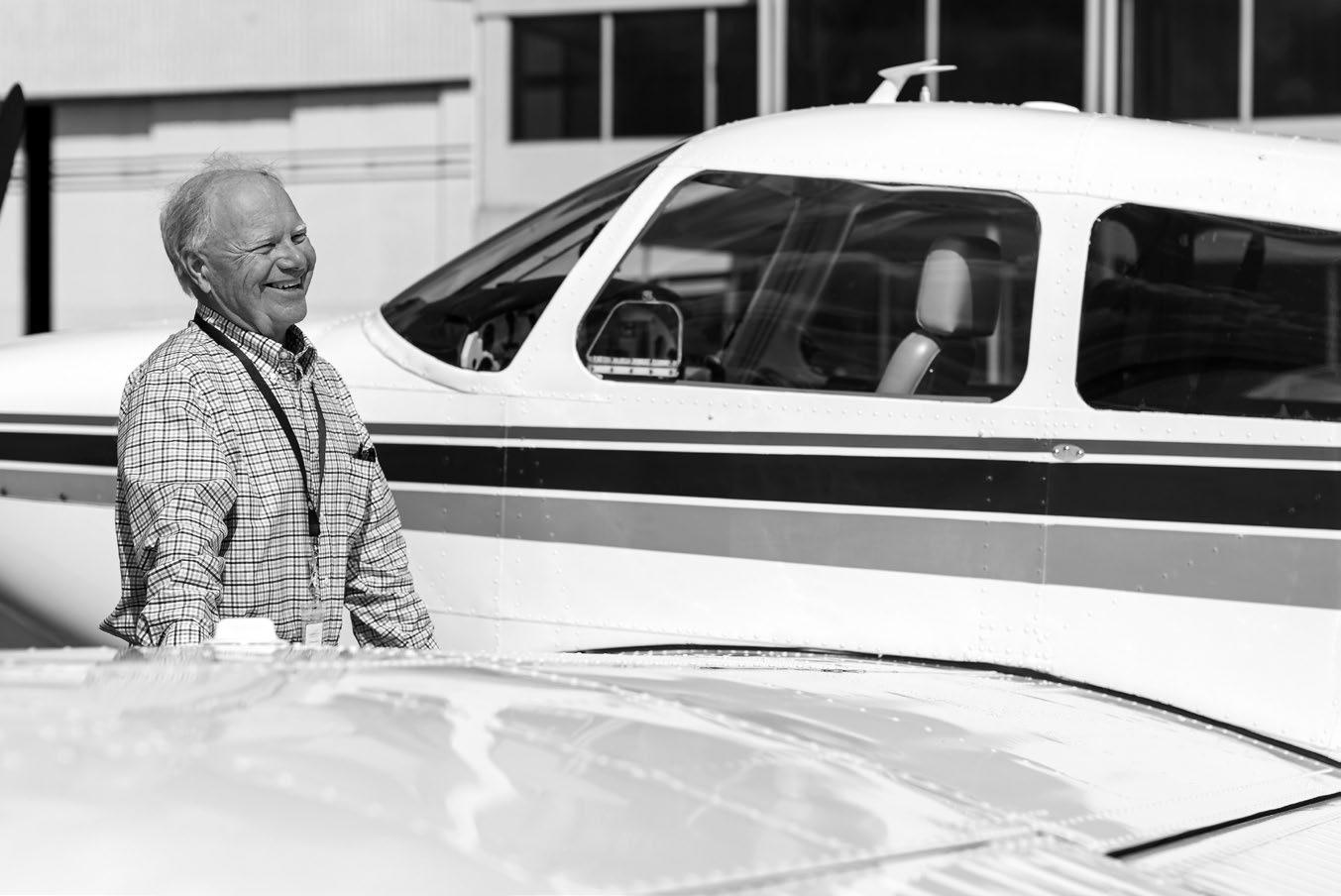
“Keep your face always toward the sunshine, and shadows will fall behind you.” – Walt Whitman

The Newest Addition, 5090 Outdoor
Immerse yourself in the truly unique experience that is 5090 Outdoor, where the beauty of nature harmoniously blends with premium outdoor furnishings. Our outdoor deck, overlooking the serene Spring Creek, offers a tranquil setting that will inspire your outdoor living dreams. Admire our lush landscape in full bloom while enjoying a round of golf on our custom putting green. As the sun sets, our collection of fire pits will blaze, keeping you warm as you build the patio of your dreams.

FRIDAY, SATURDAY, & MONDAY 10 AM – 8PM
SUNDAY 12PM – 6PM
THURSDAY 10AM - 5PM
TUESDAY – WEDNESDAY BY APPOINTMENT
At 5090 South, we’re more than just a furniture store – we’re a destination of style, sophistication, and inspiration. Stop by our showroom and step foot into a world where design meets desire, and where your dream home comes to life.
DESIGN YOUR DREAMS WITH THE 5090 DESIGN CENTER
The 5090 Design Center is your gateway to a world of endless possibilities. Our team of talented designers is here to turn your vision into a reality. With expertise and an exquisite array of highquality product lines, you can create a living space that reflects your unique style. Customize every piece by choosing from an extensive collection of fabrics, textures, and finishes to craft a look that’s exclusively yours.

423-468-5090 | 5090SOUTH.COM
